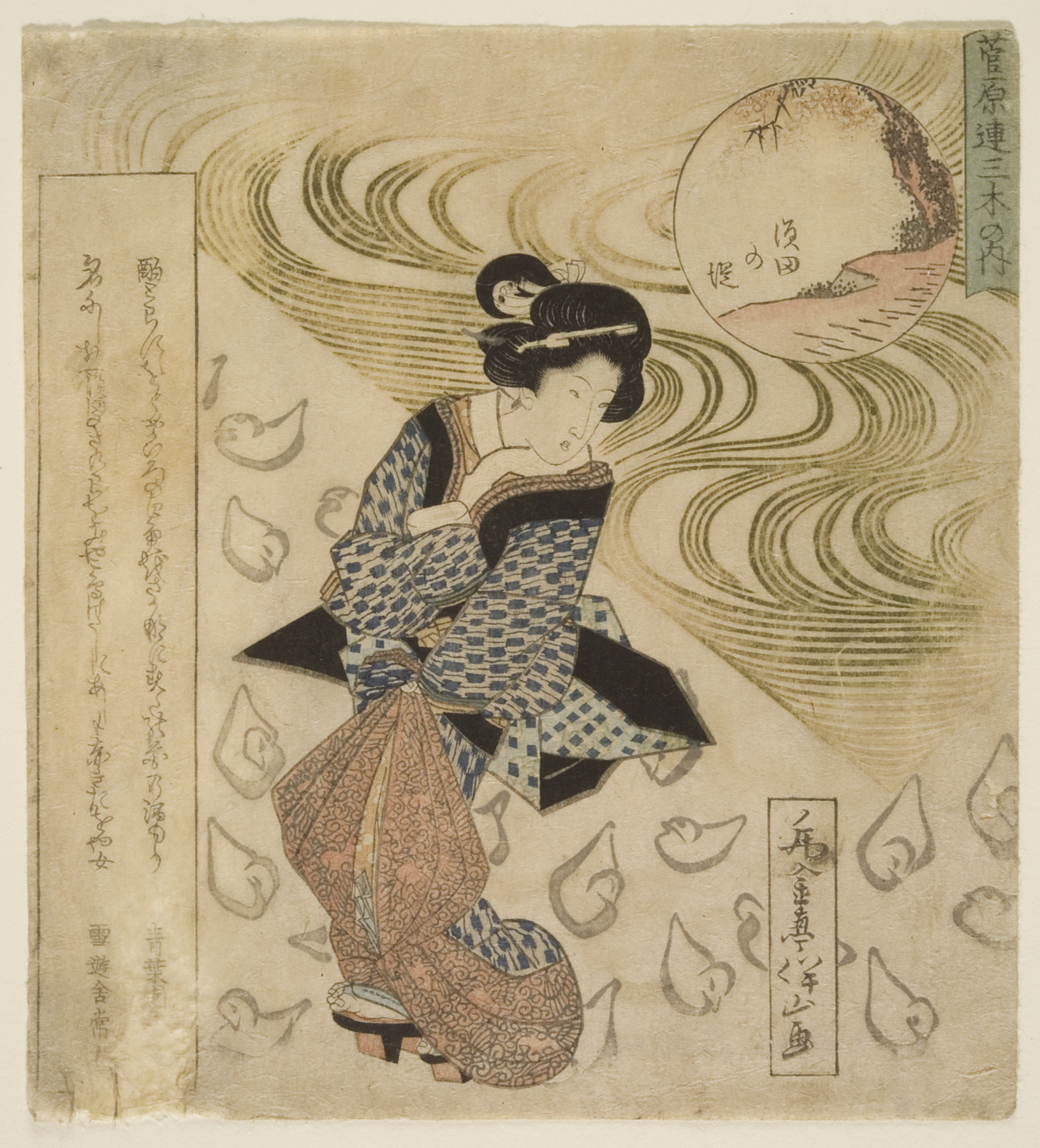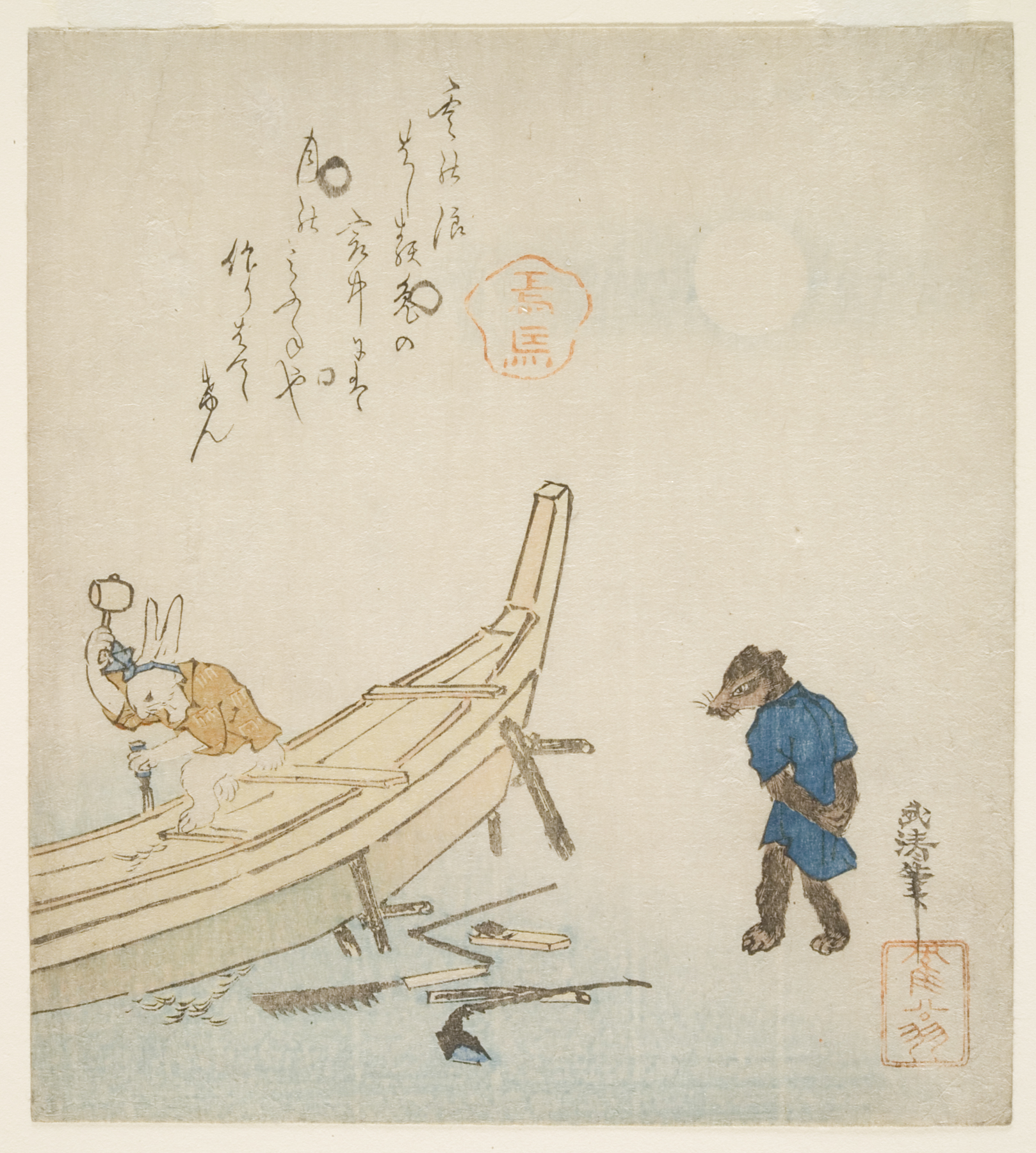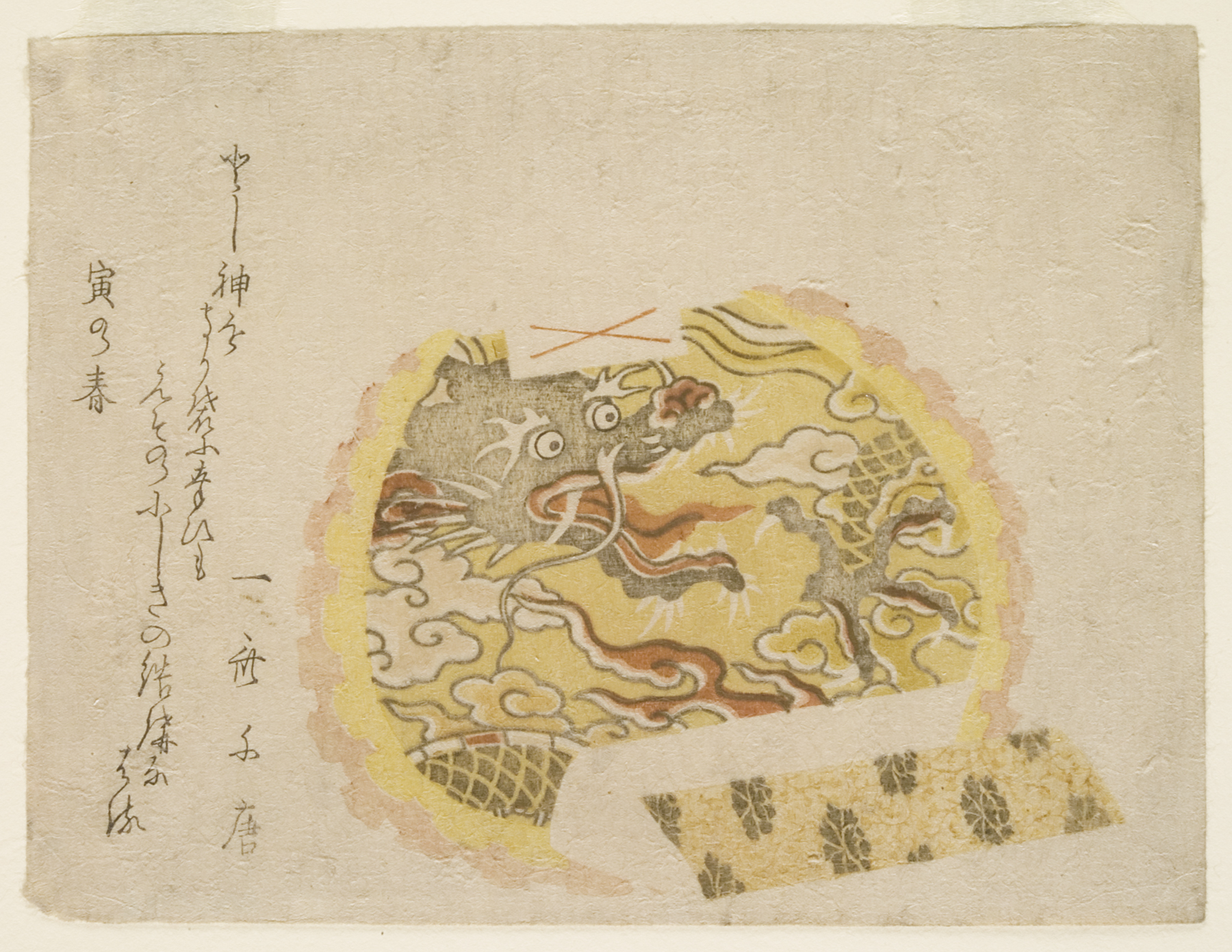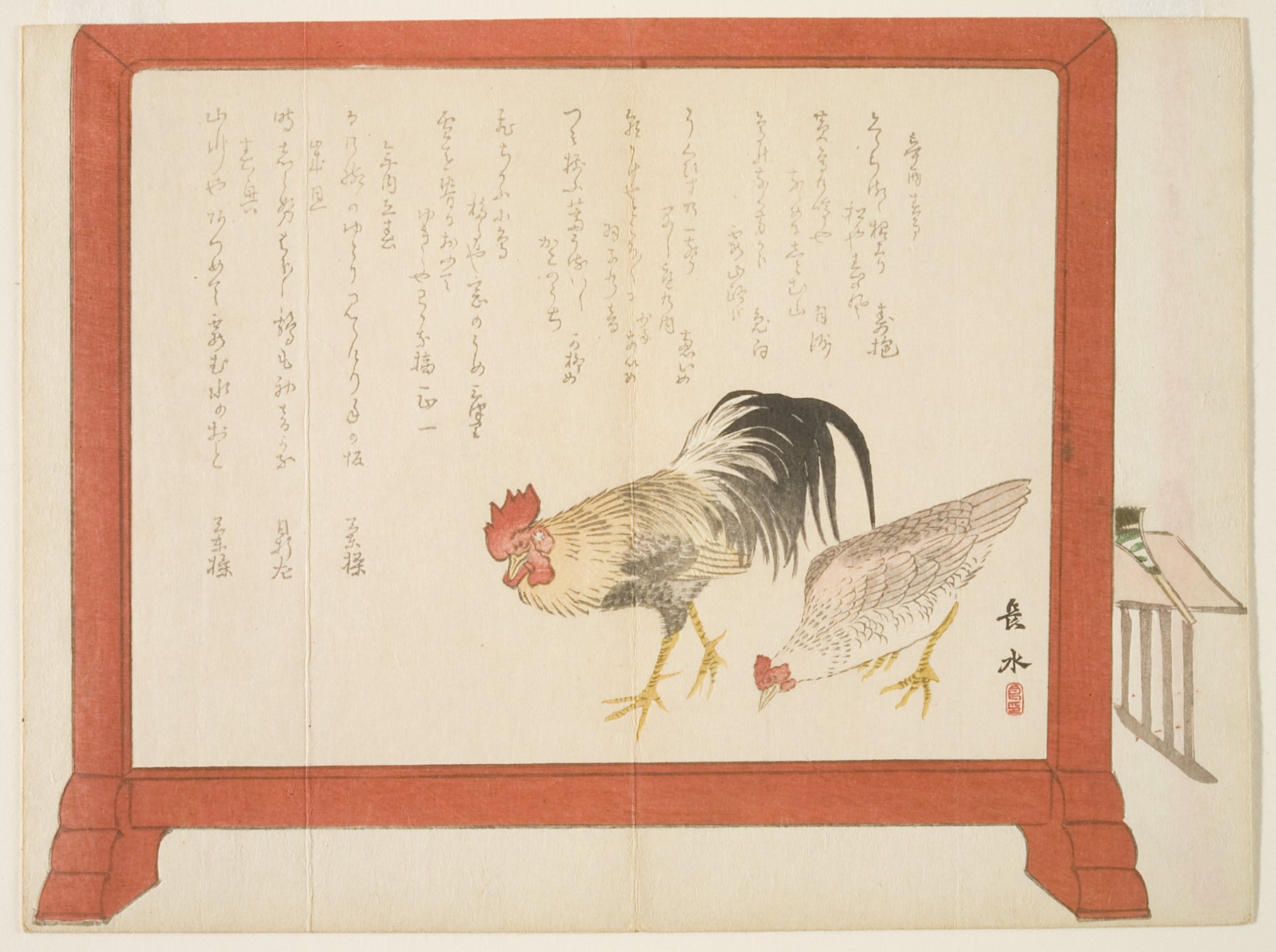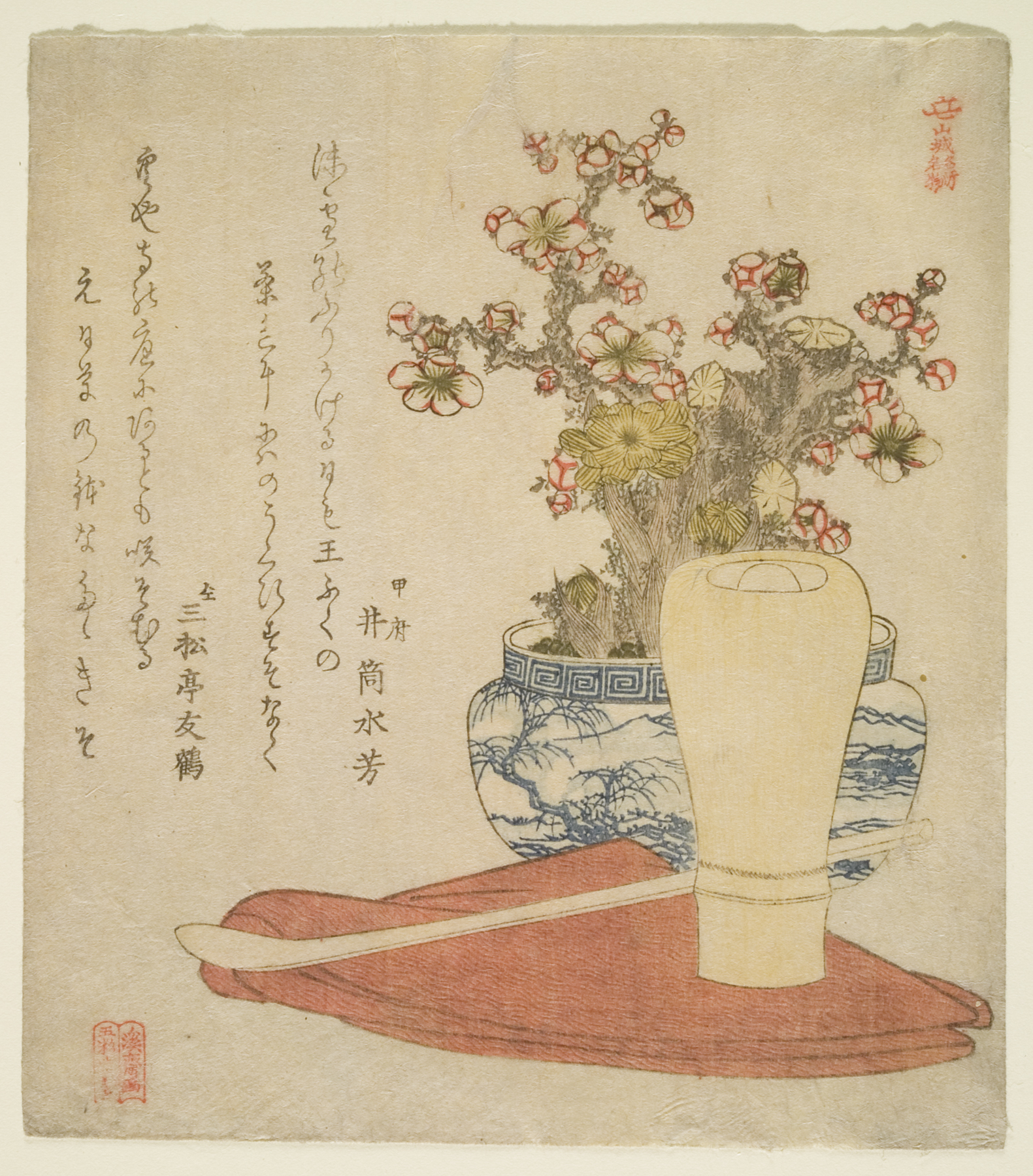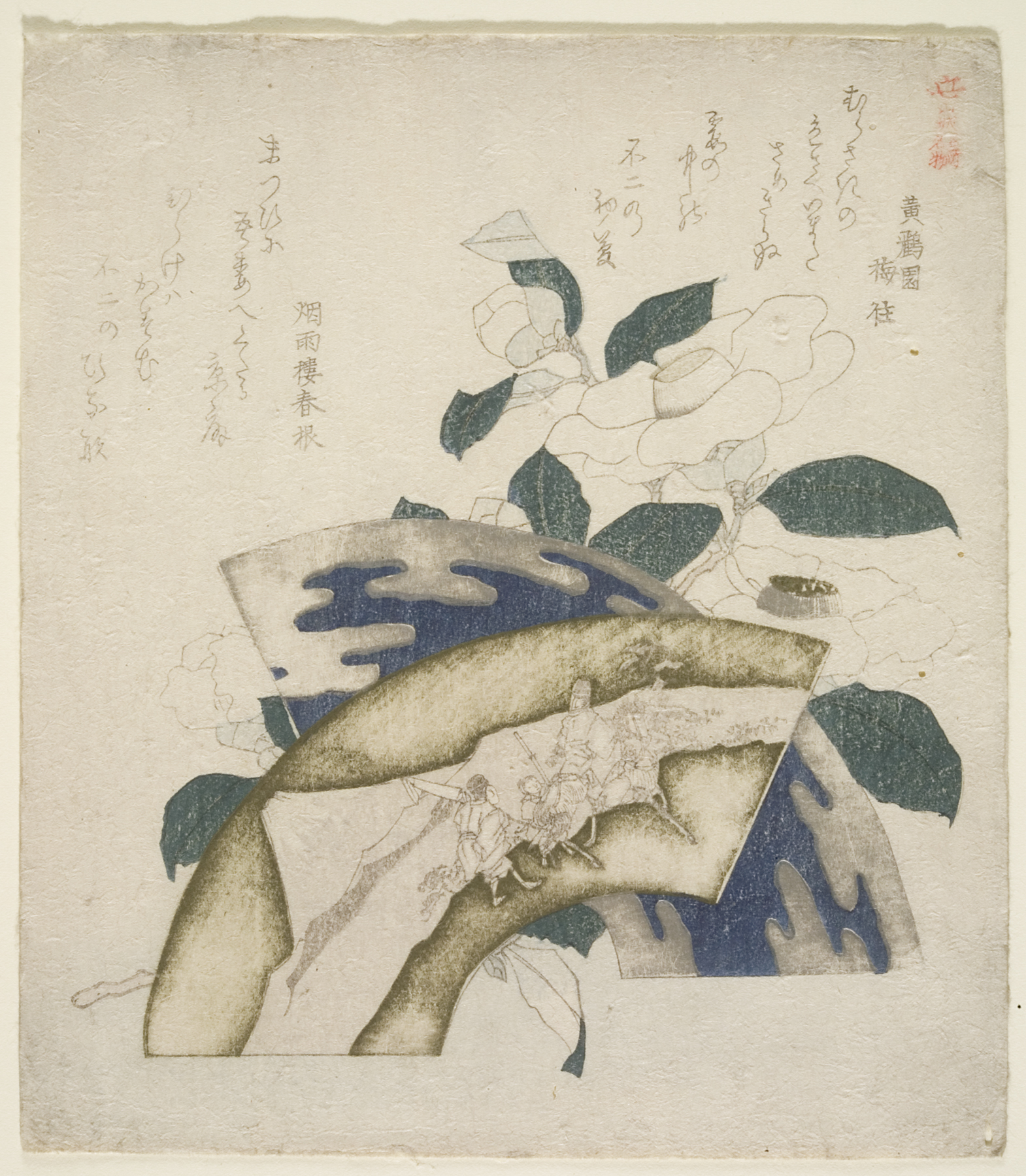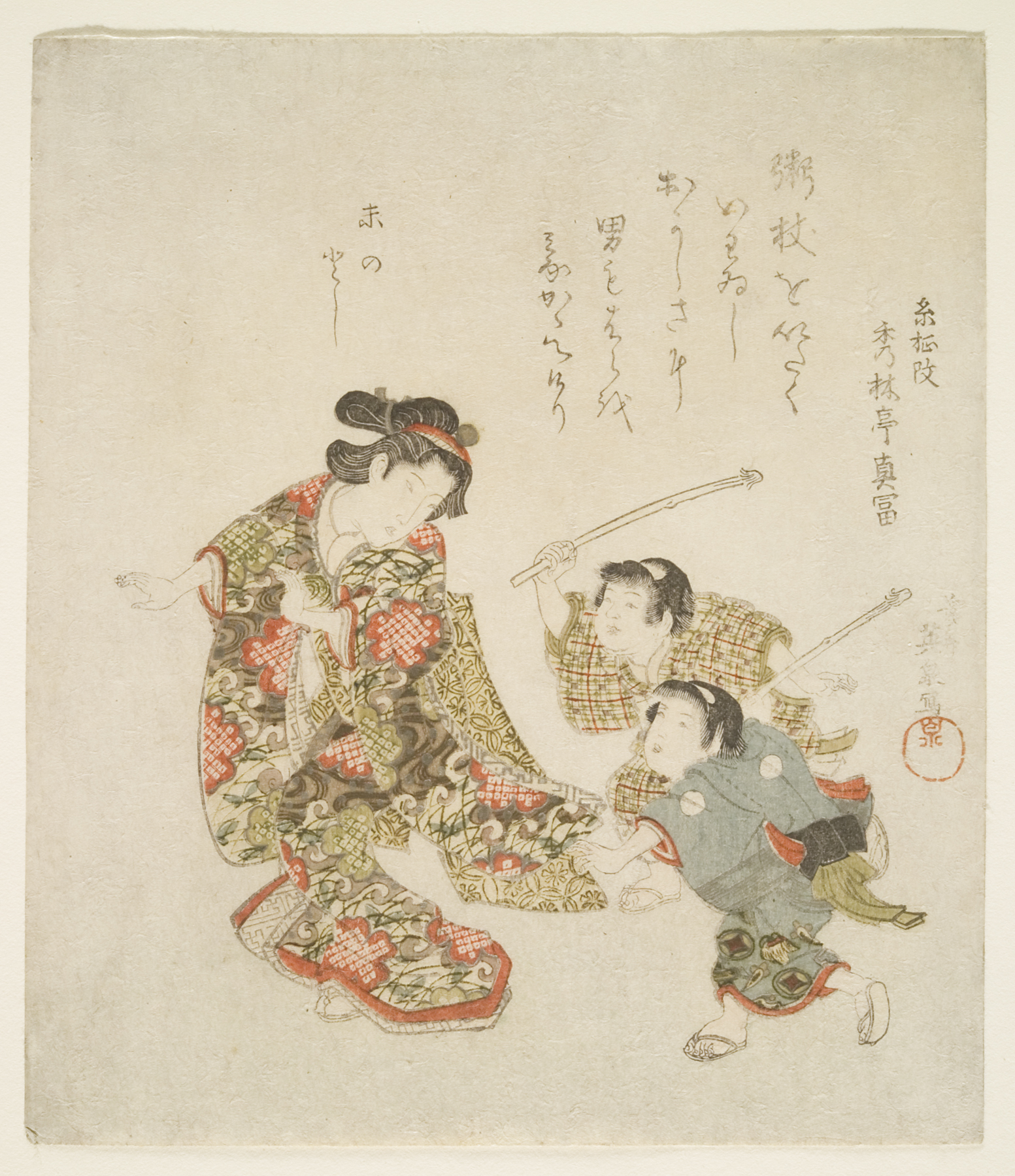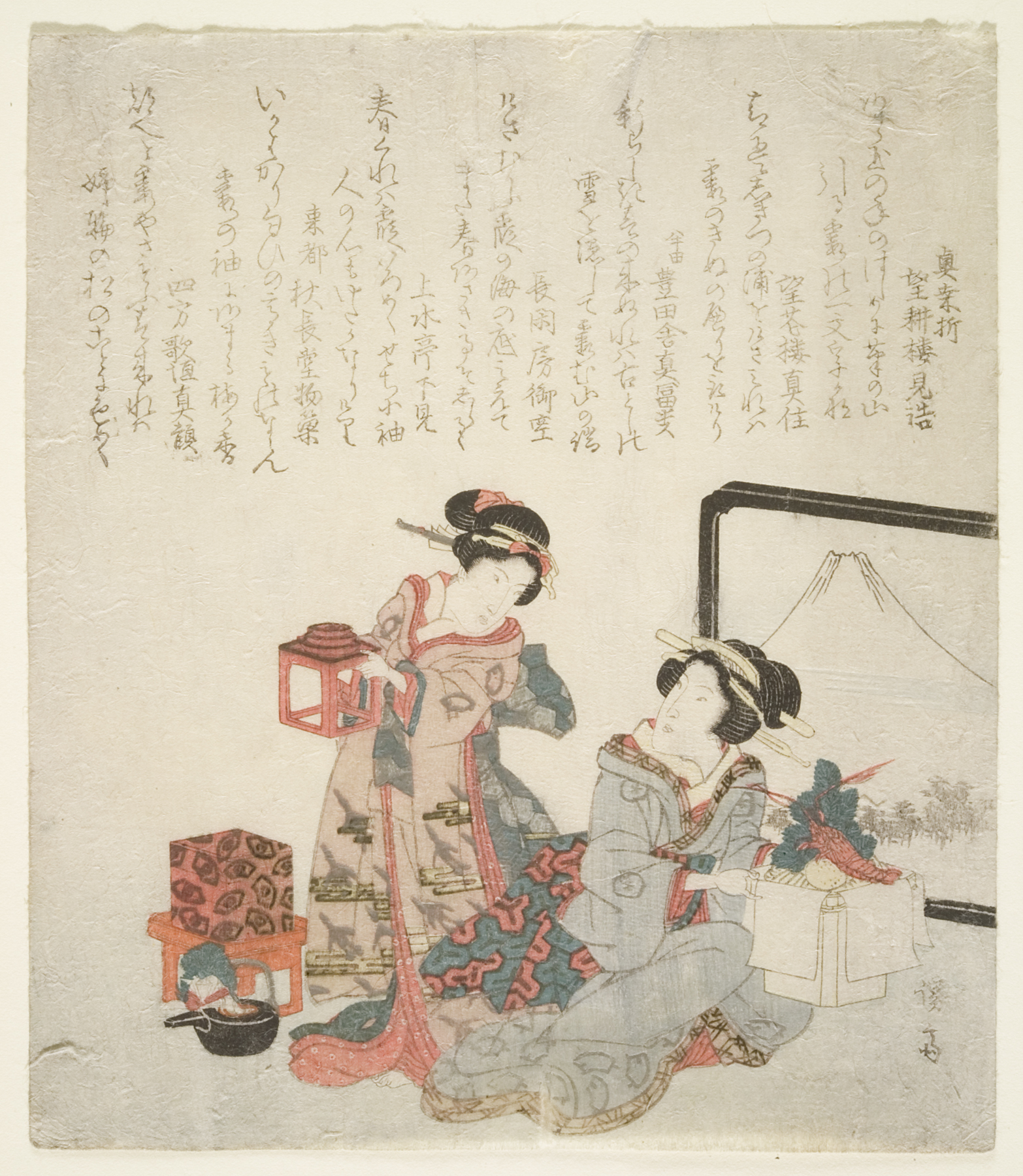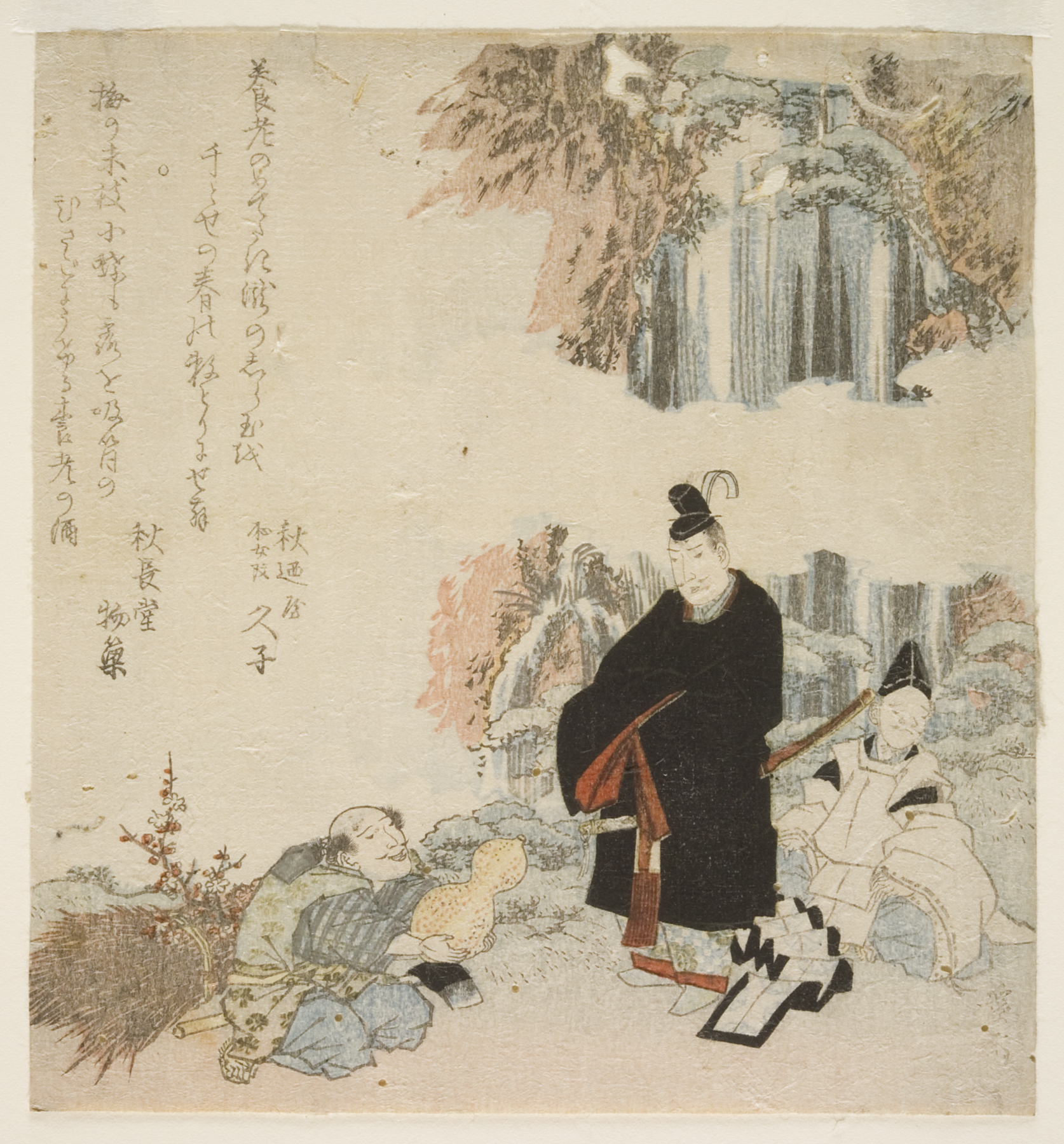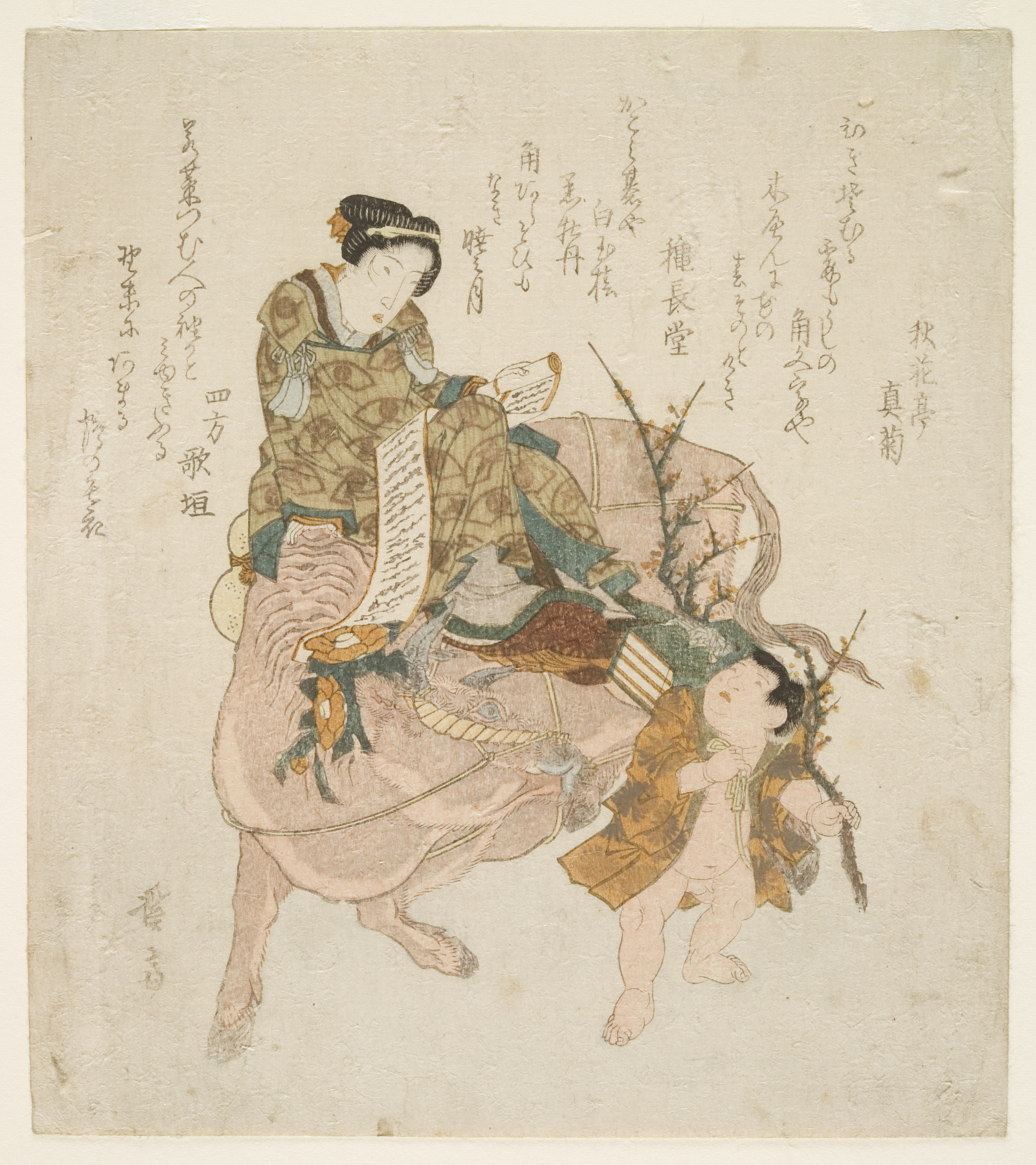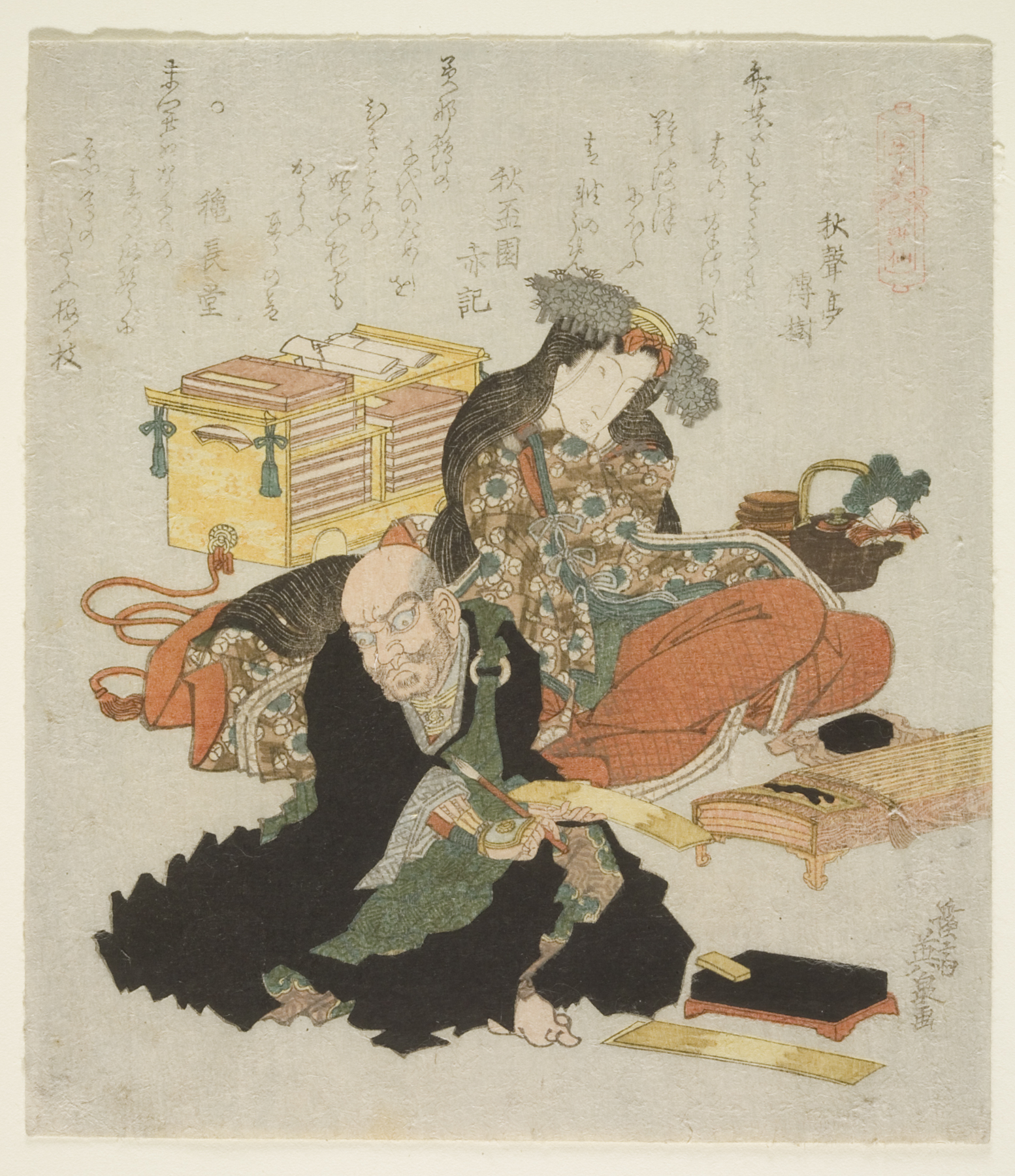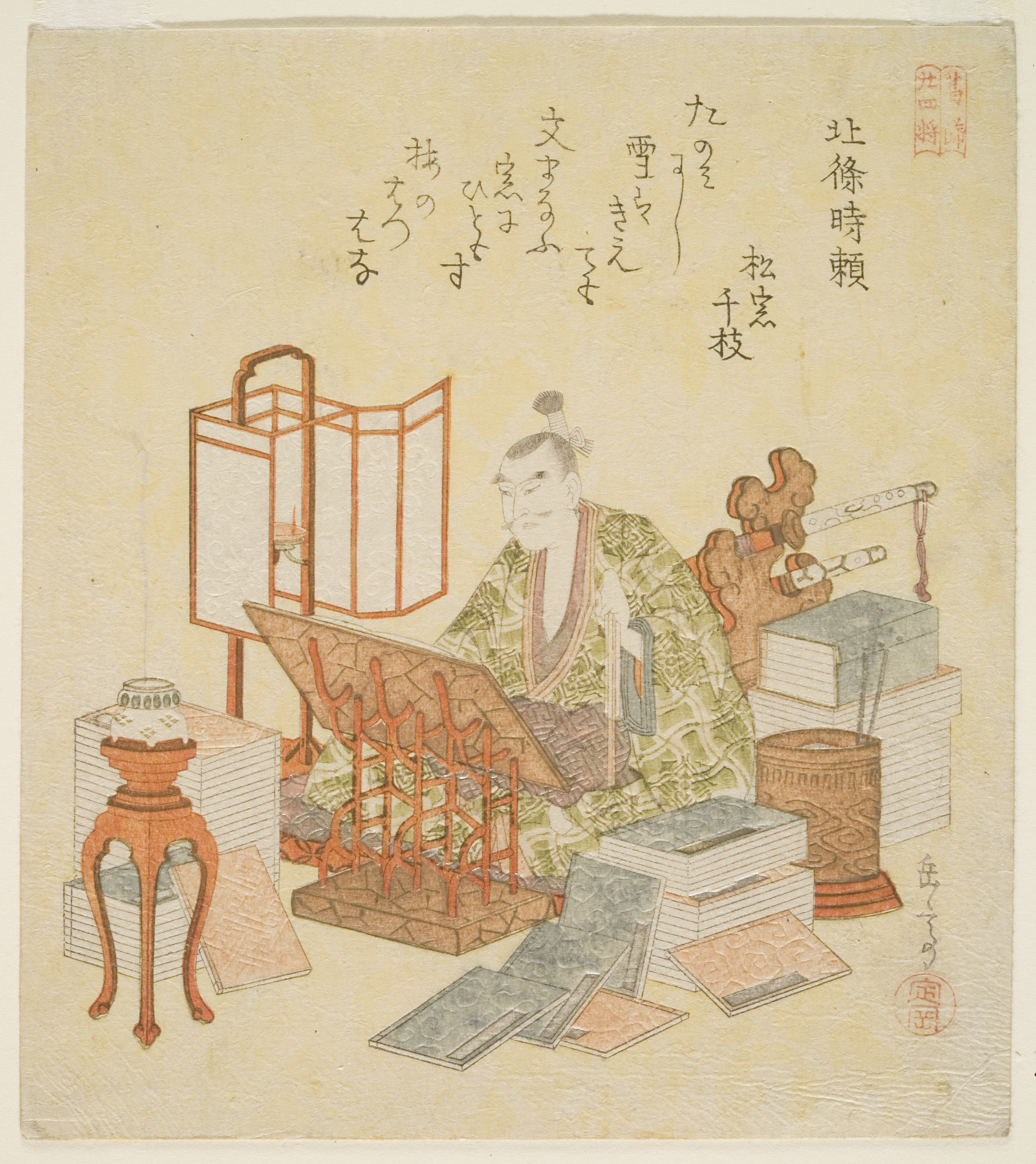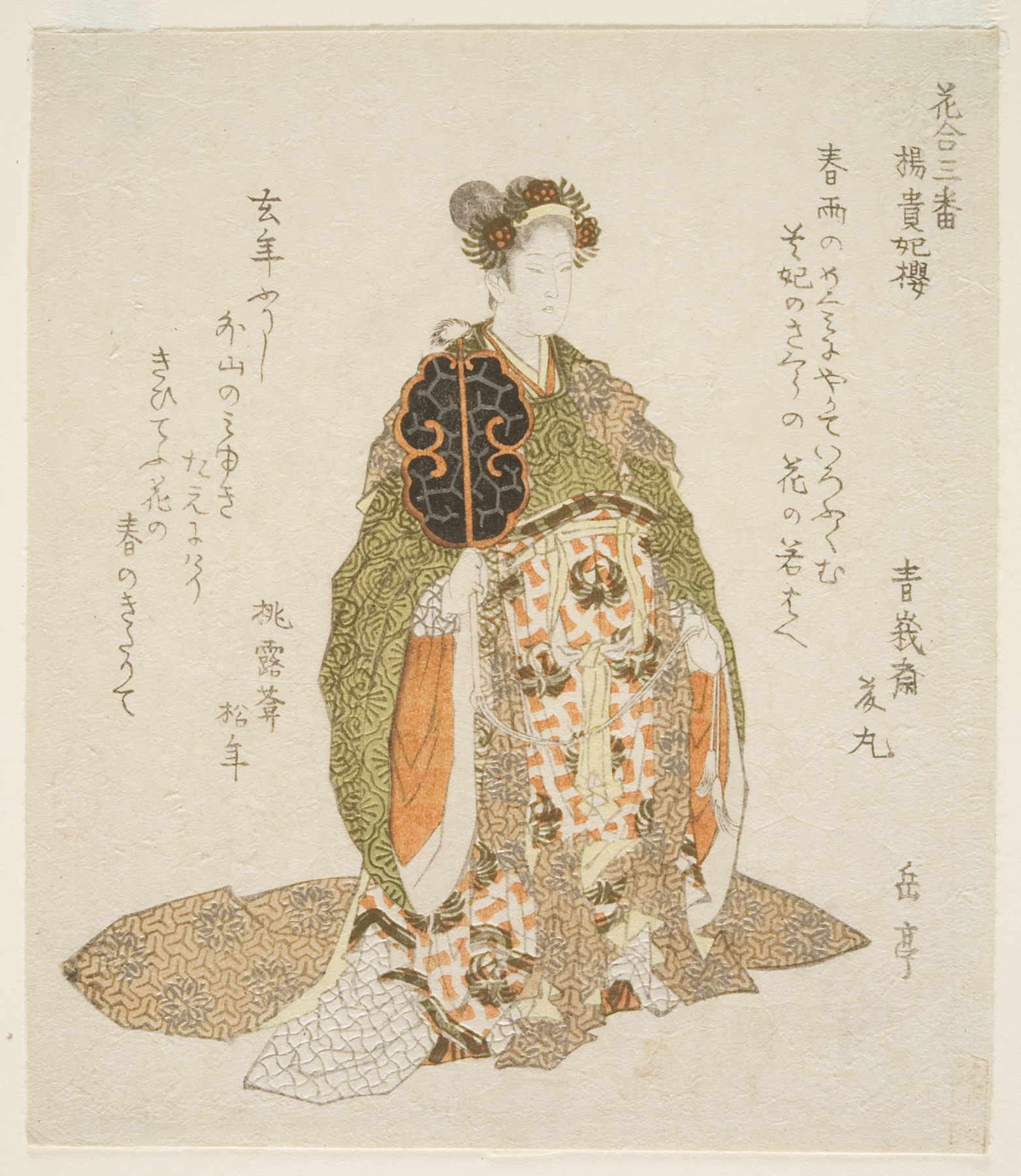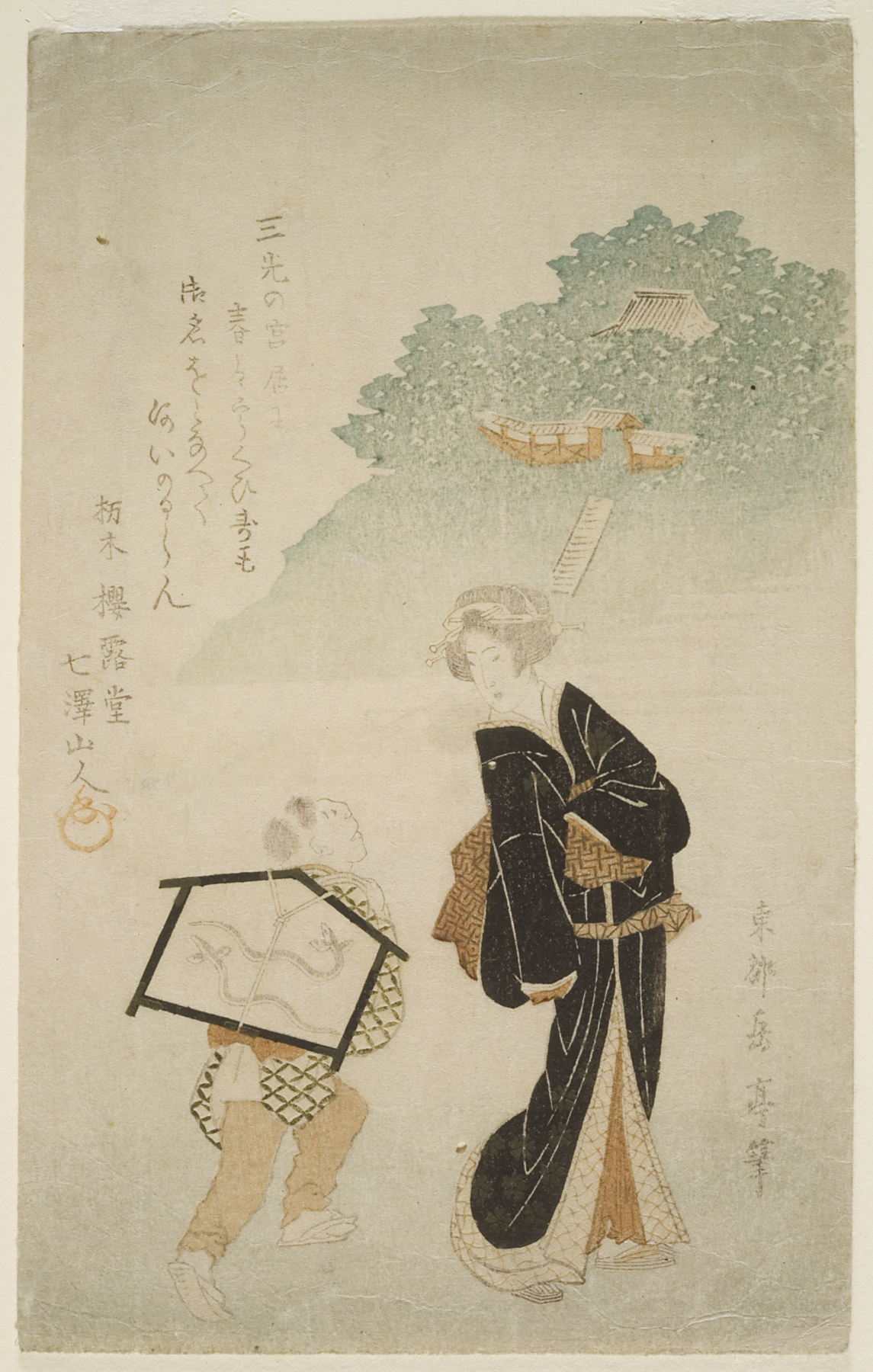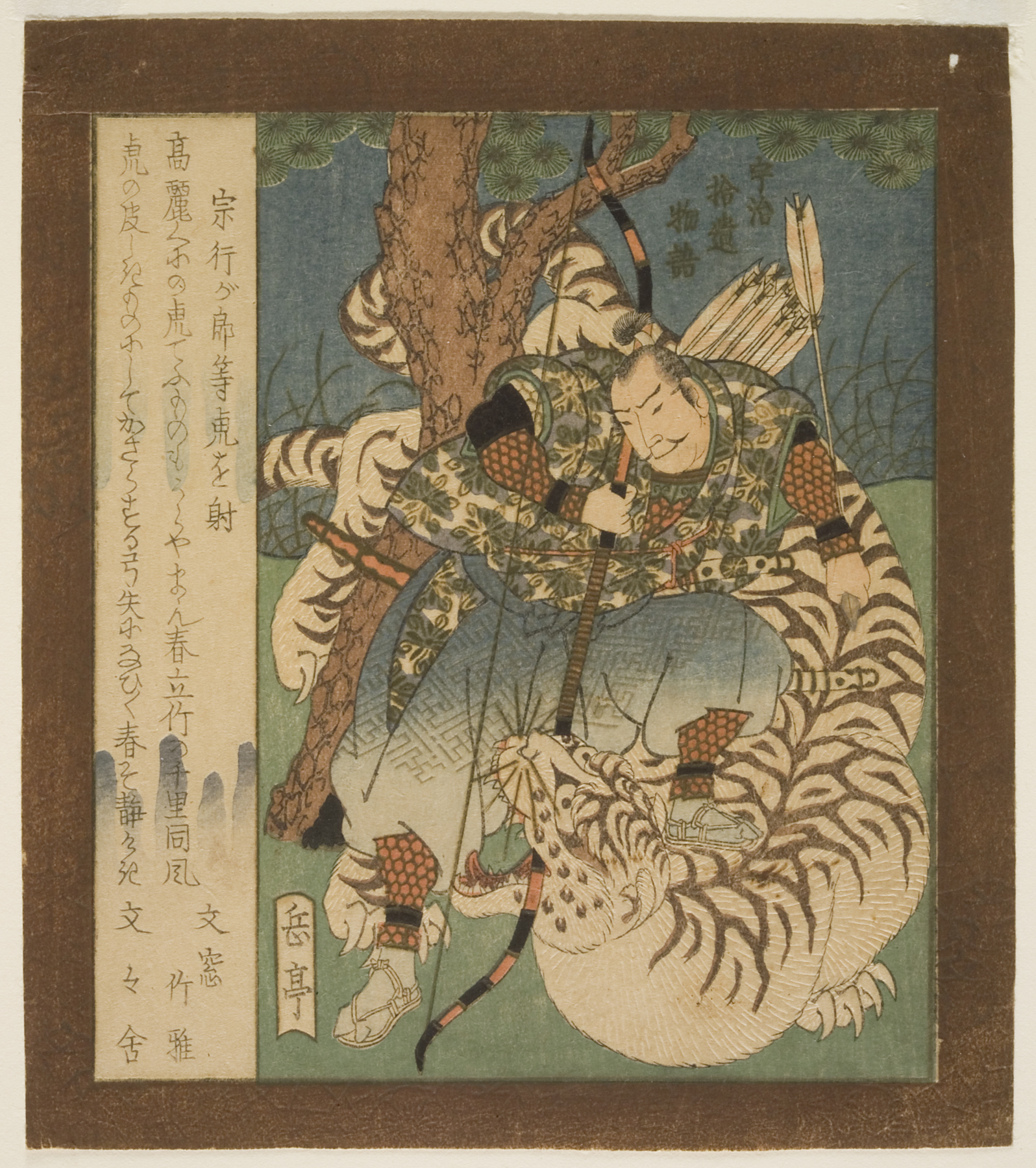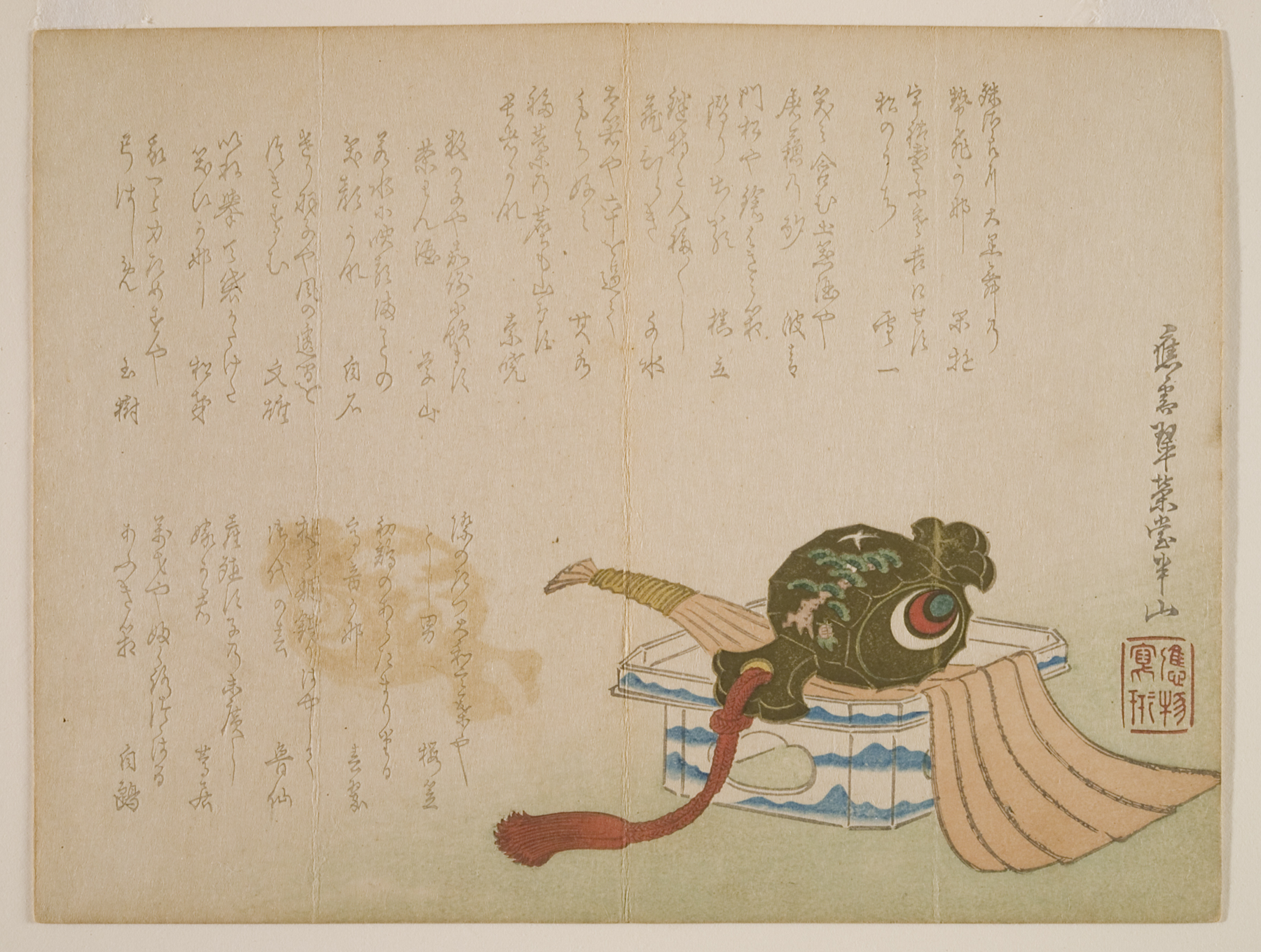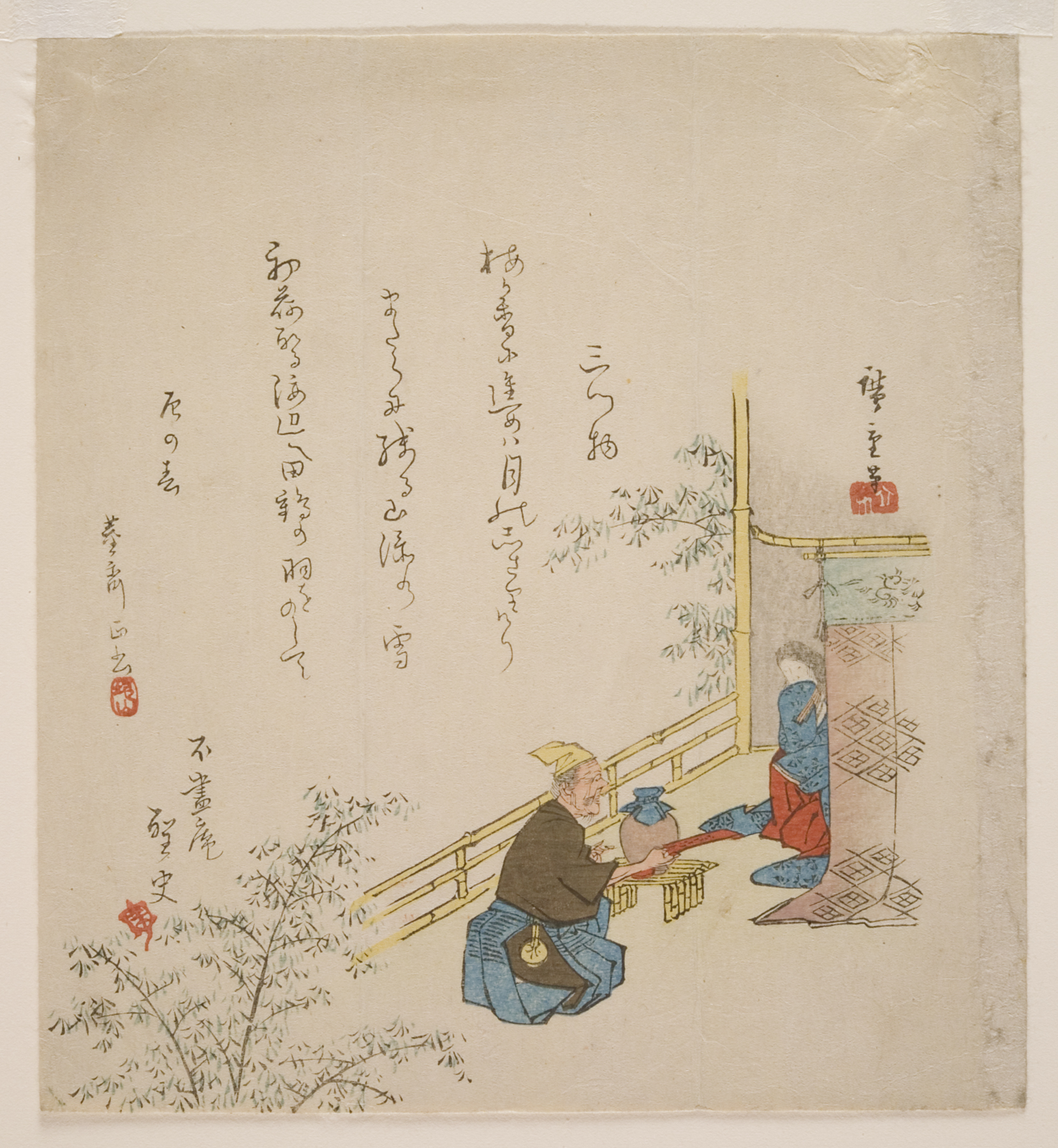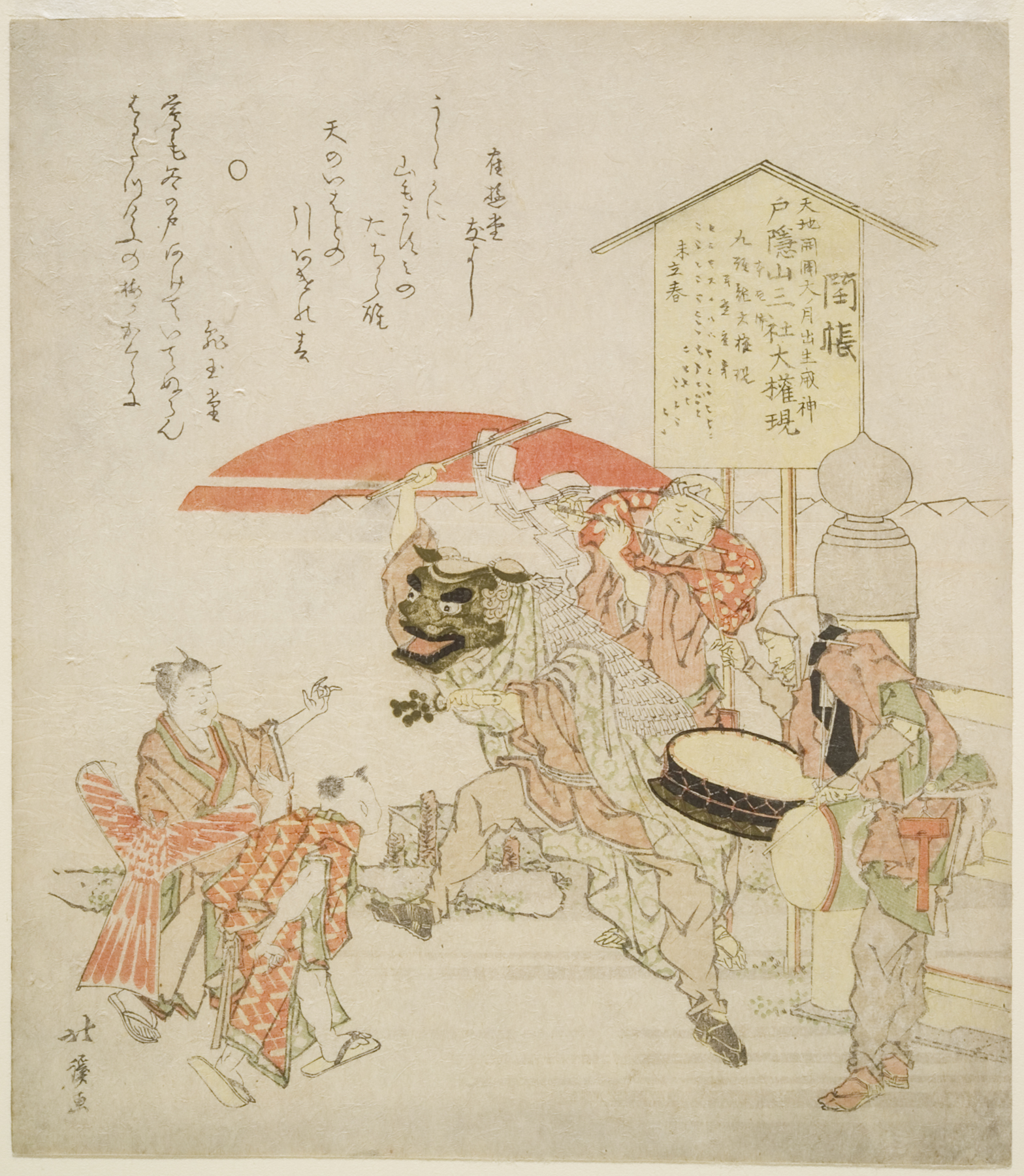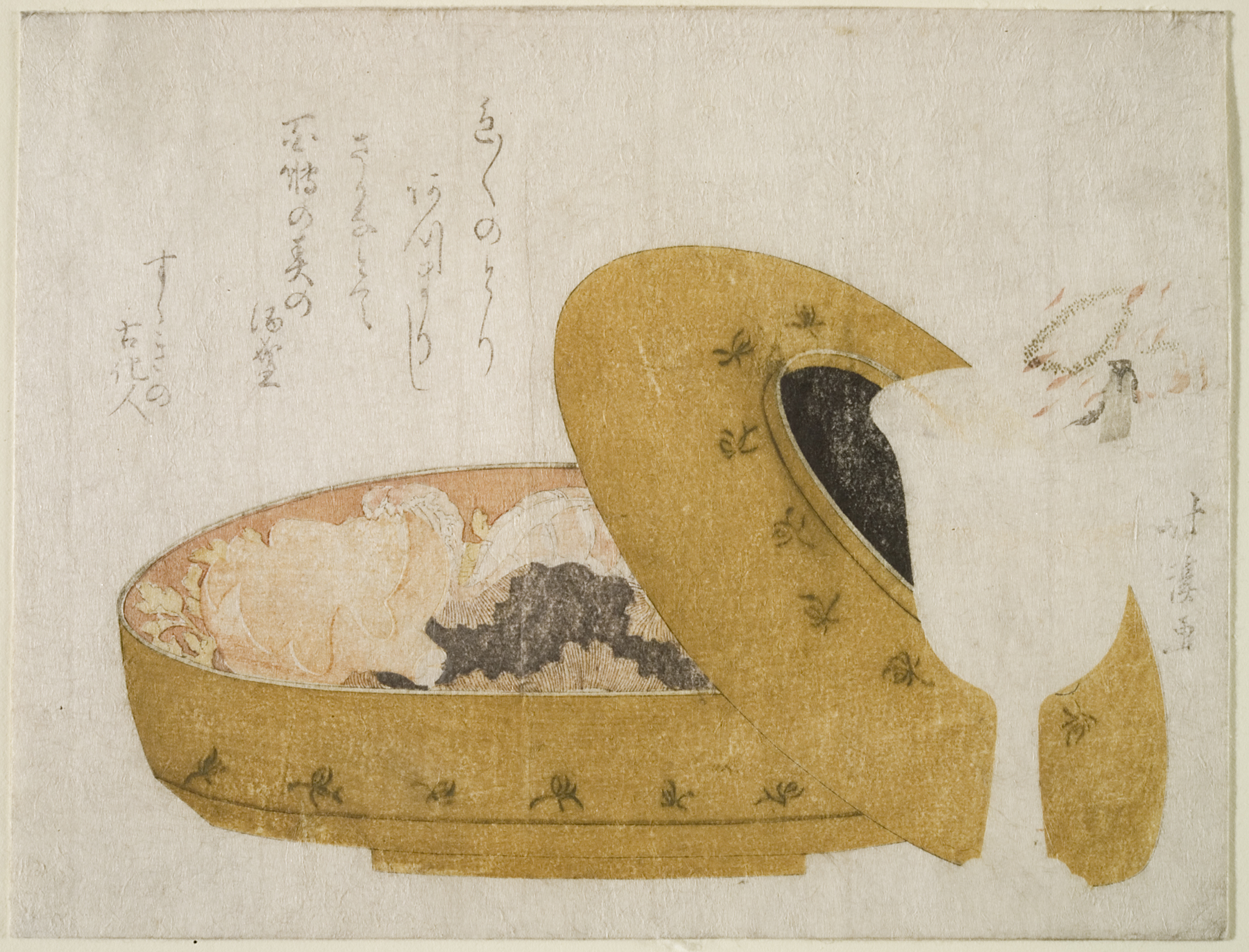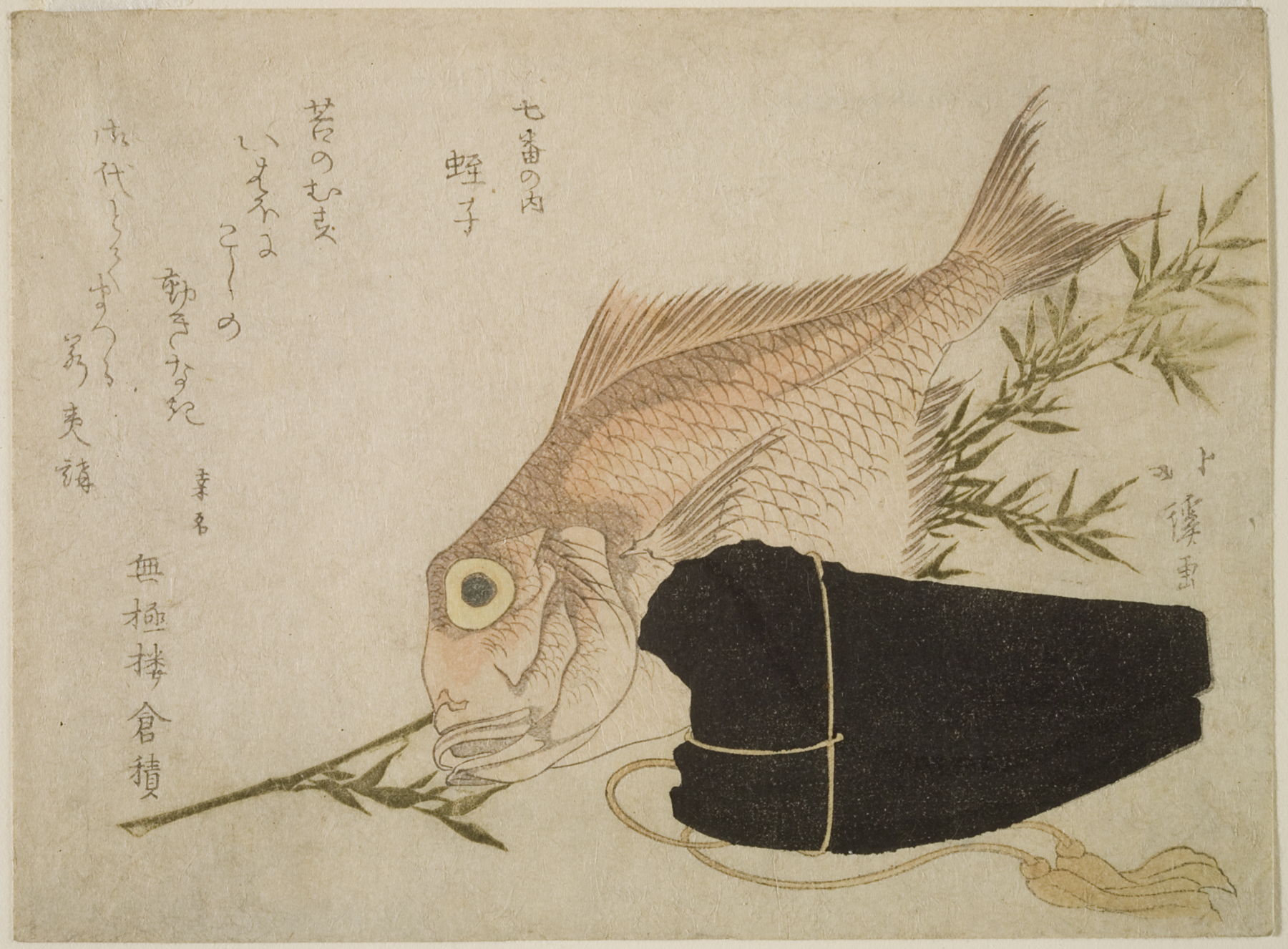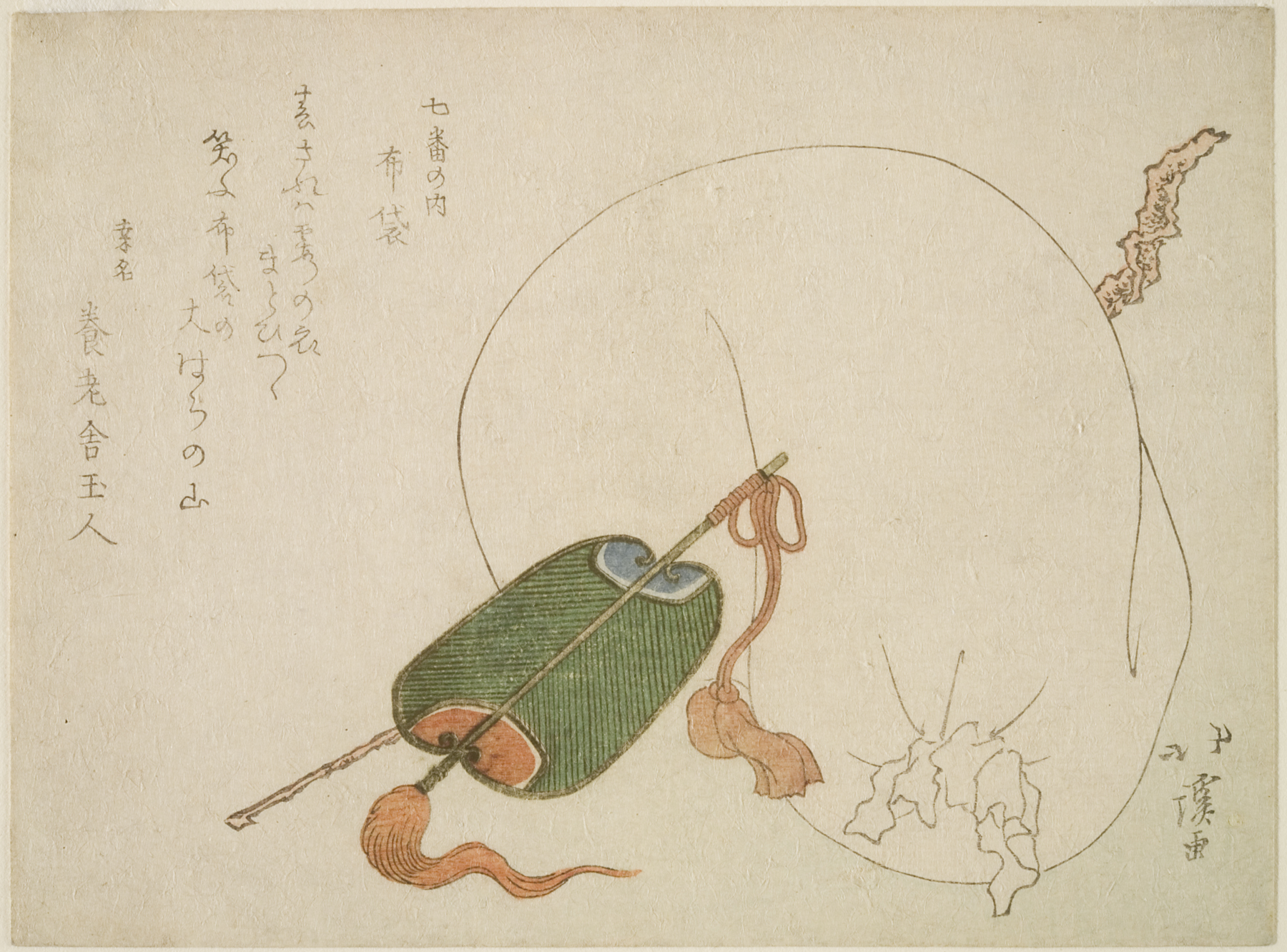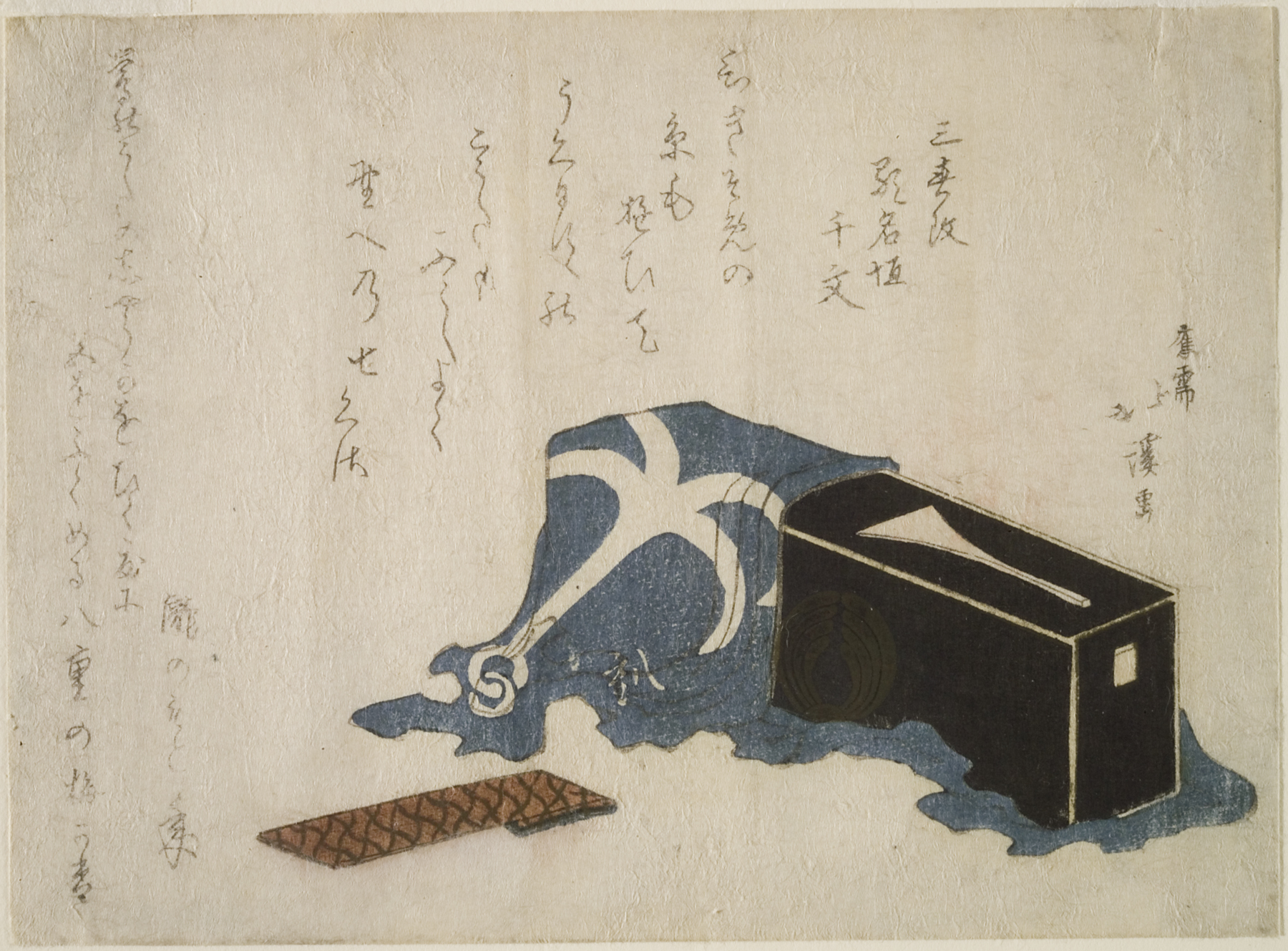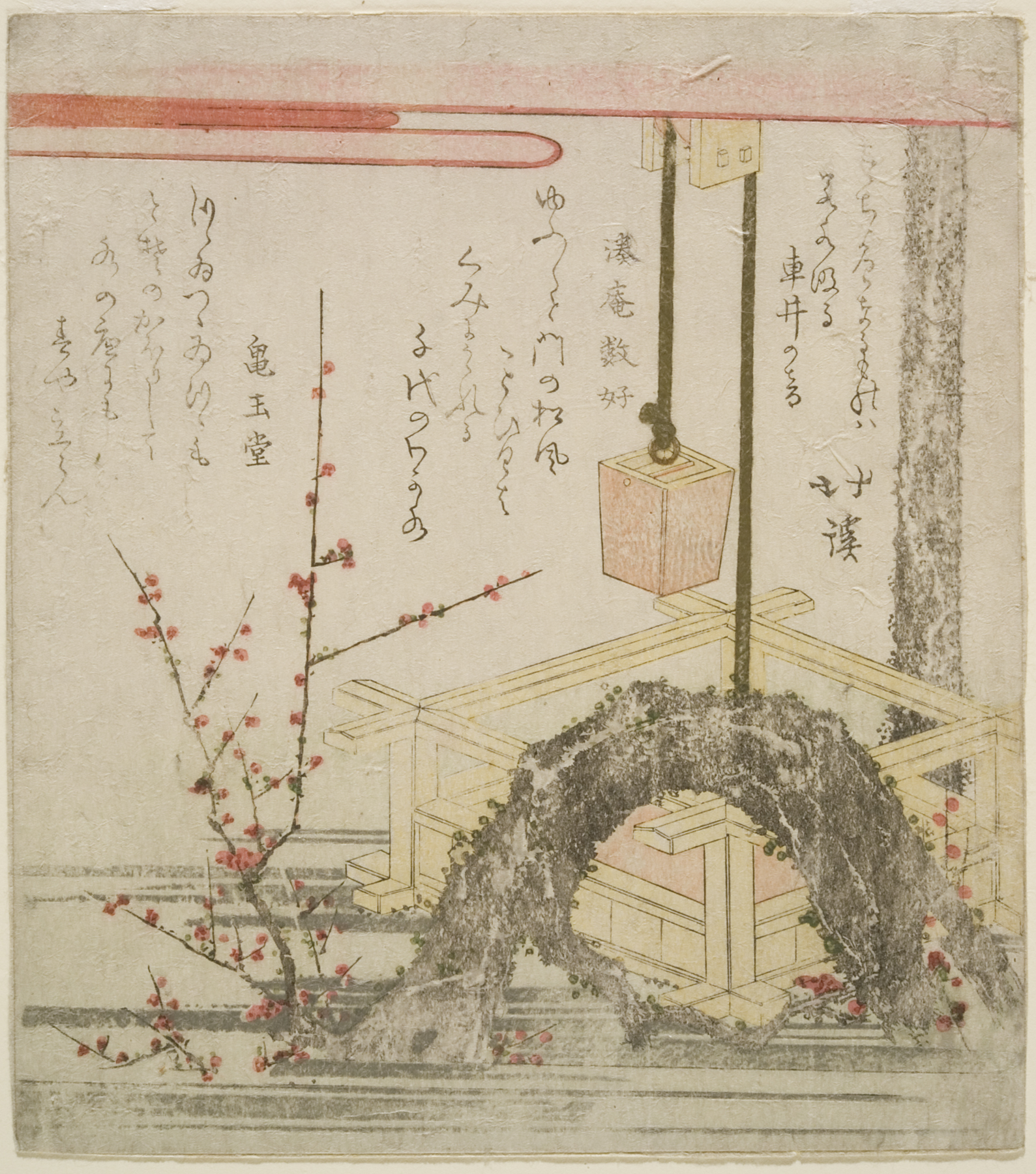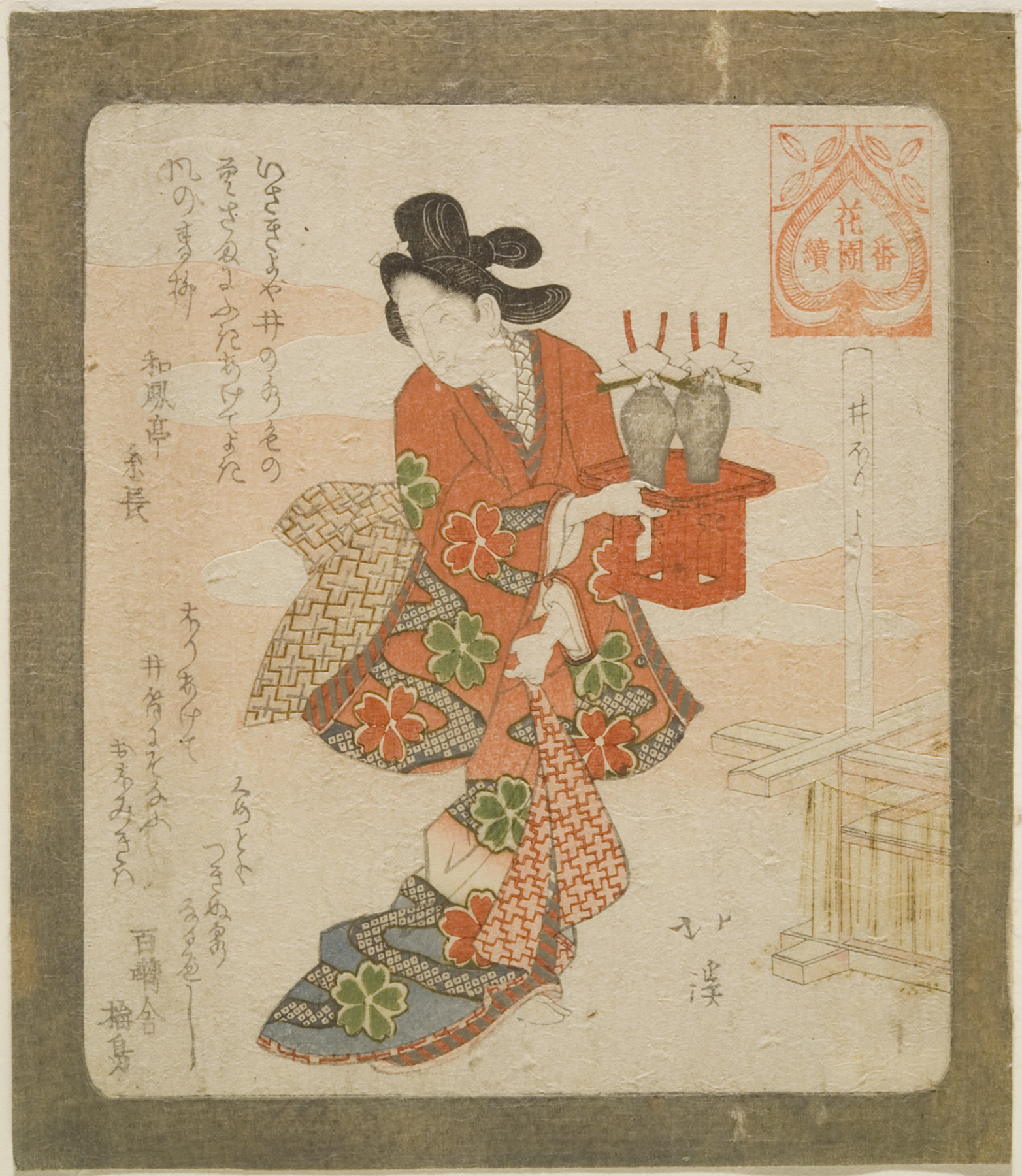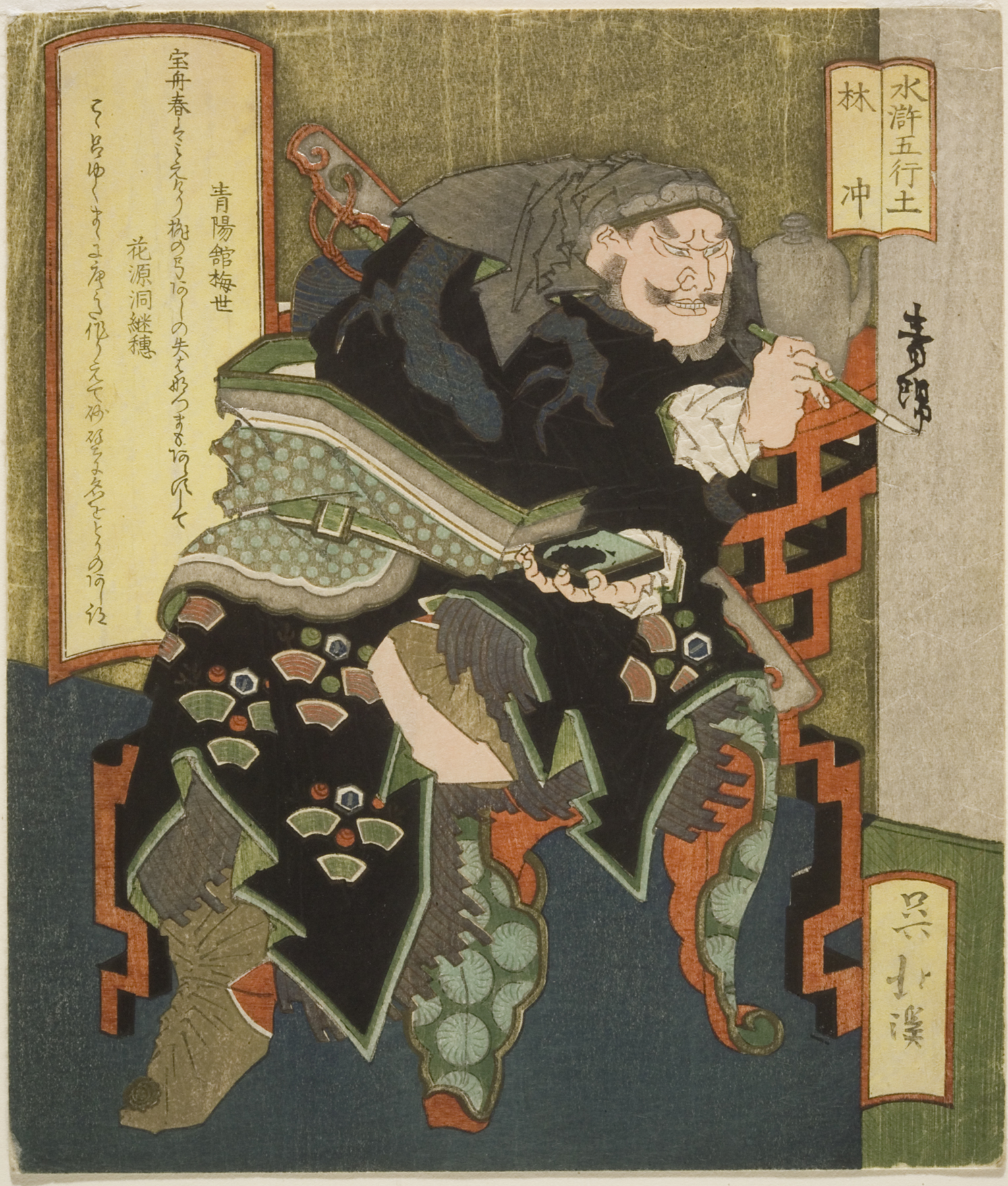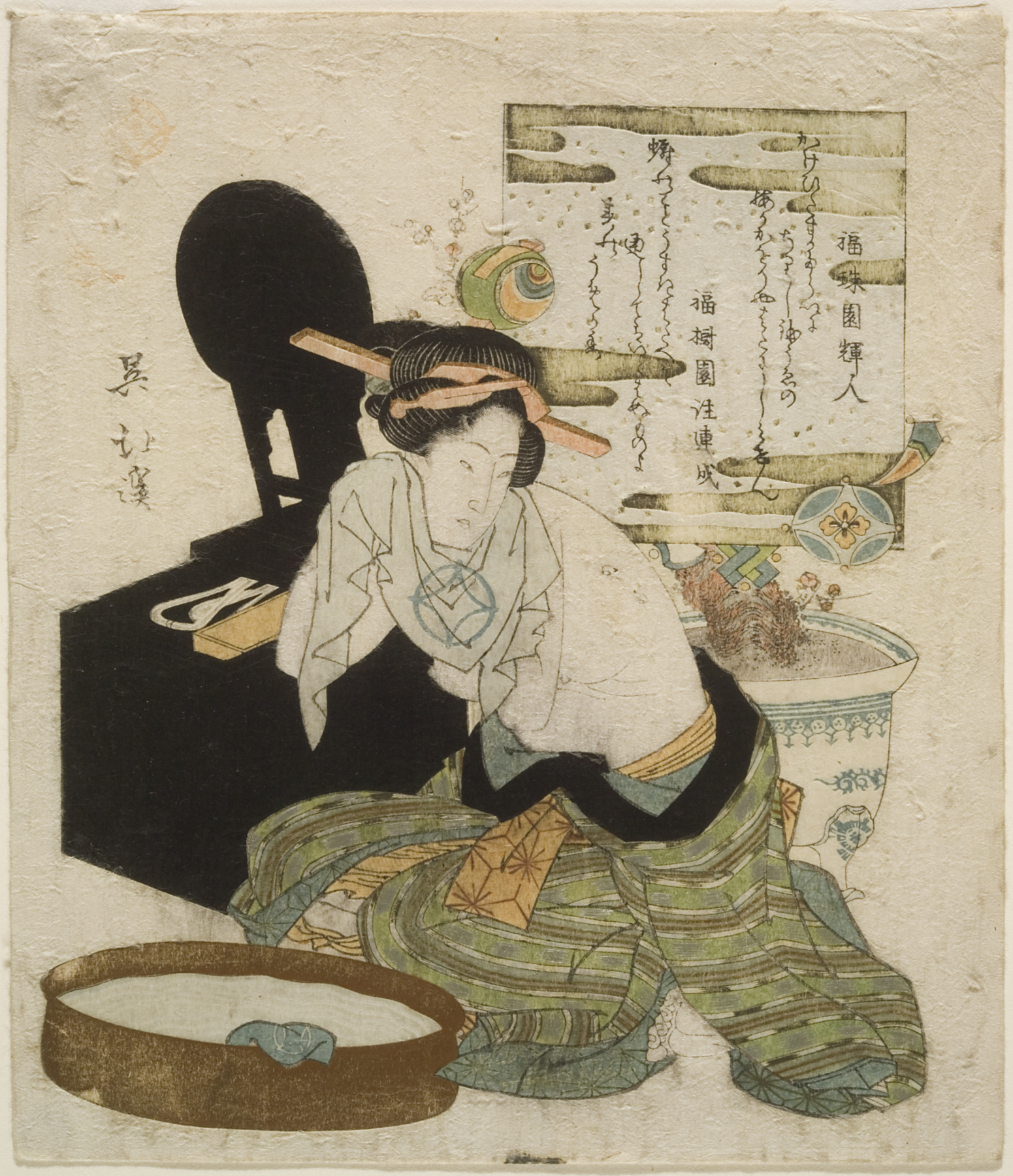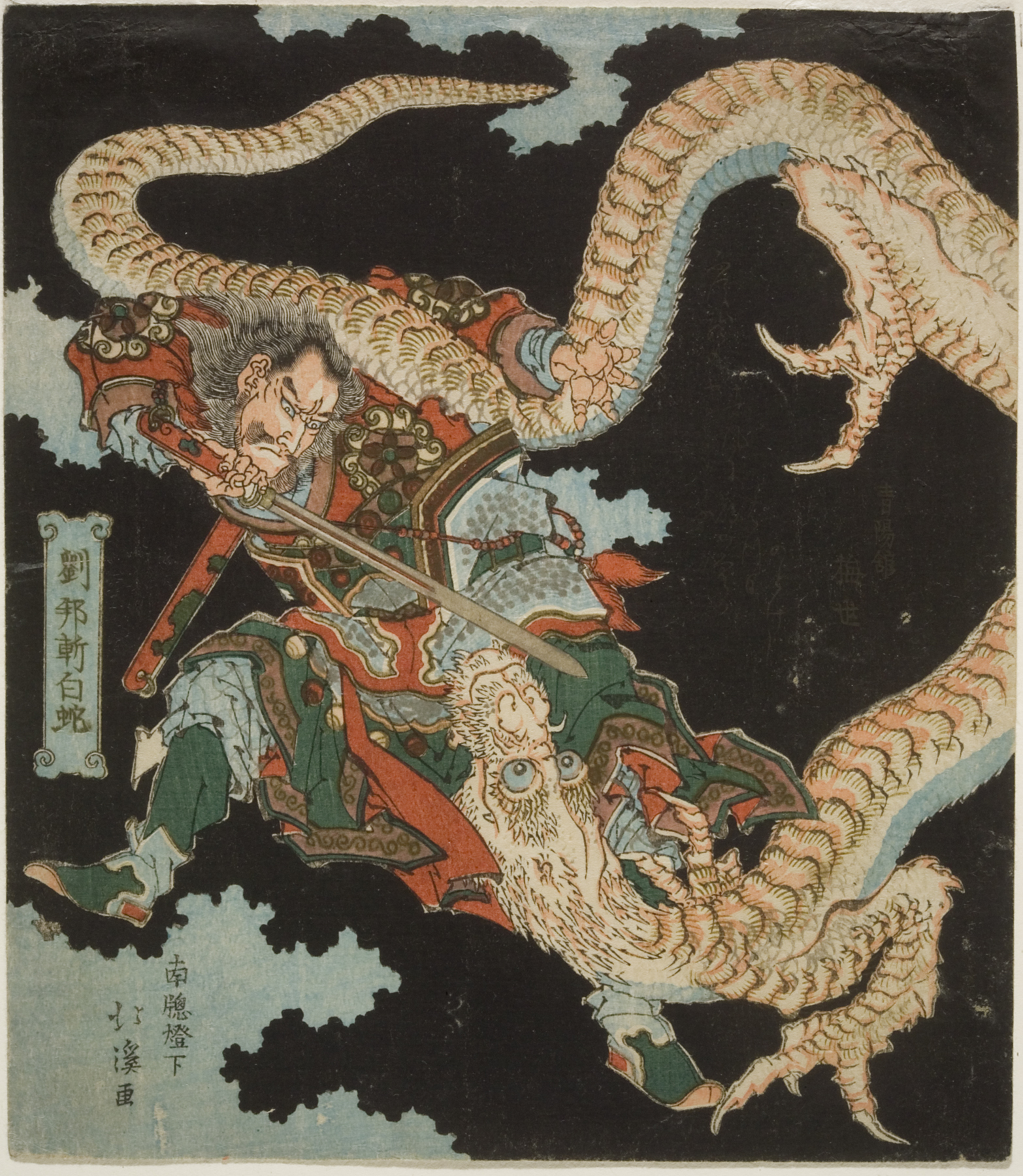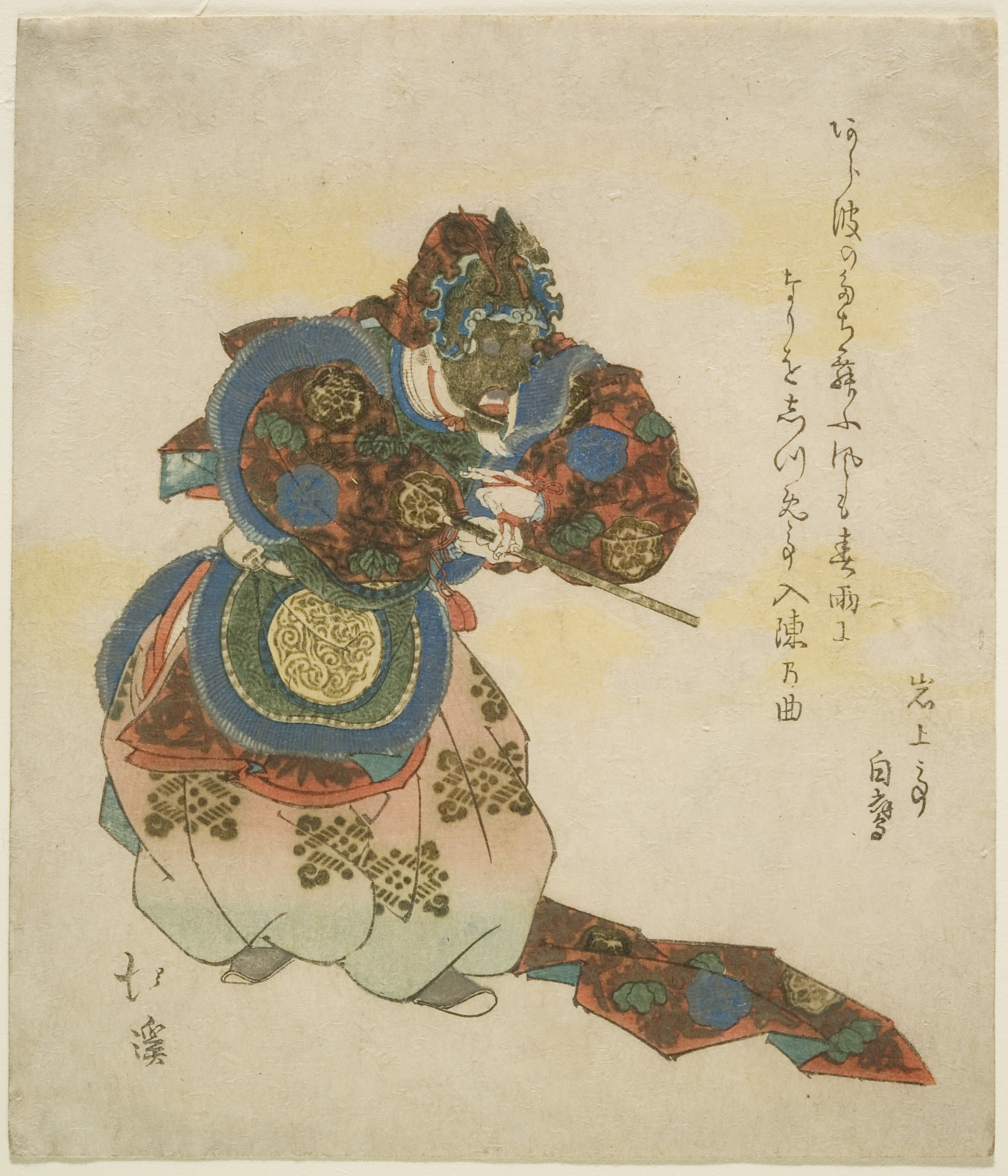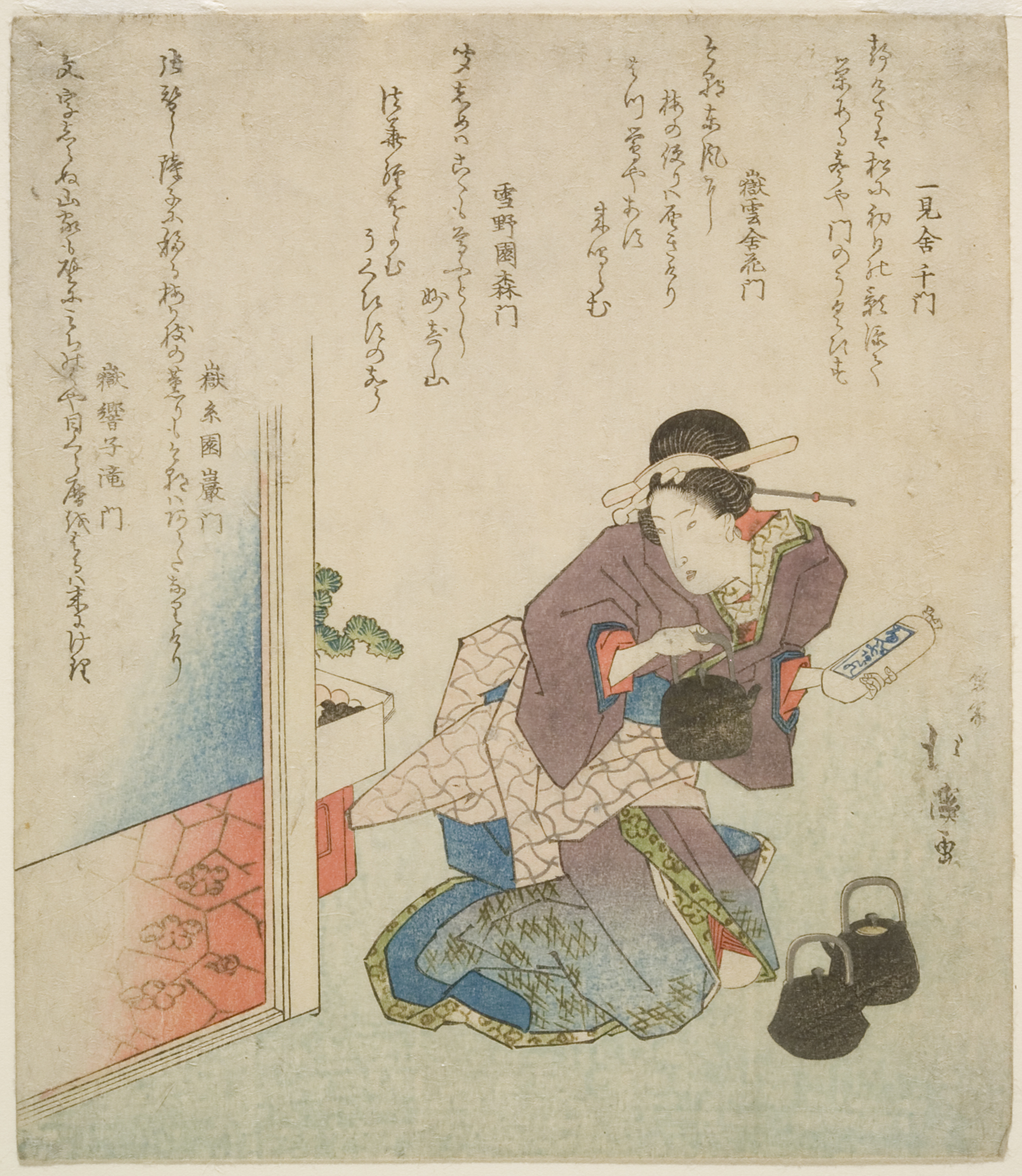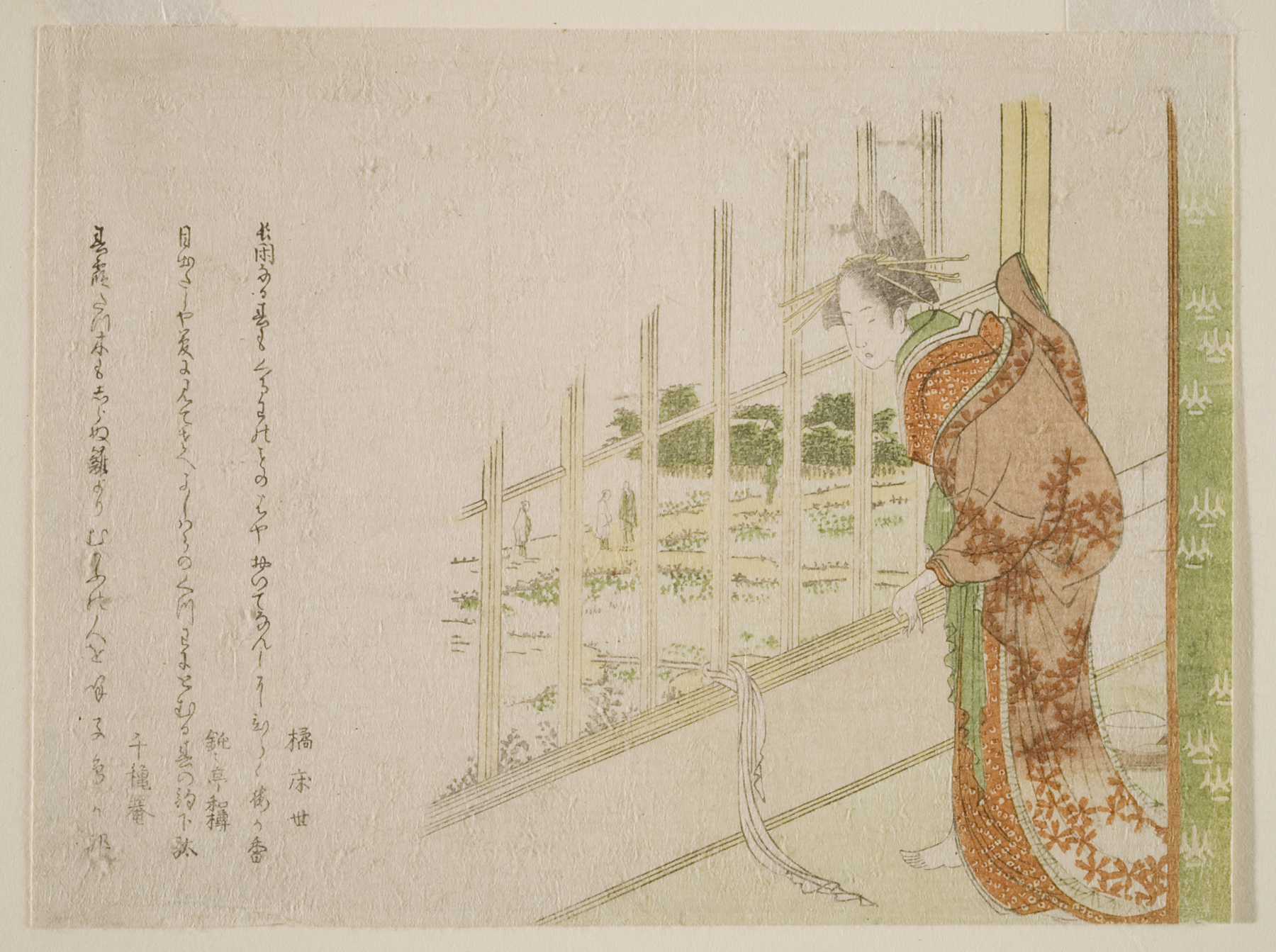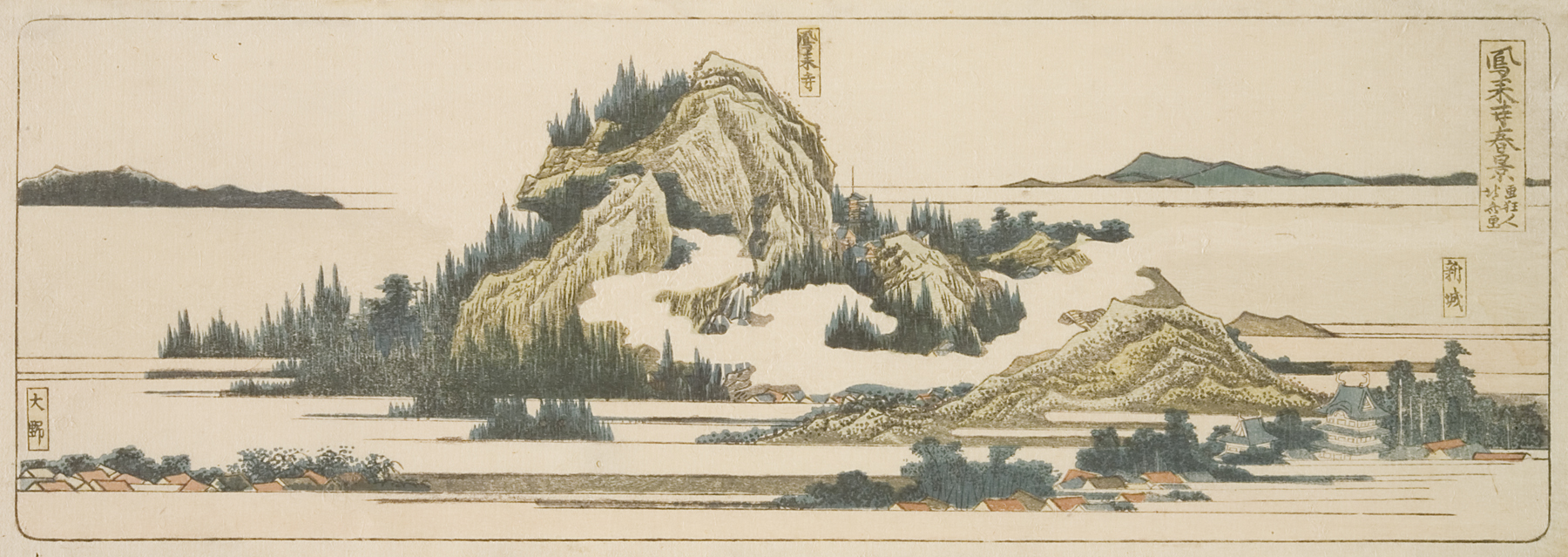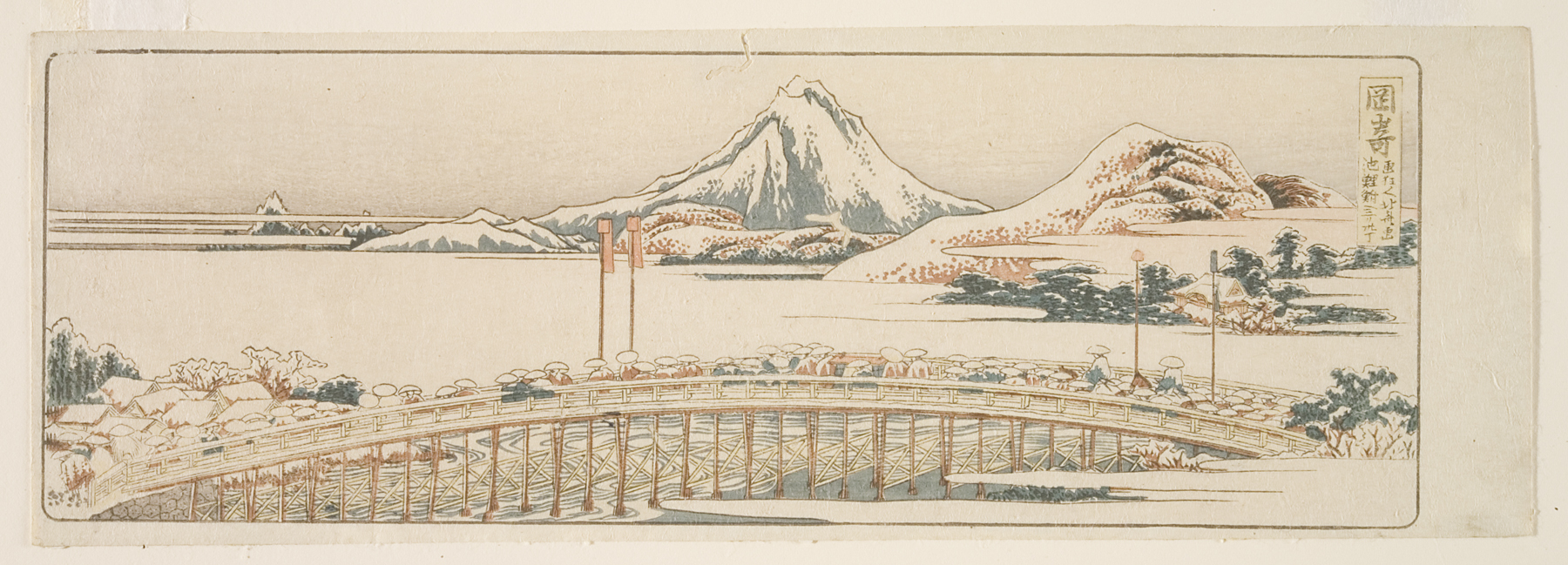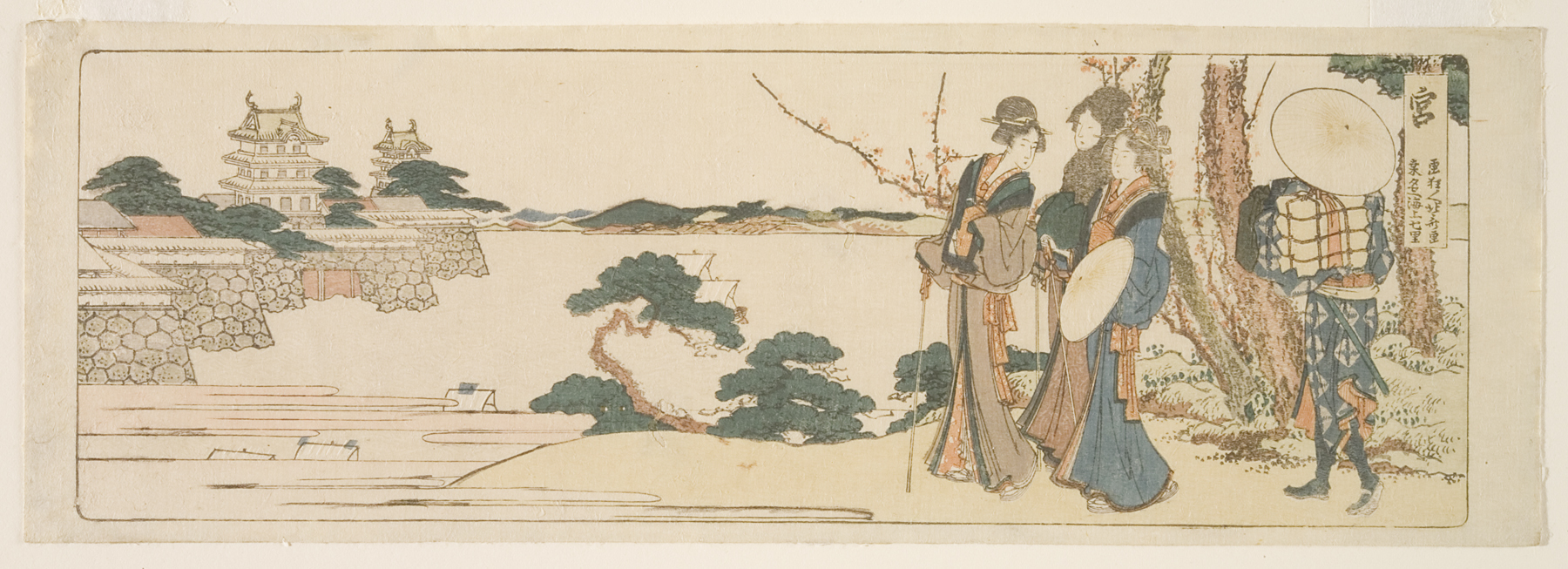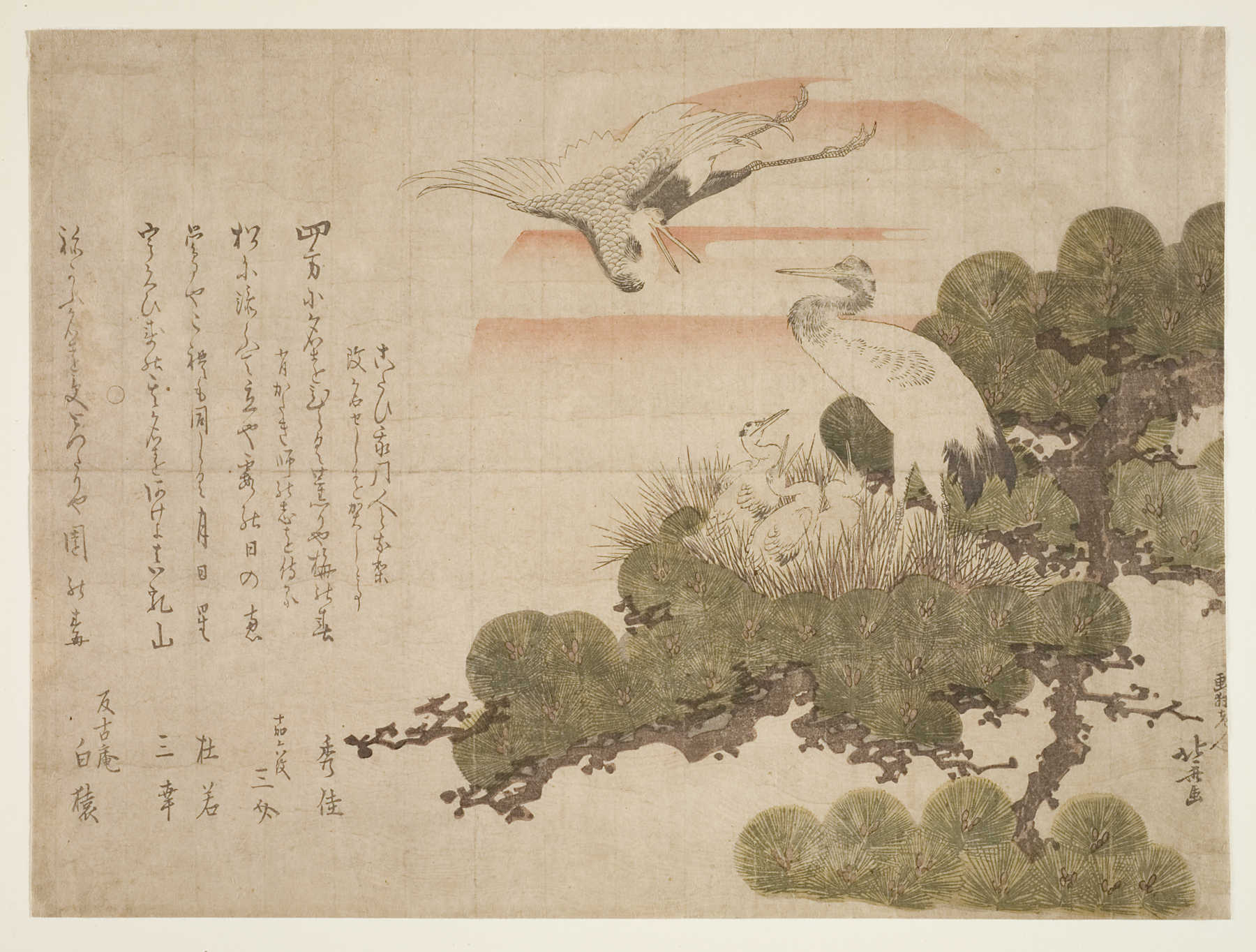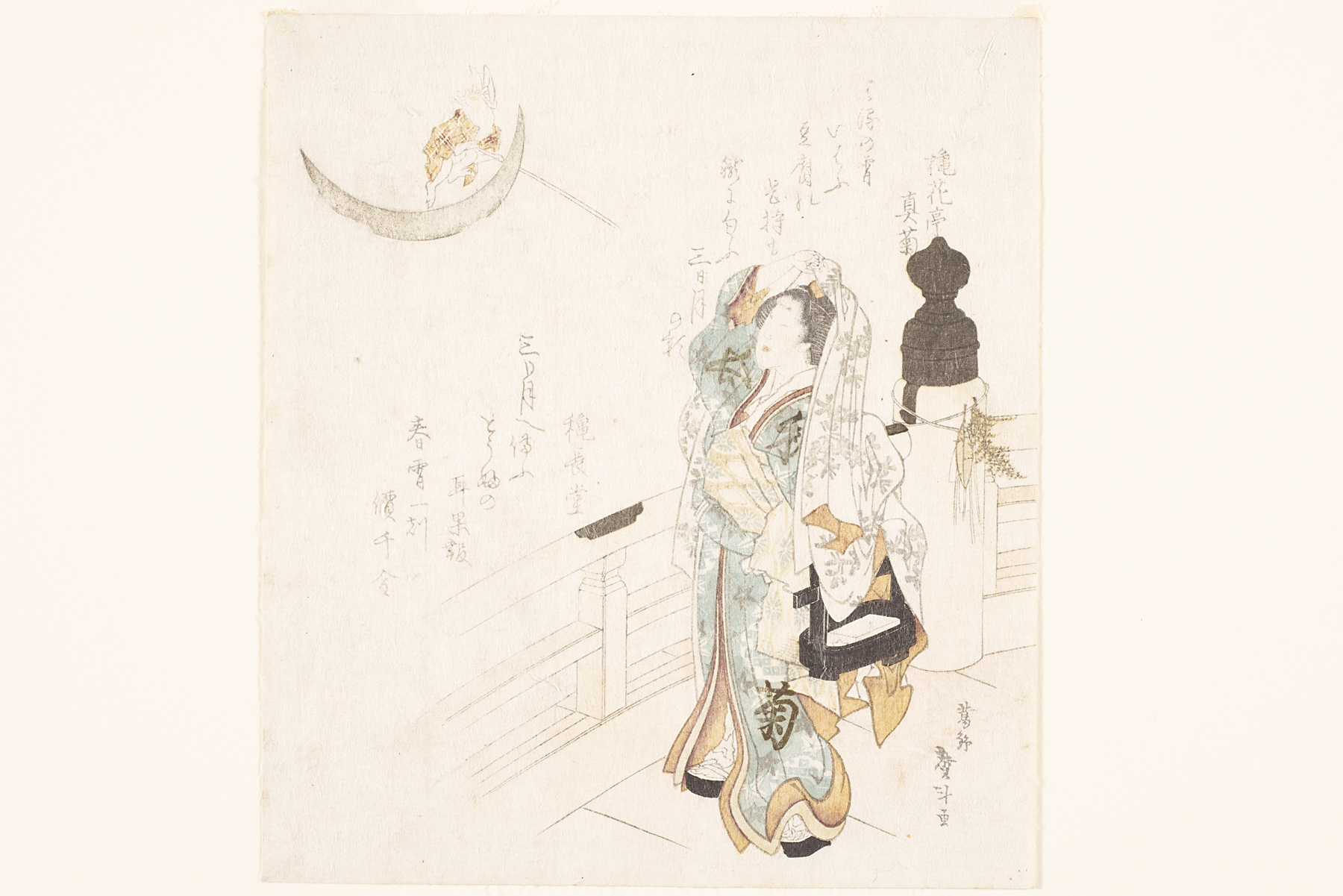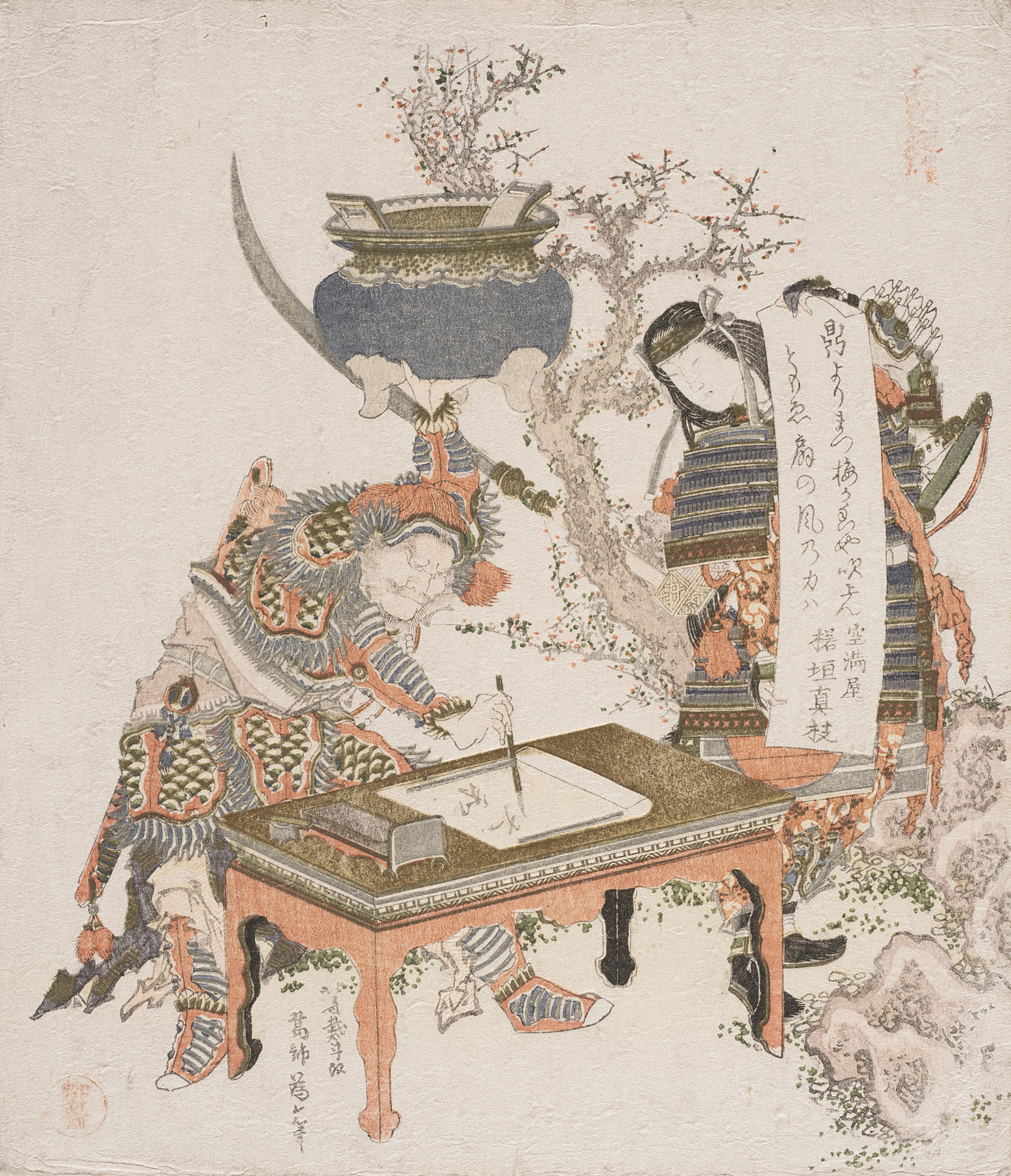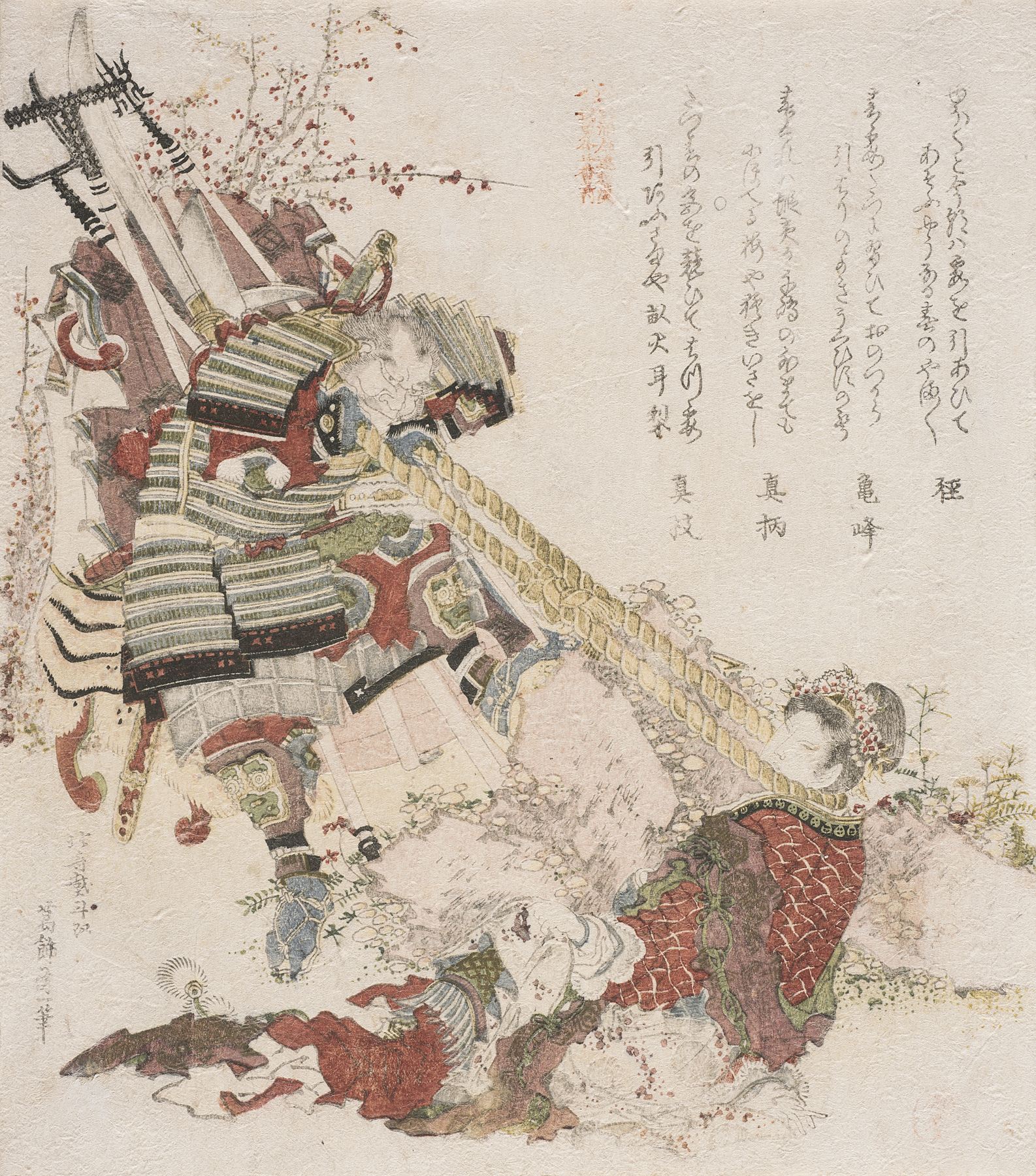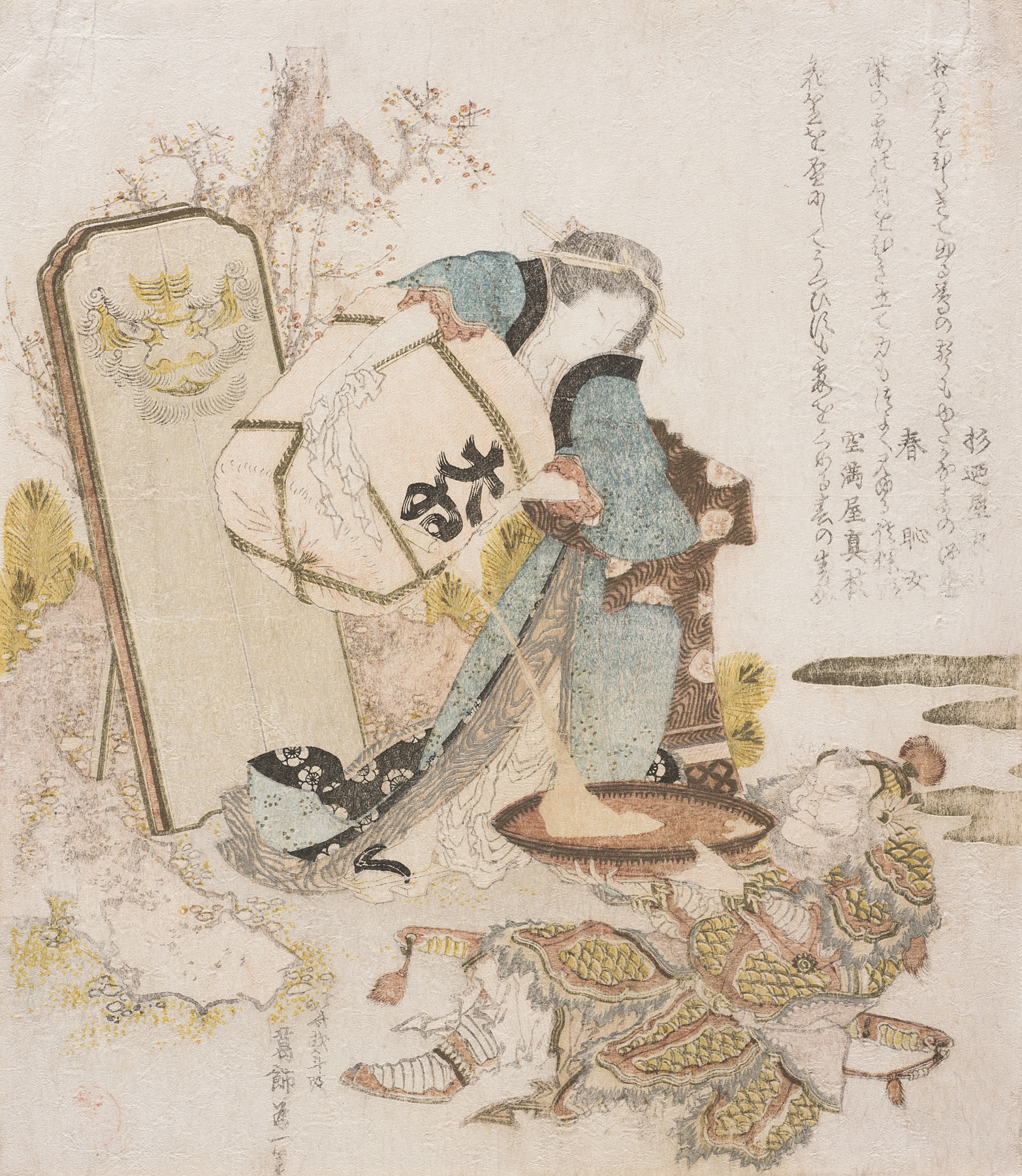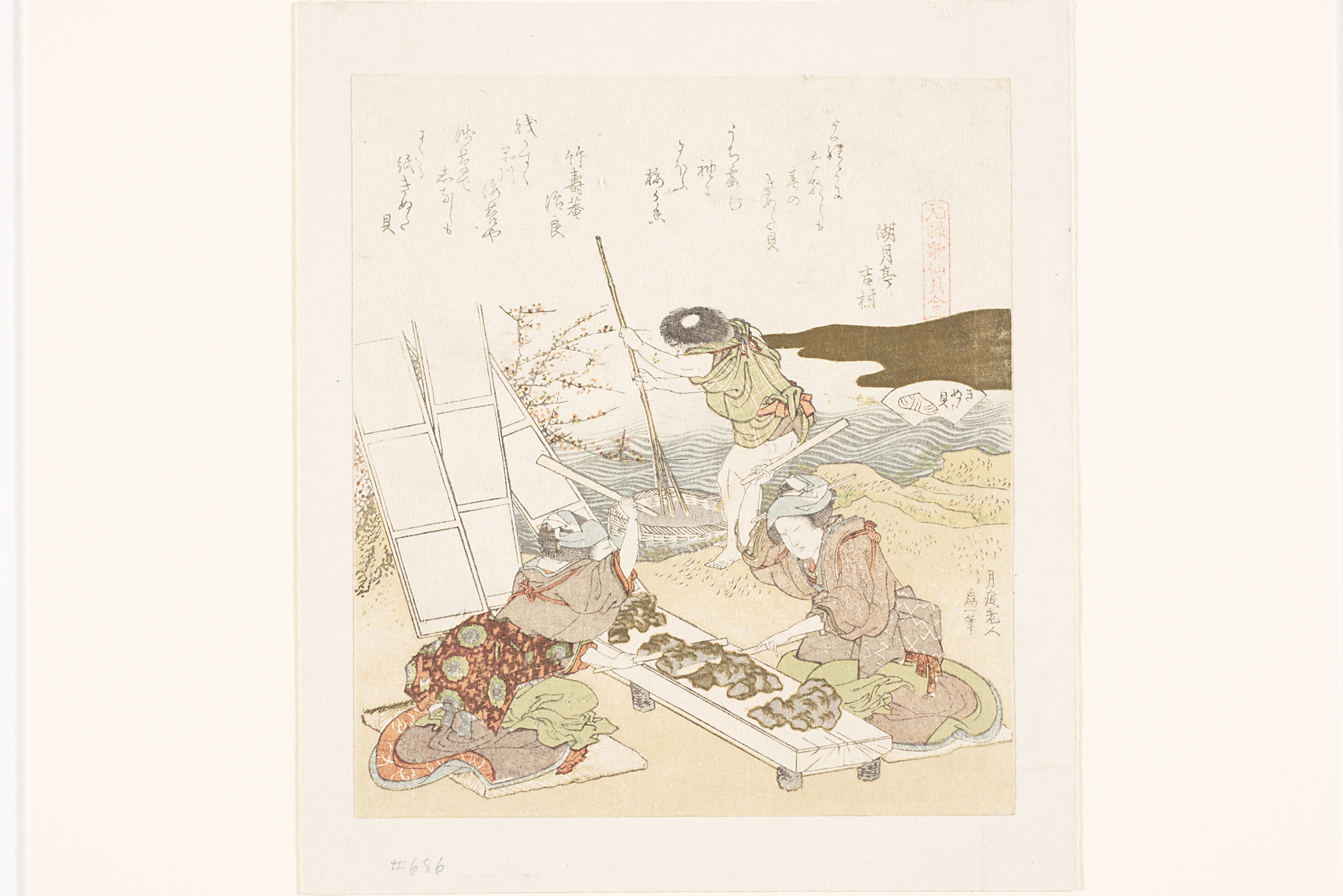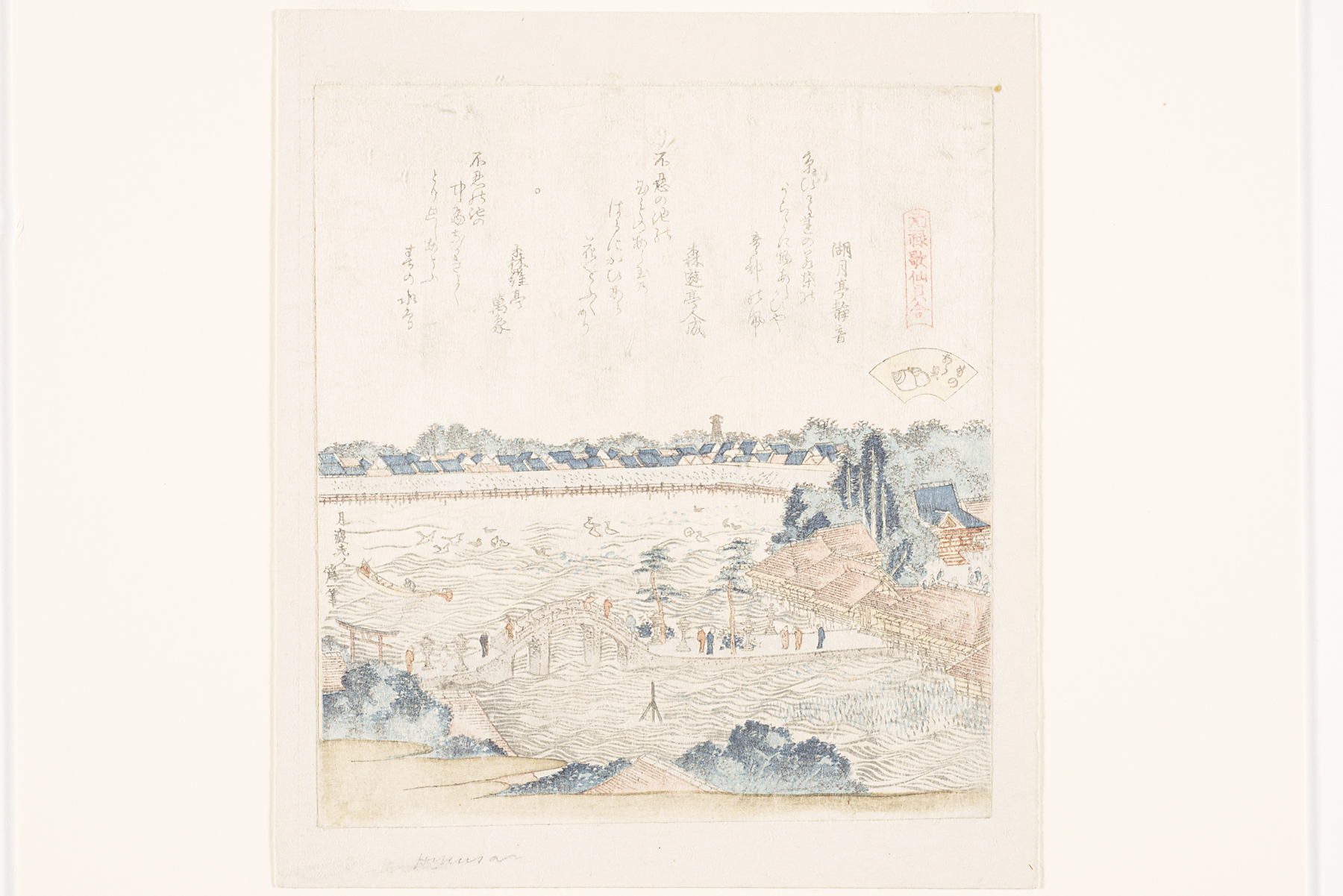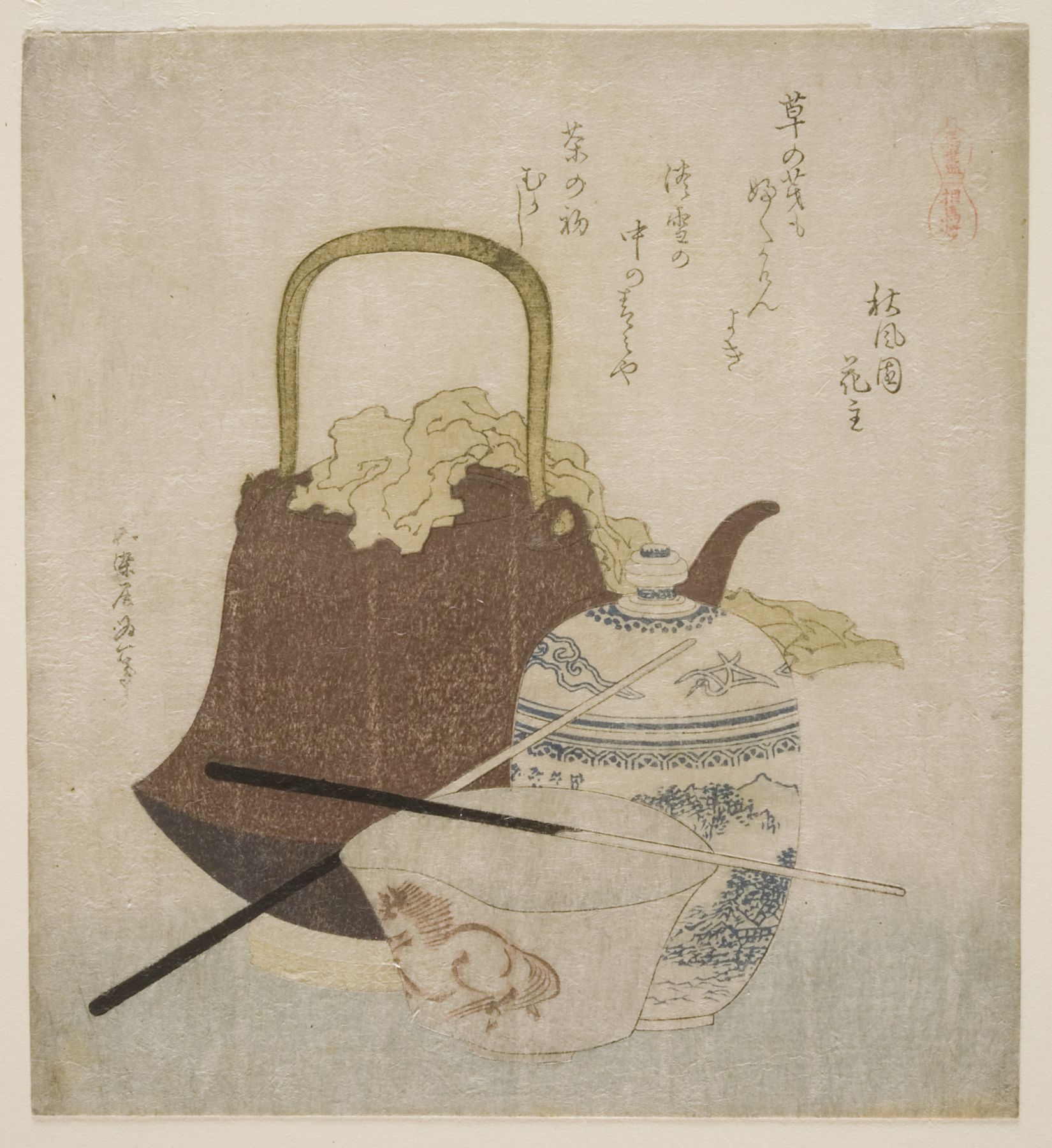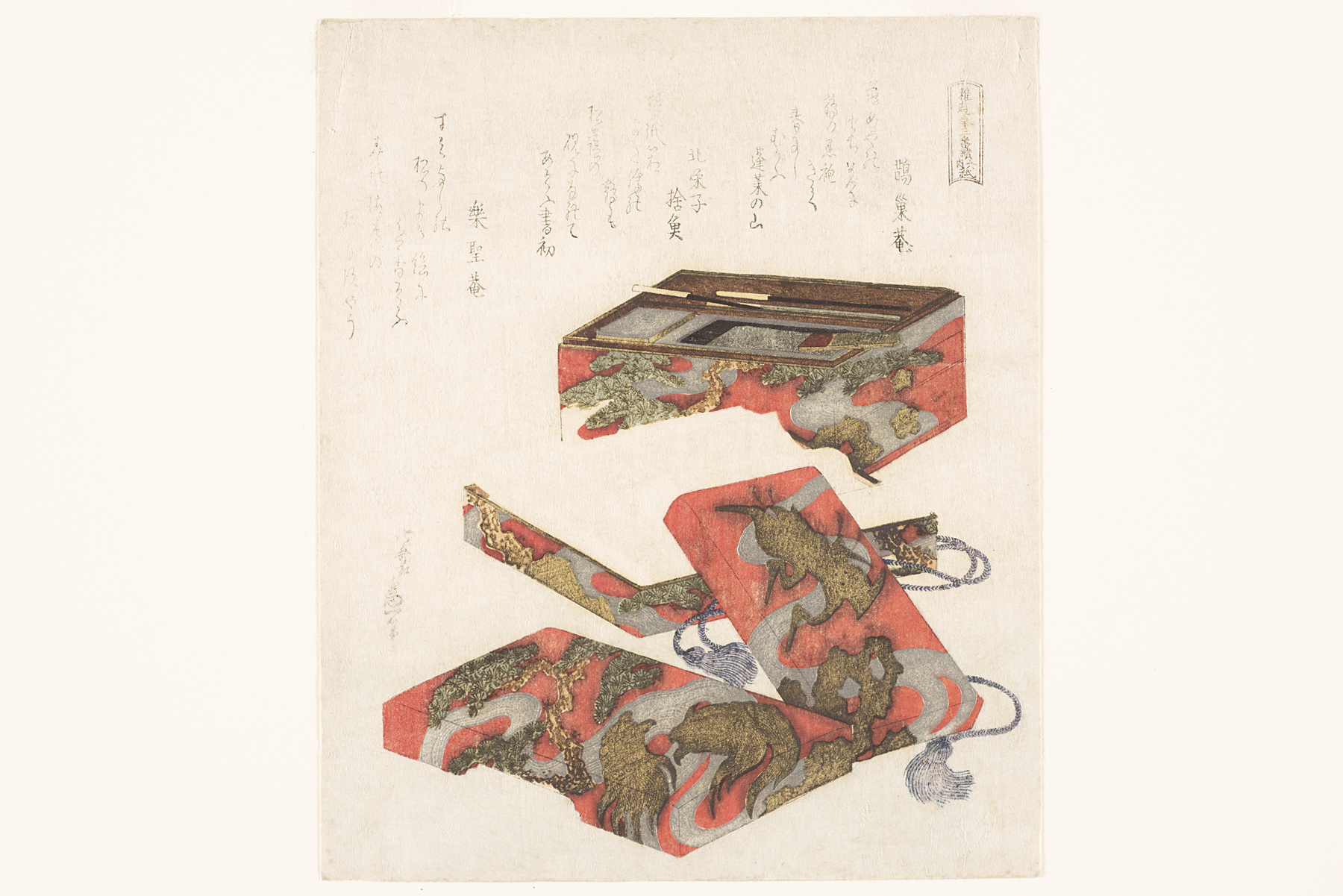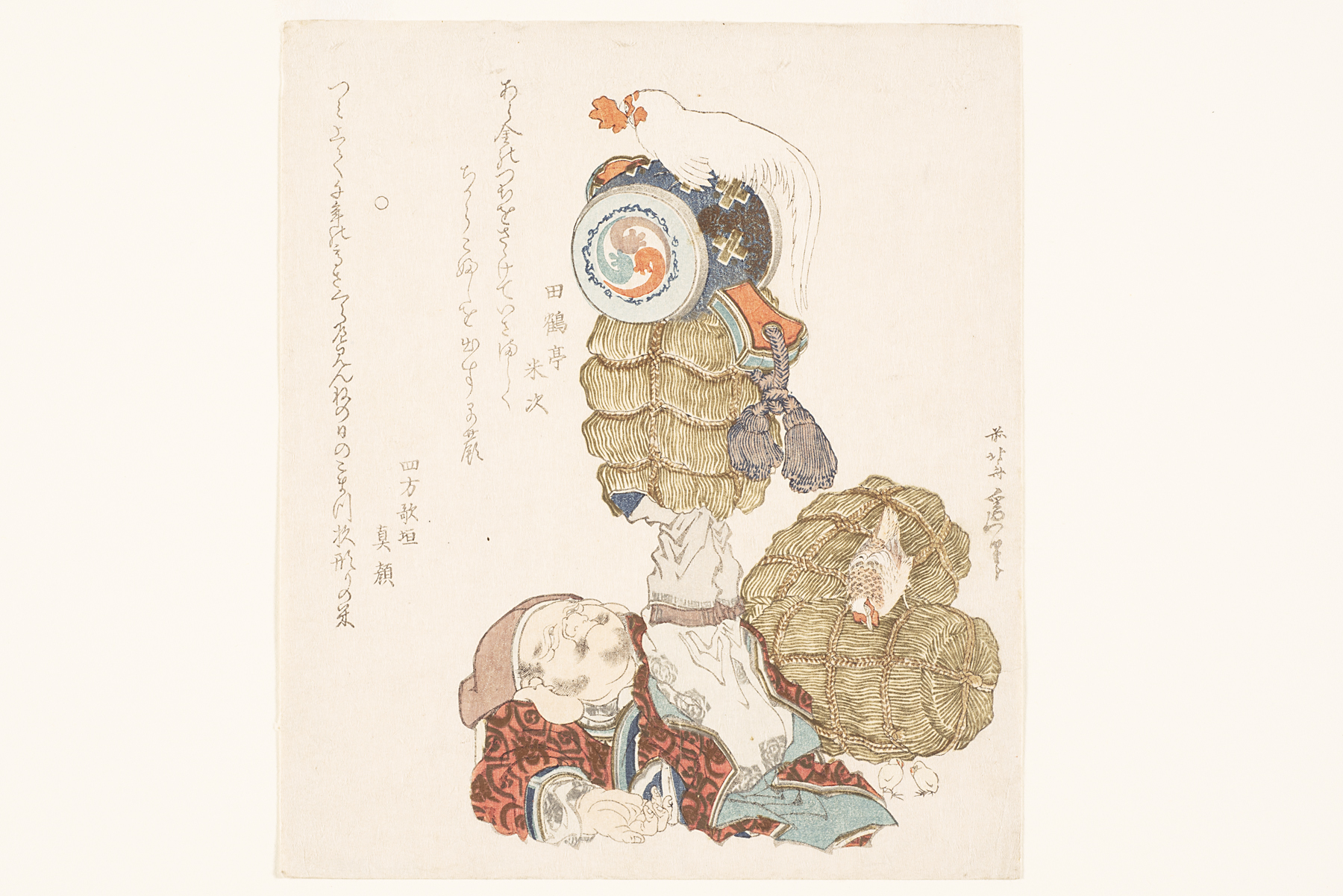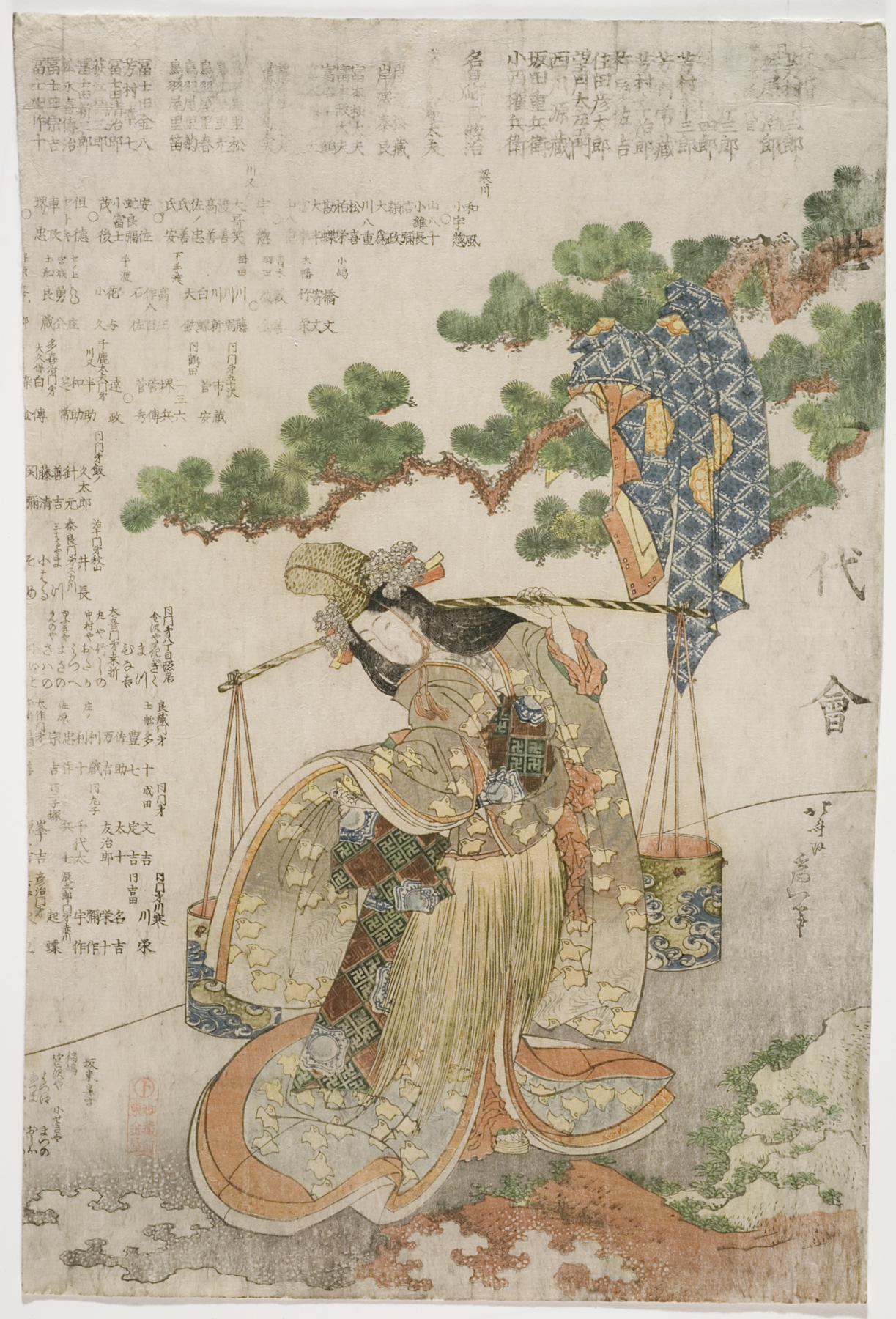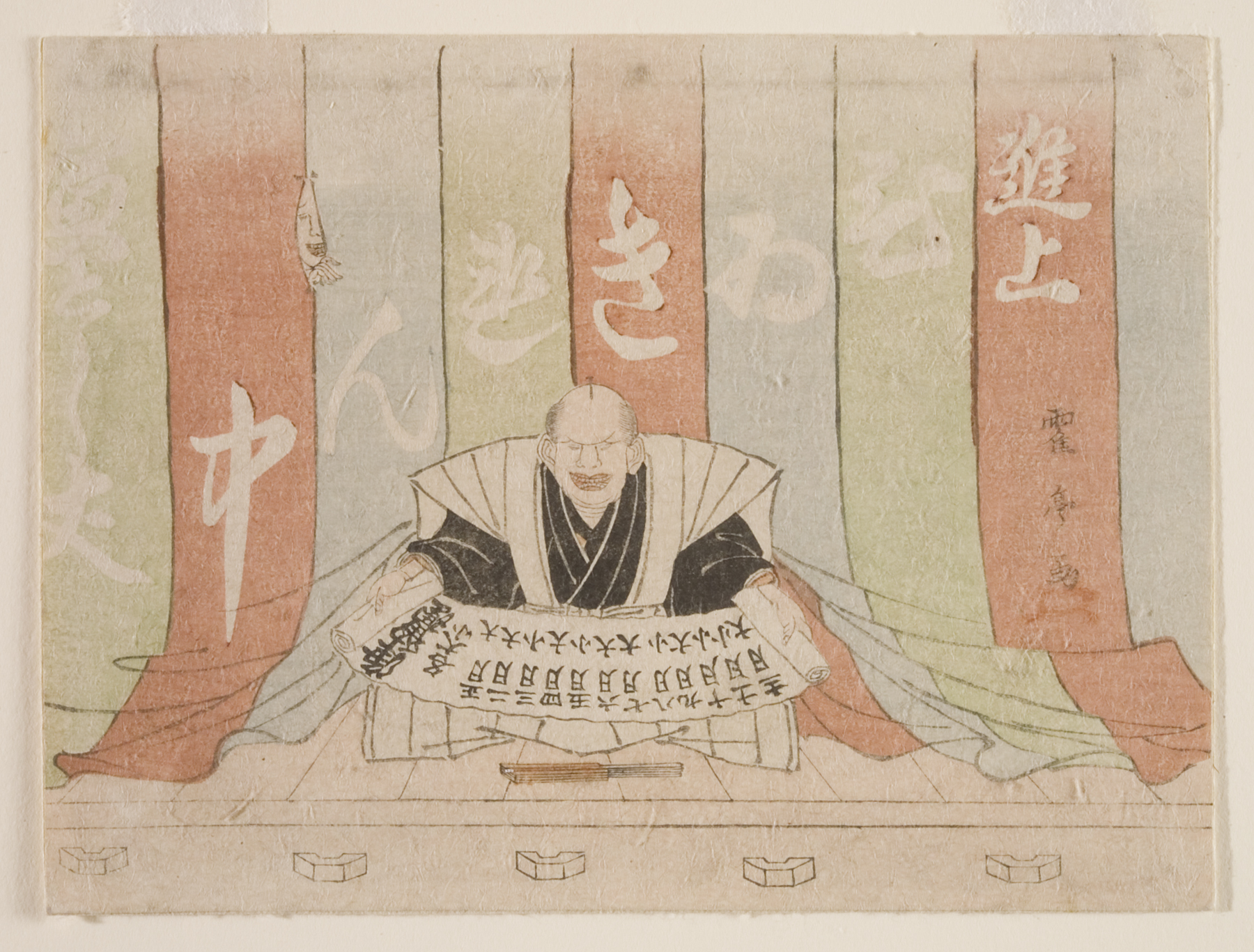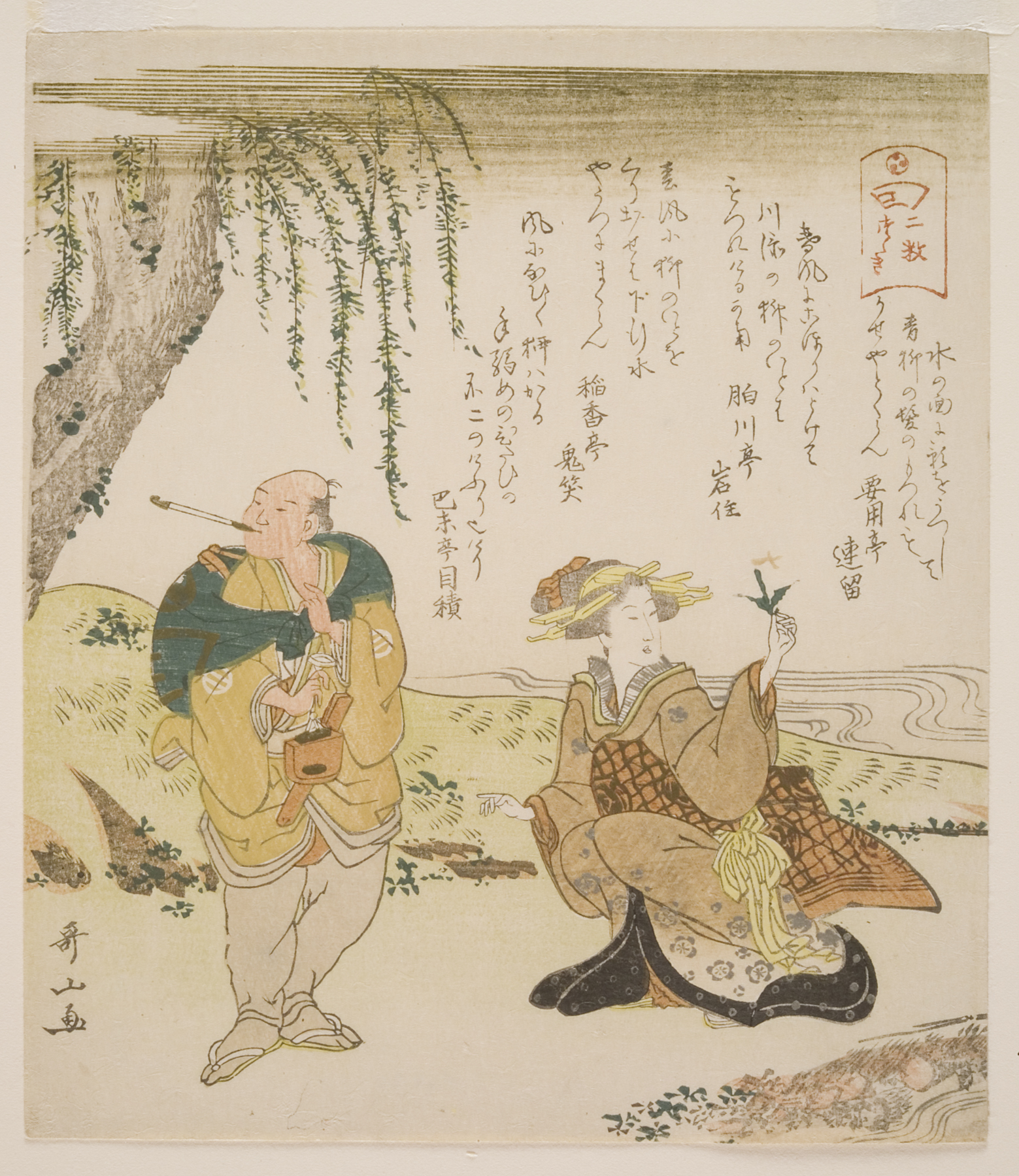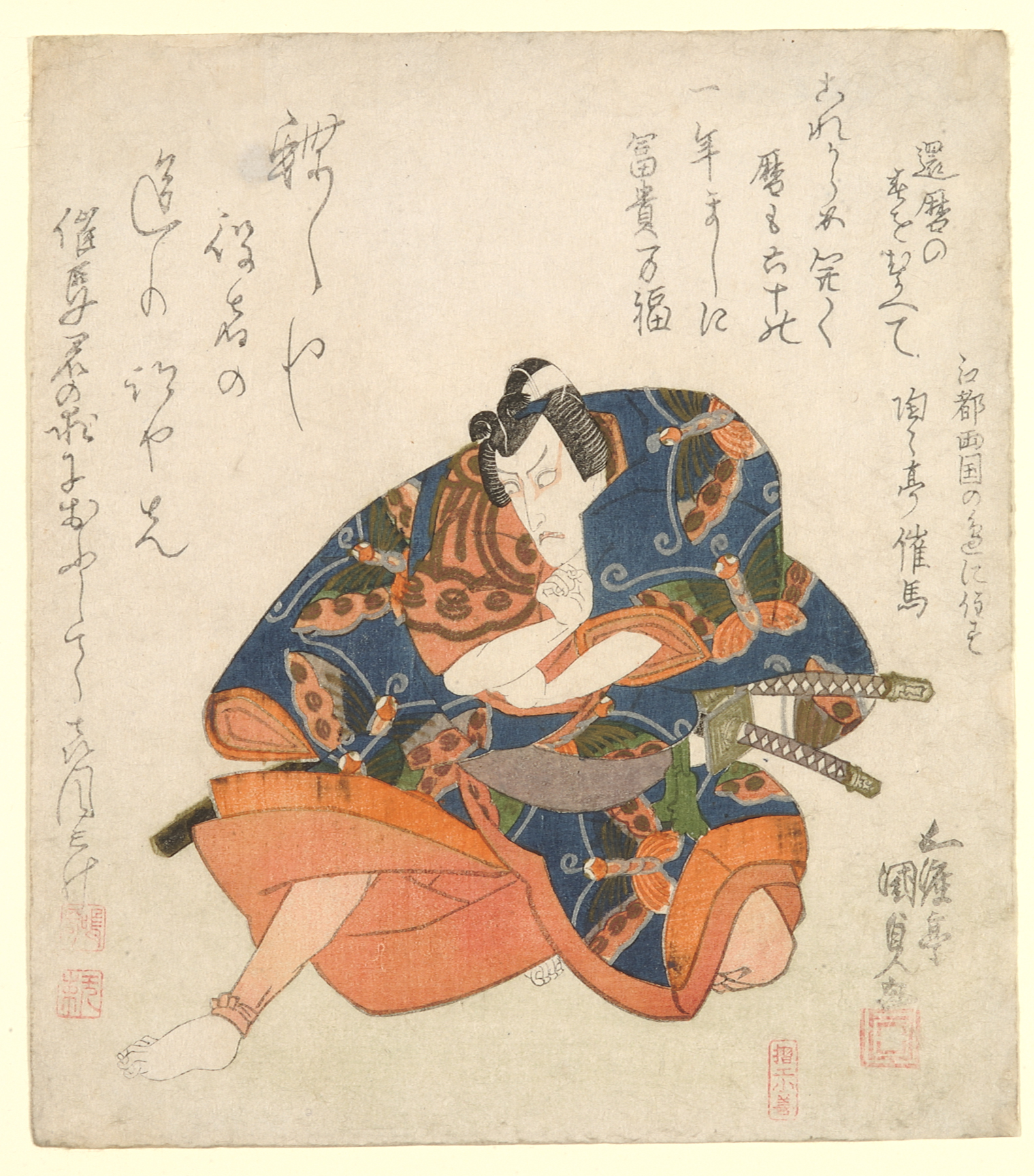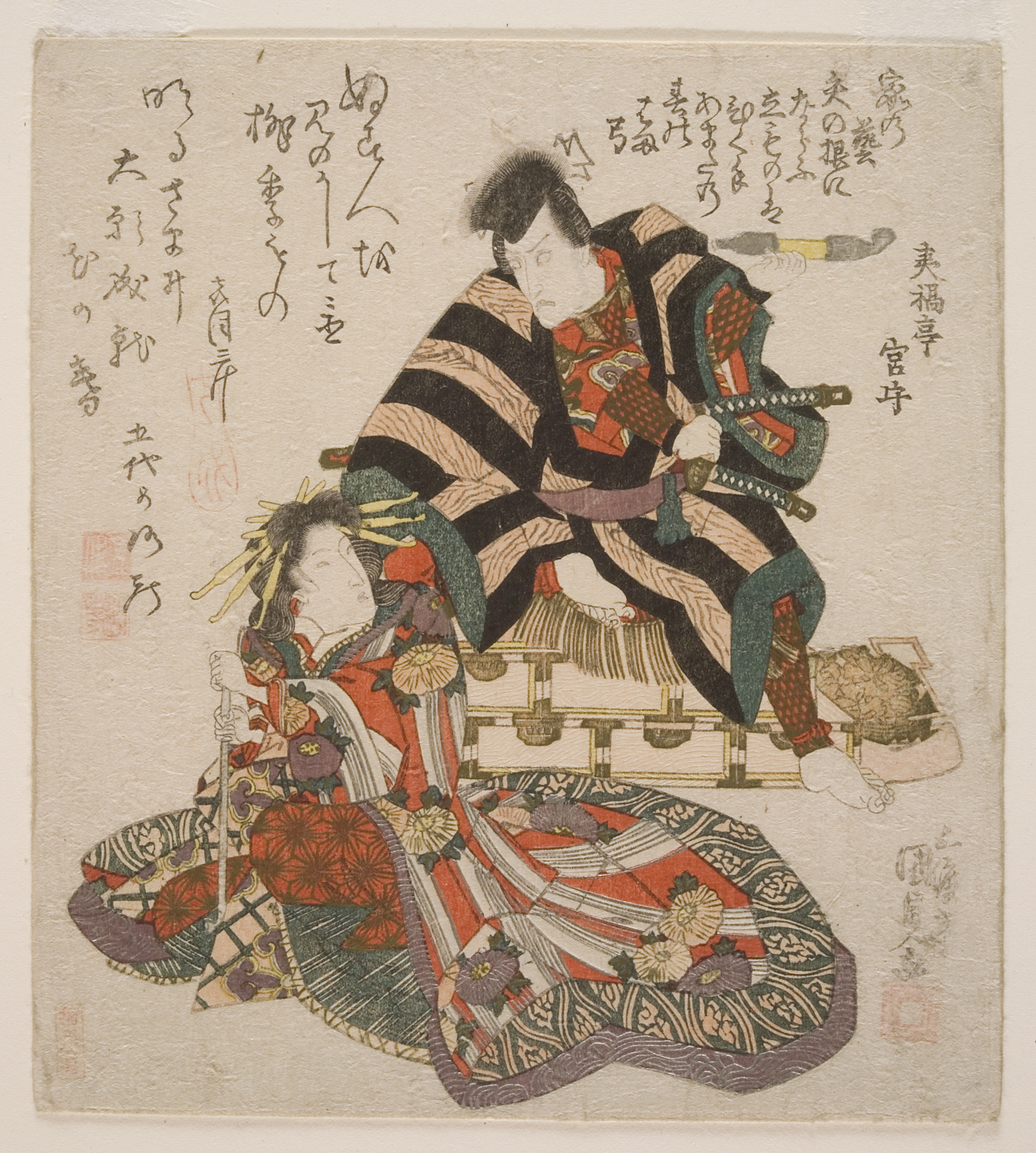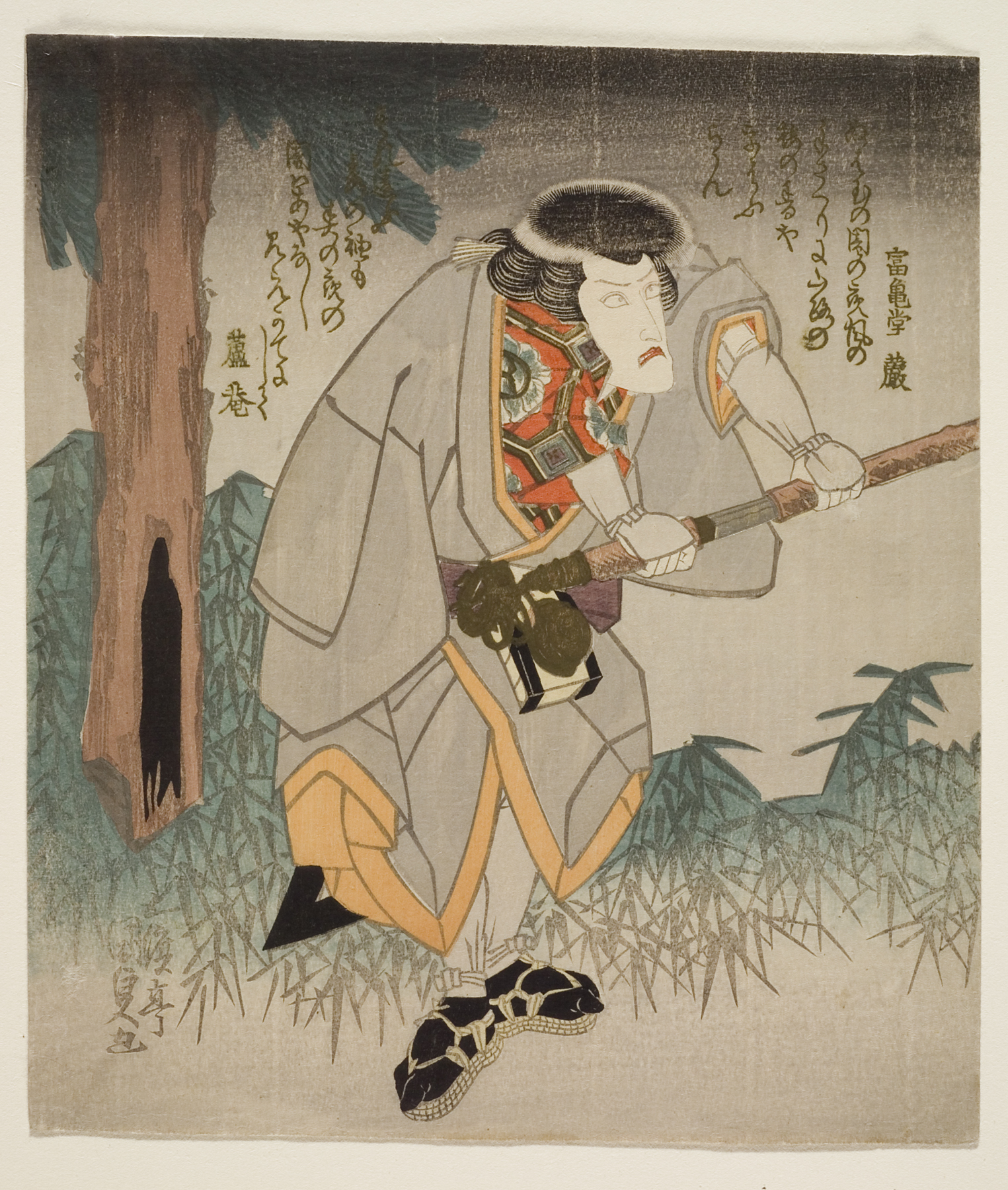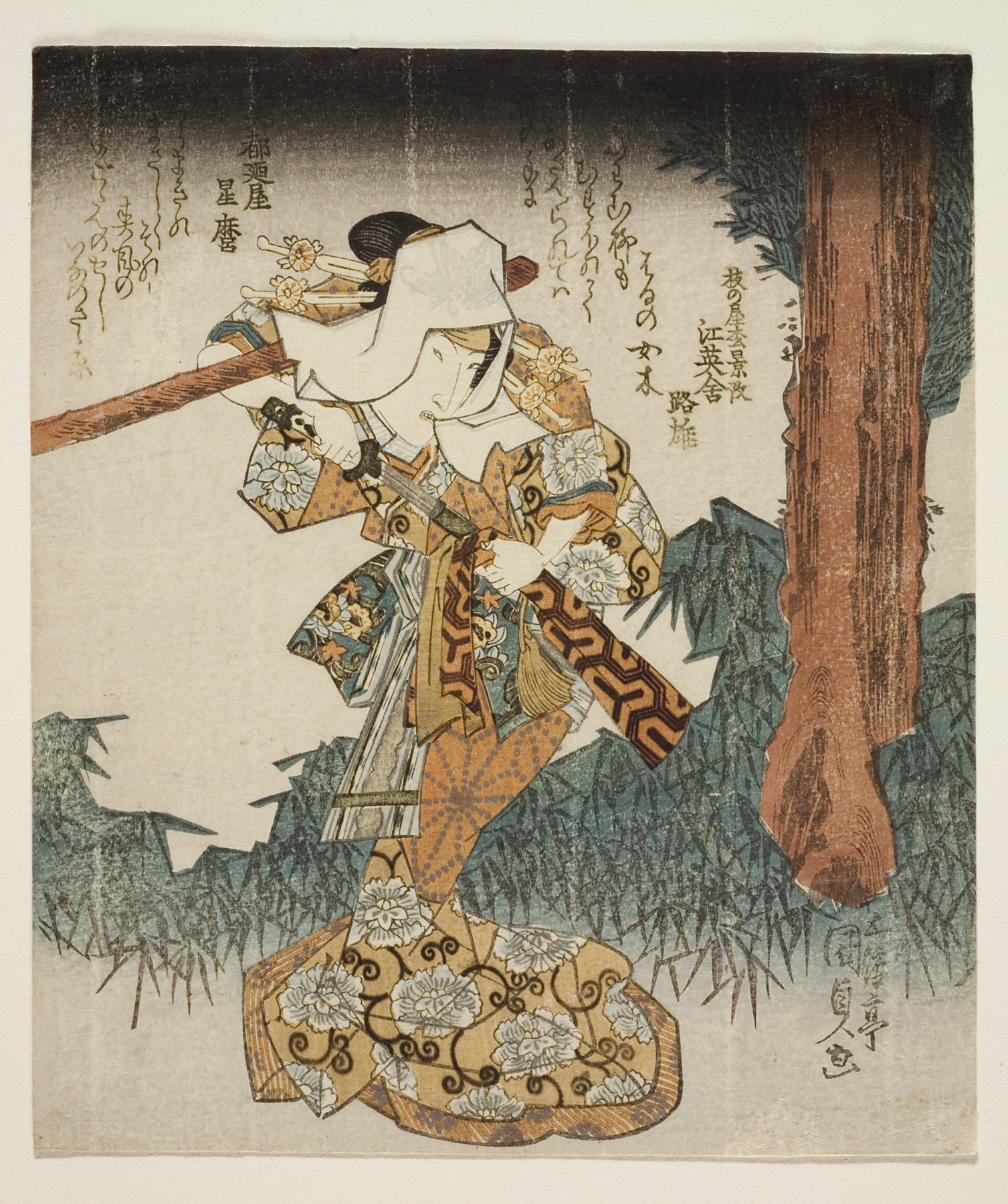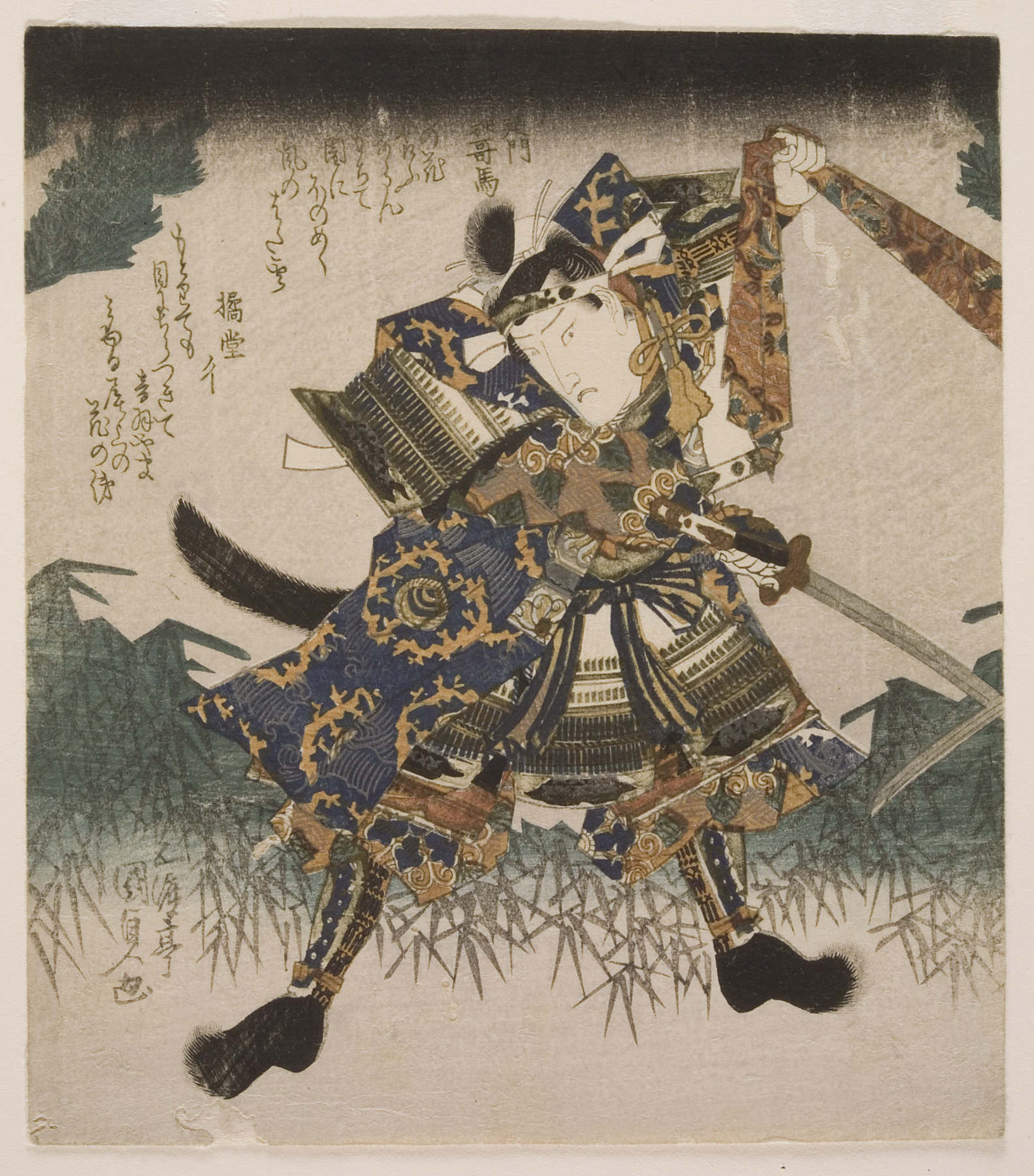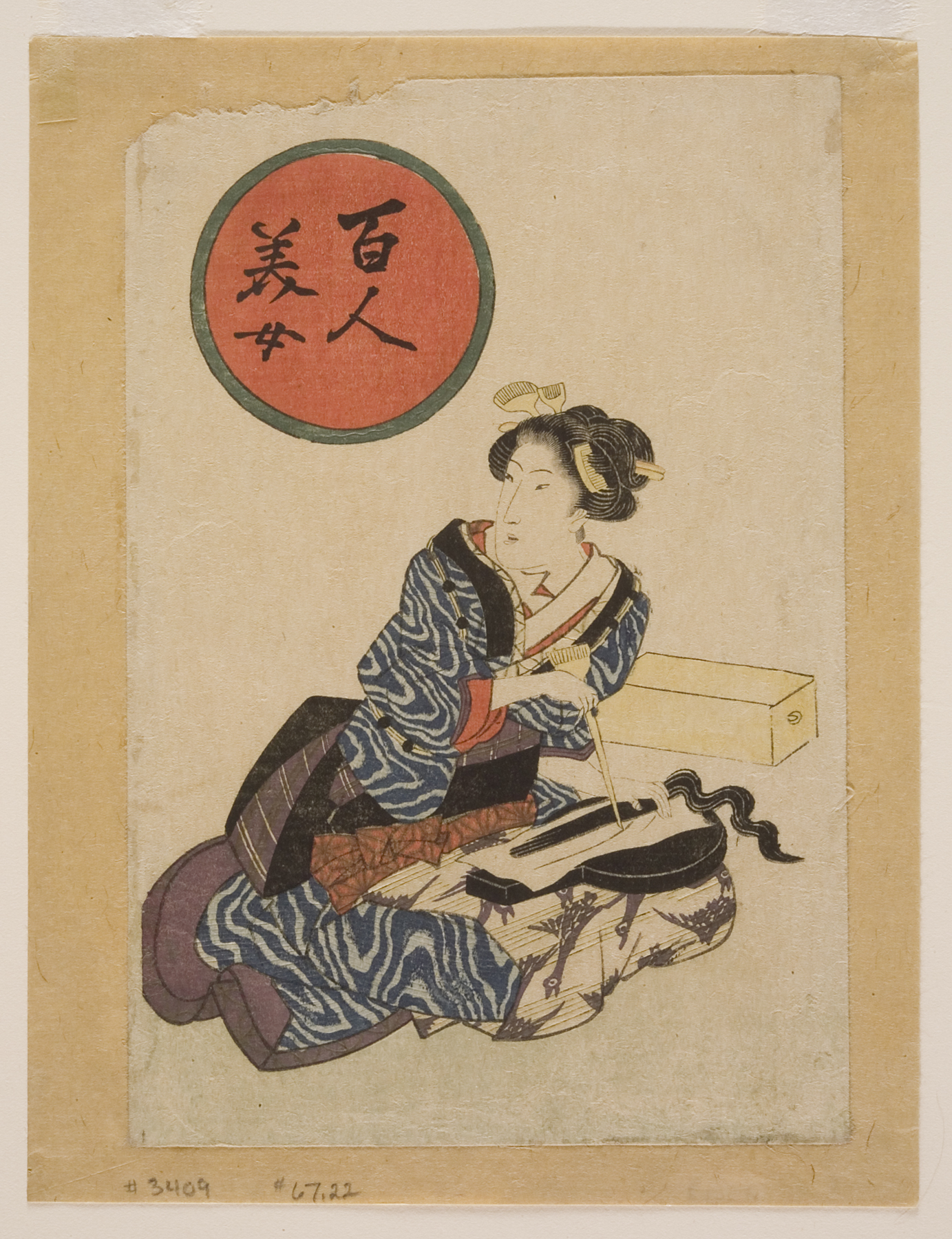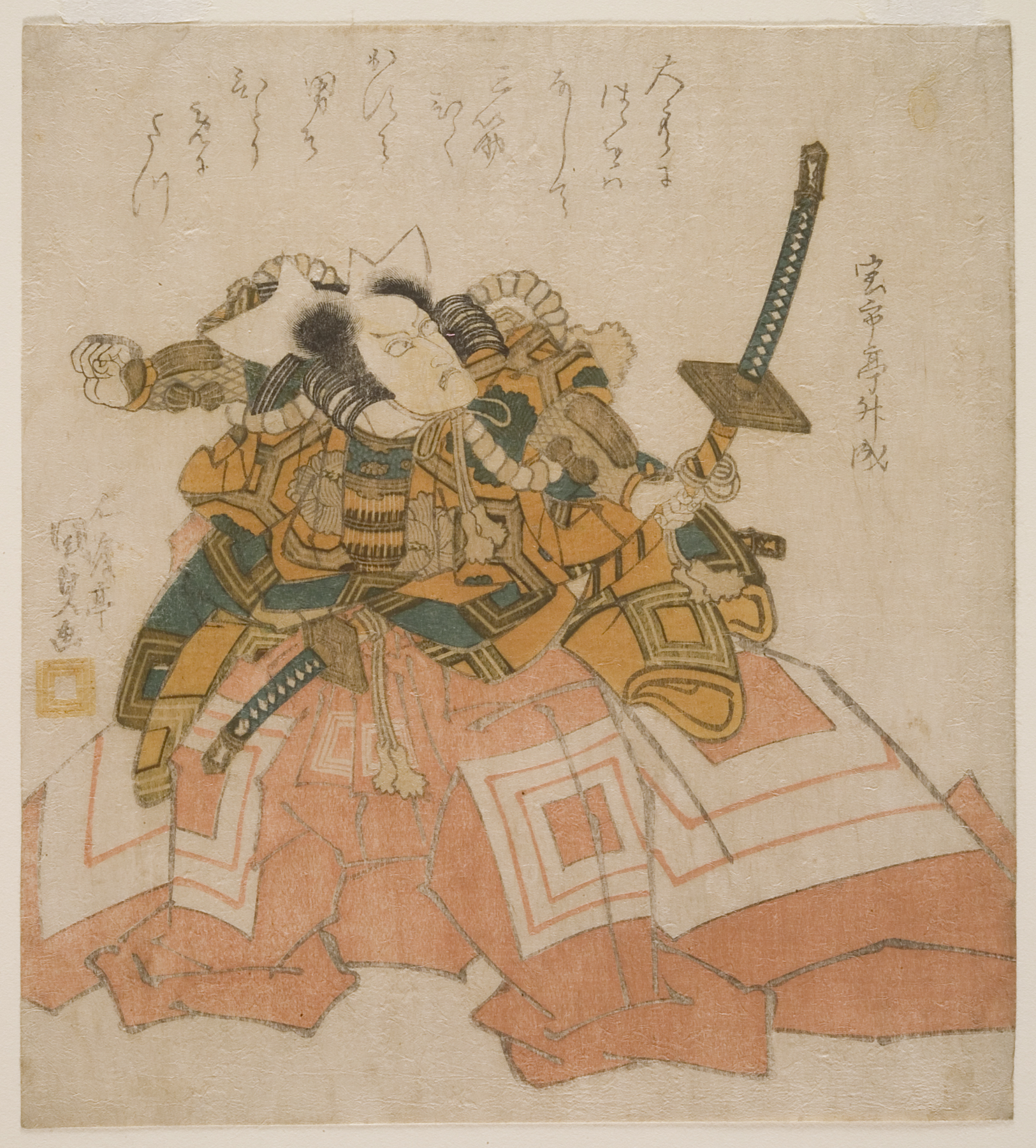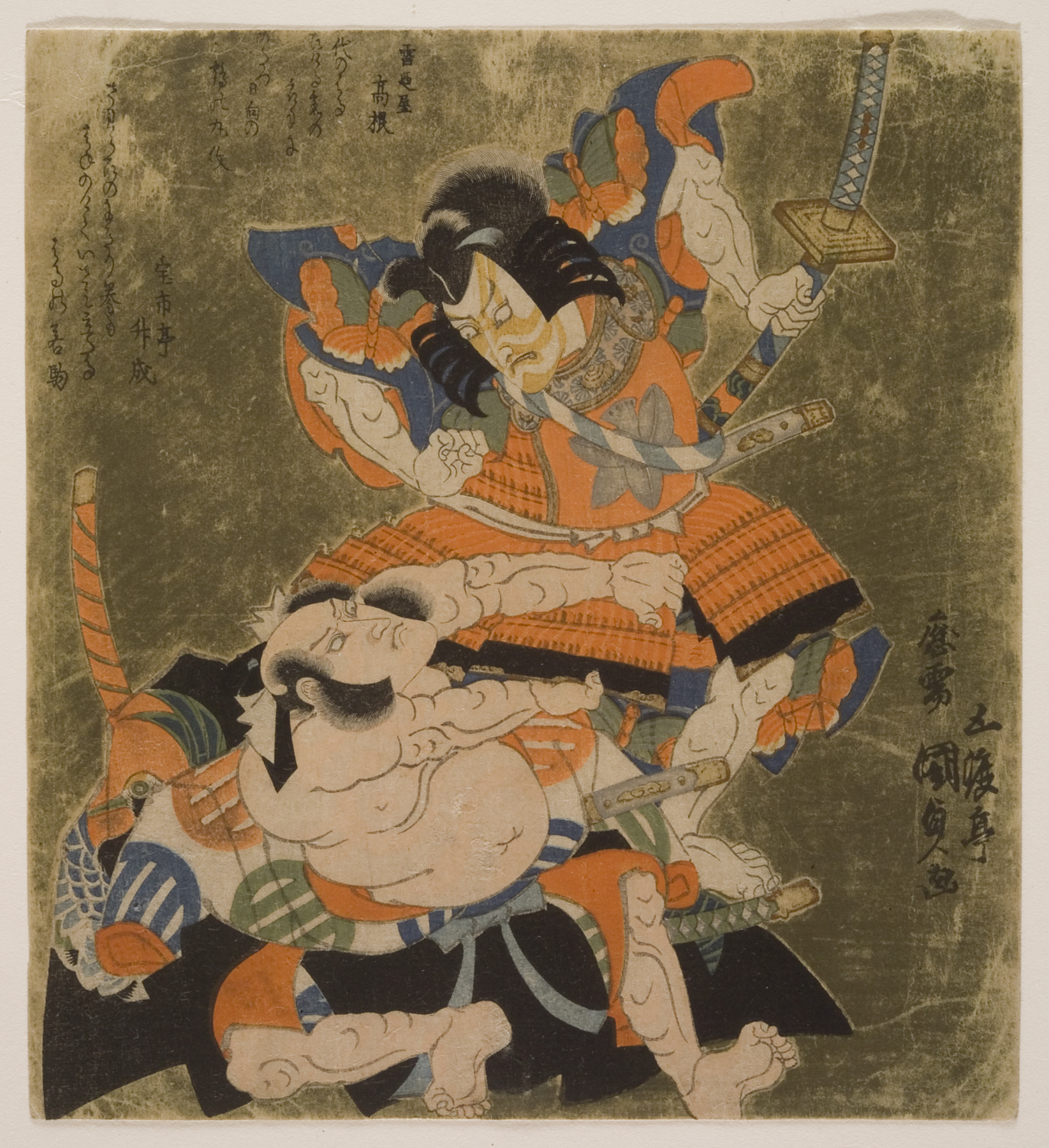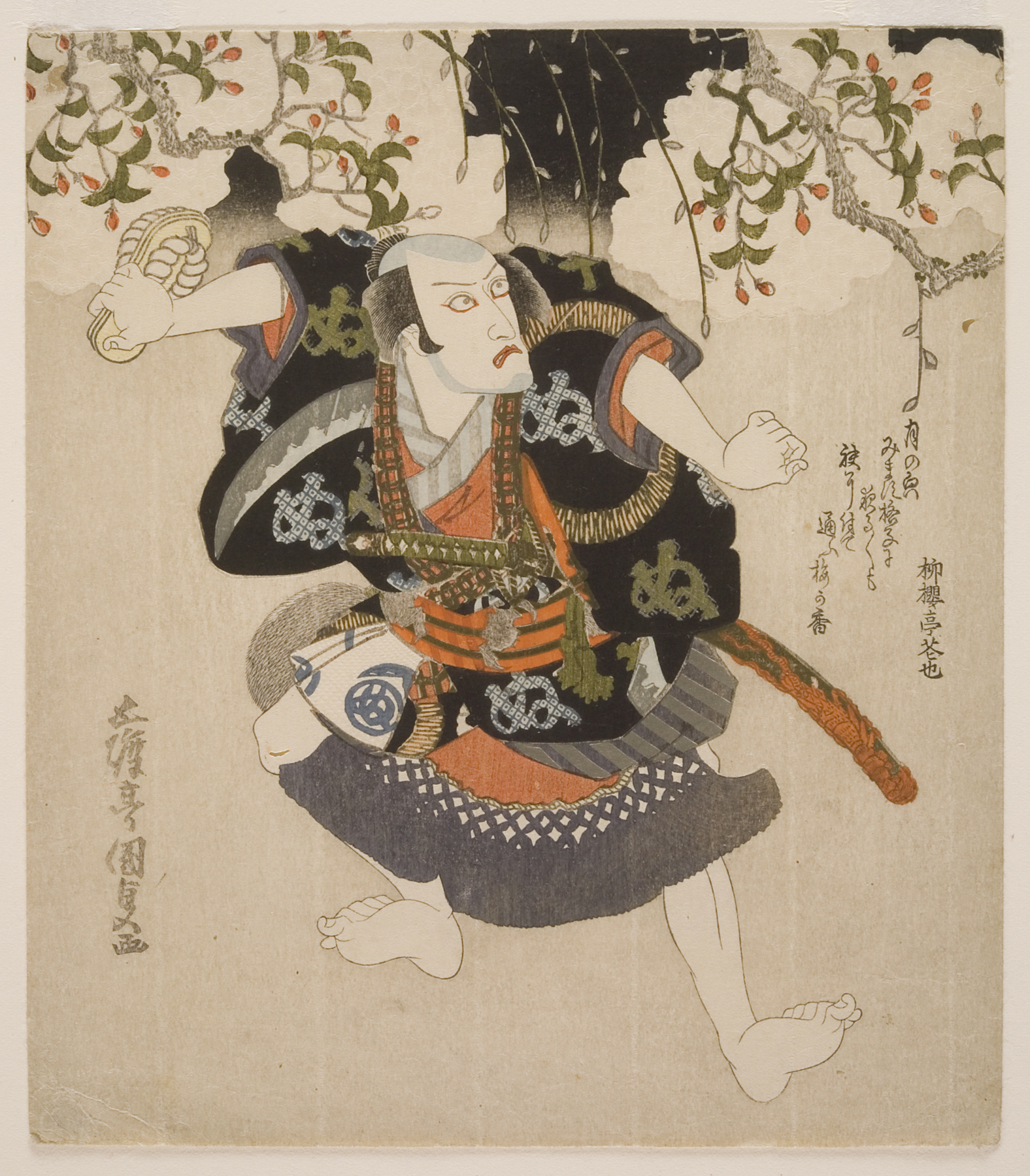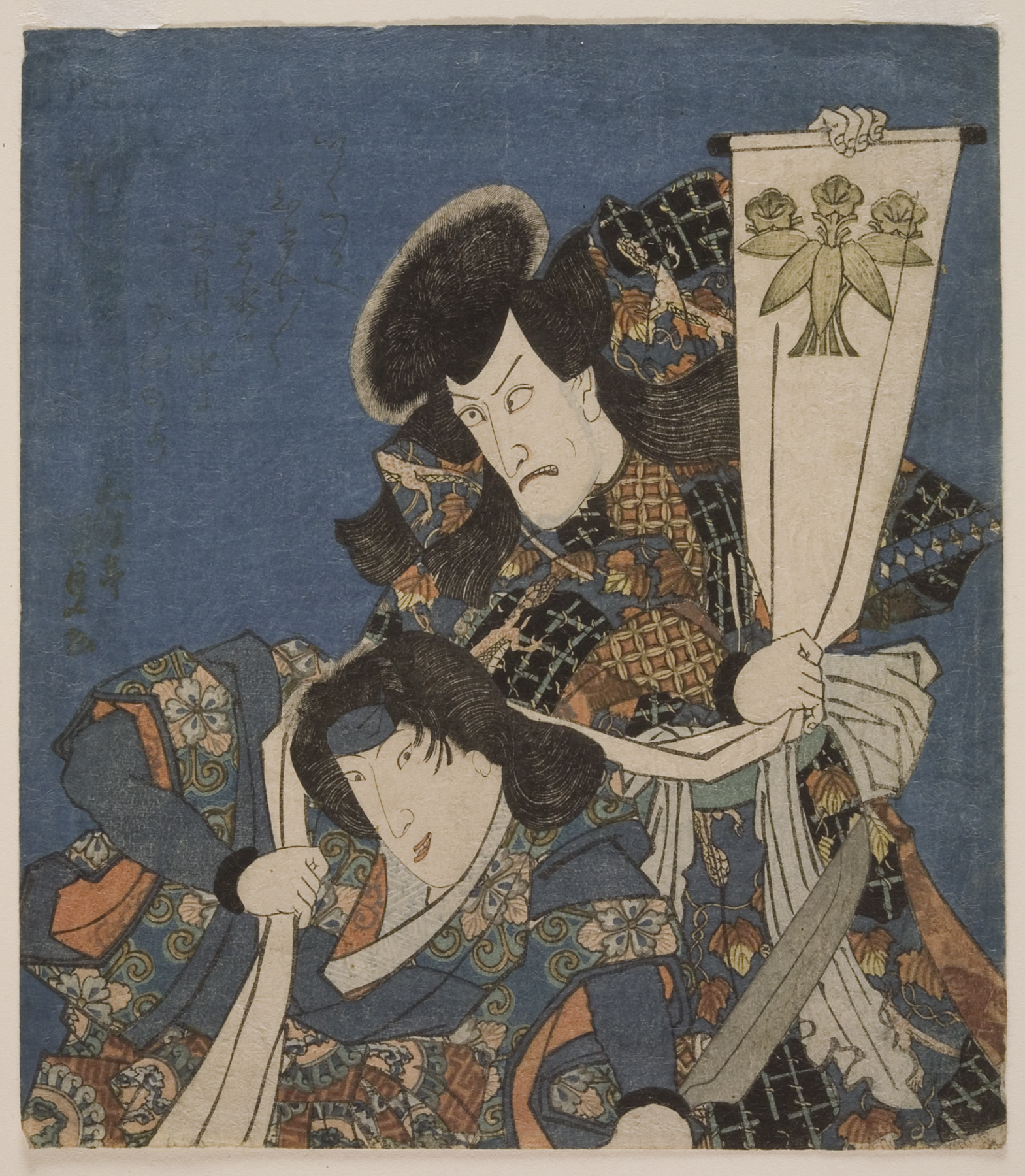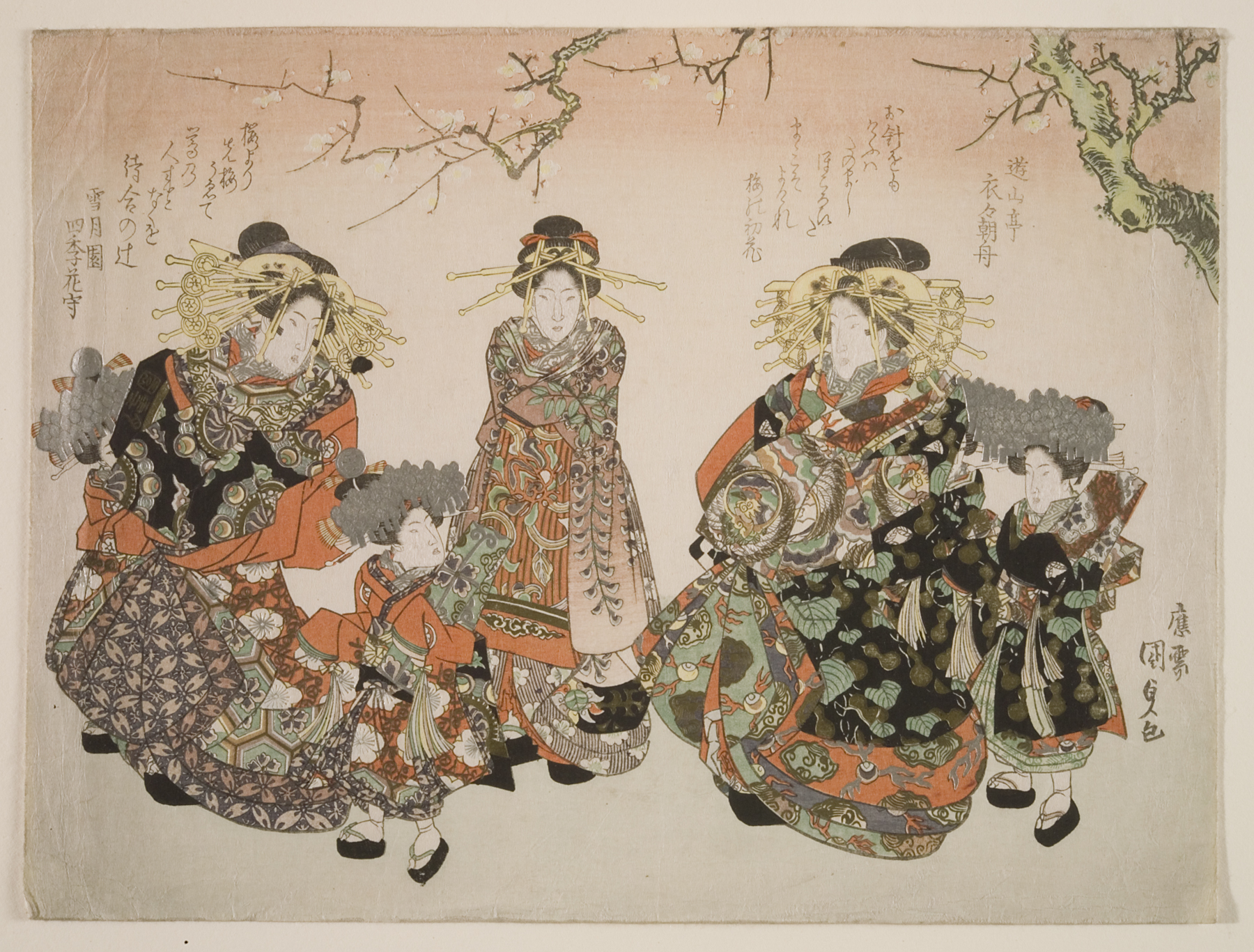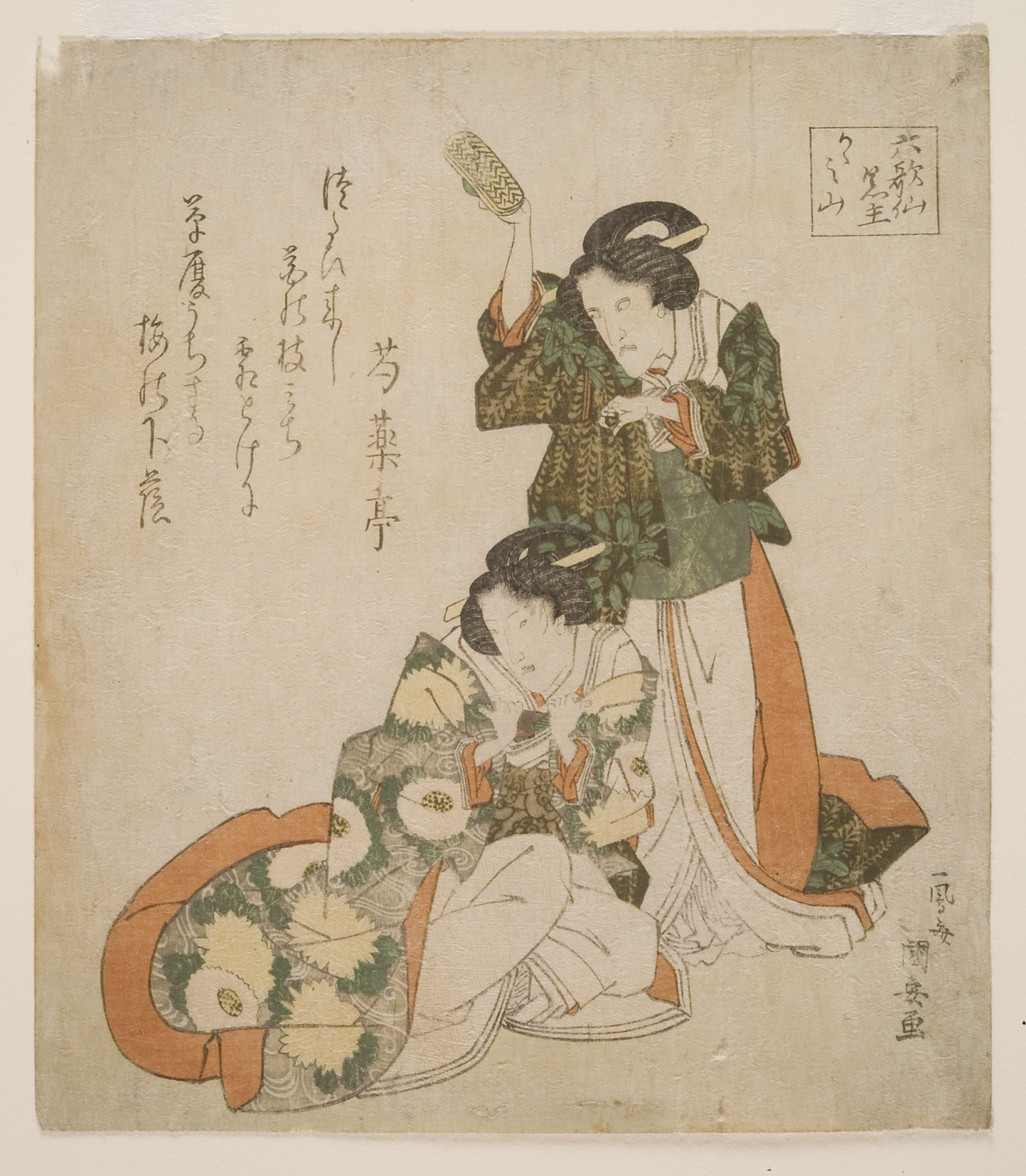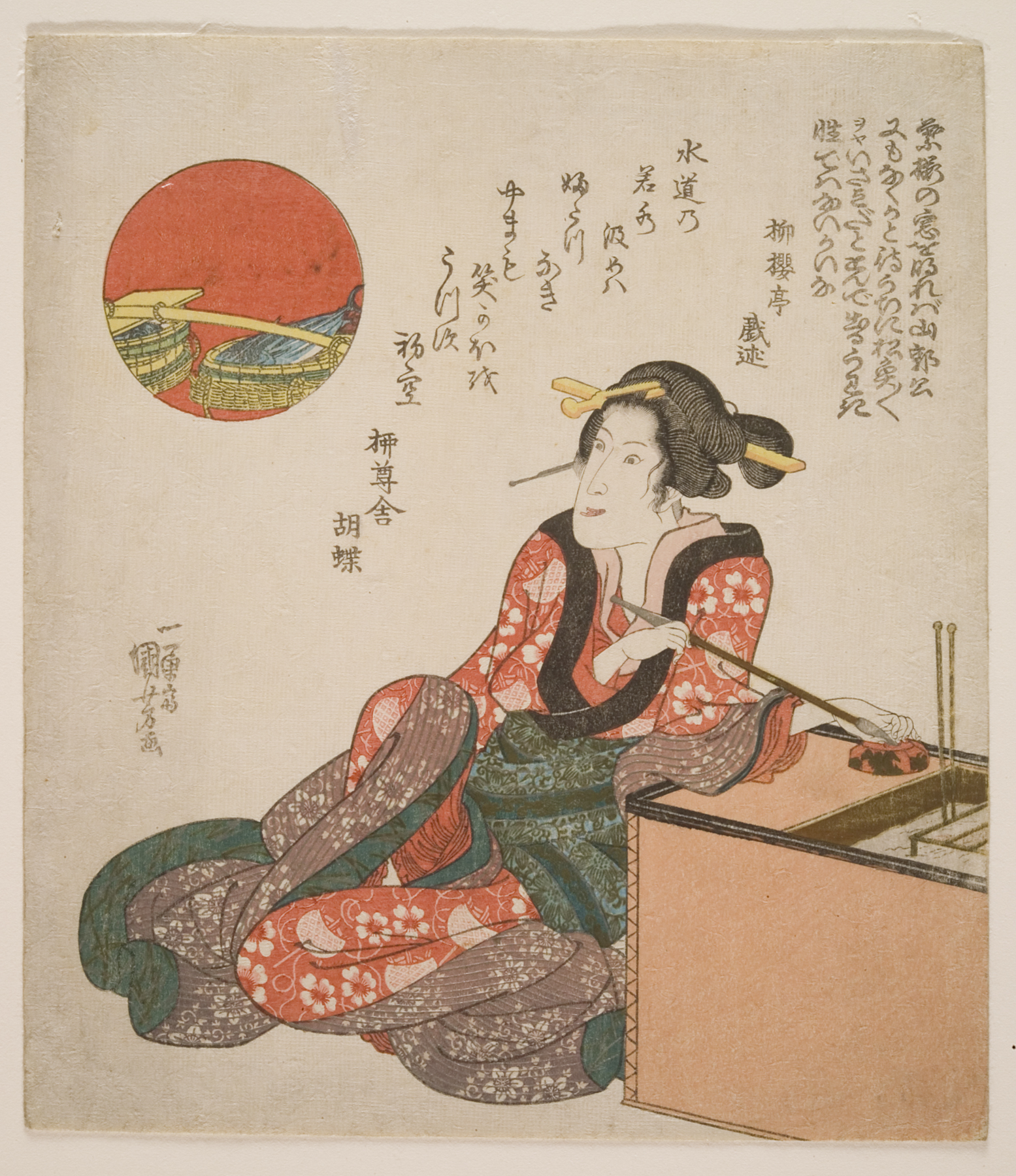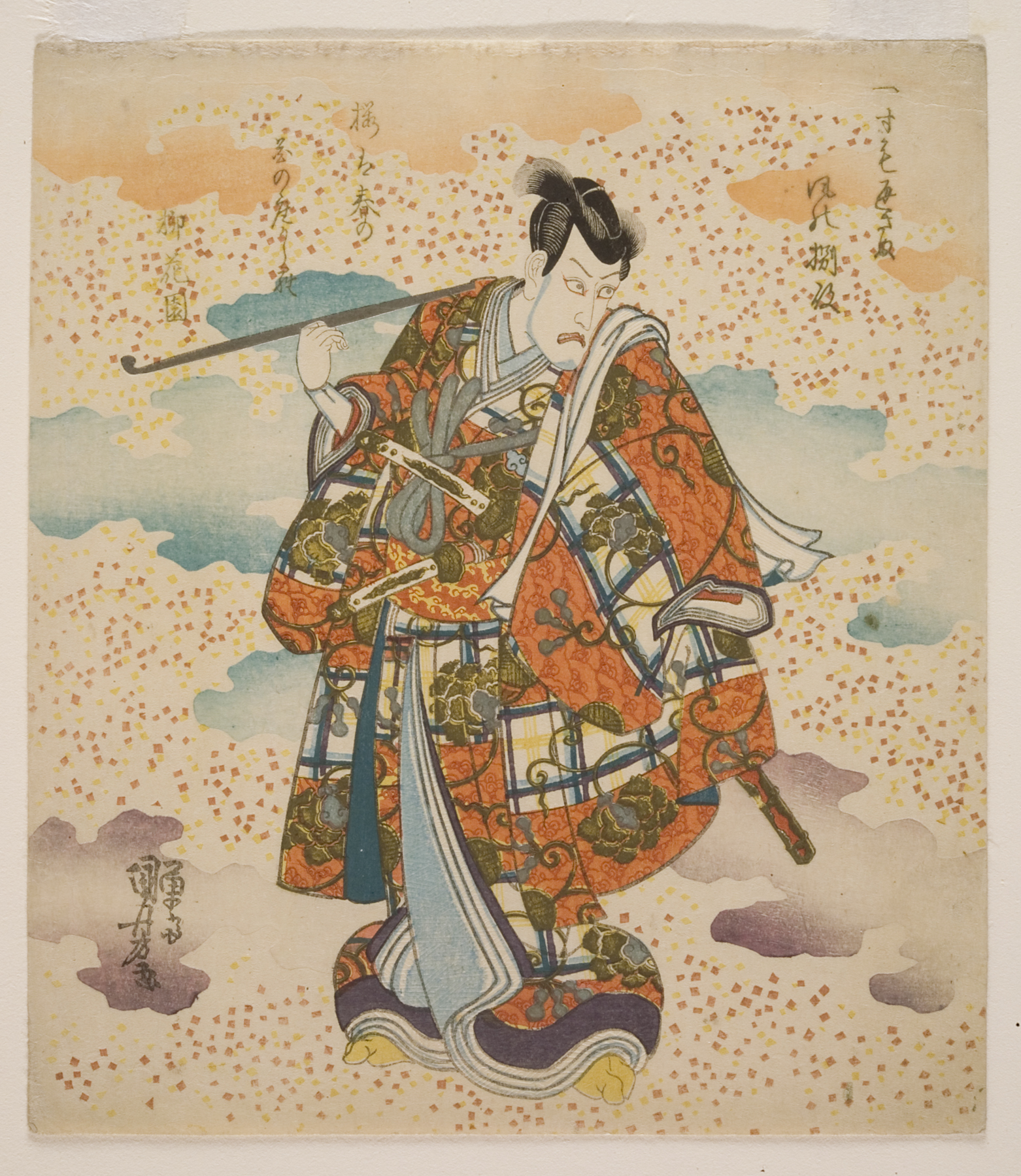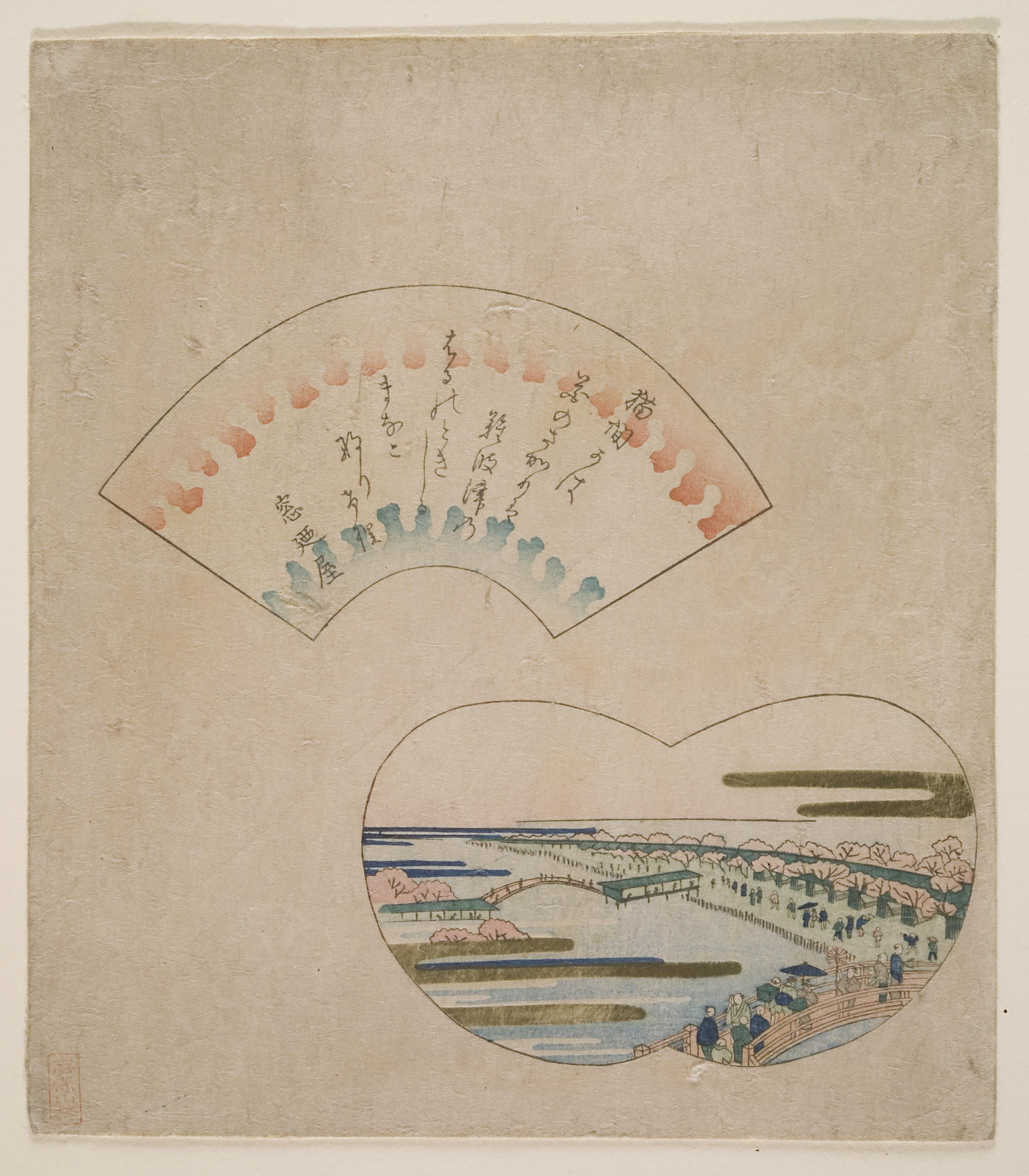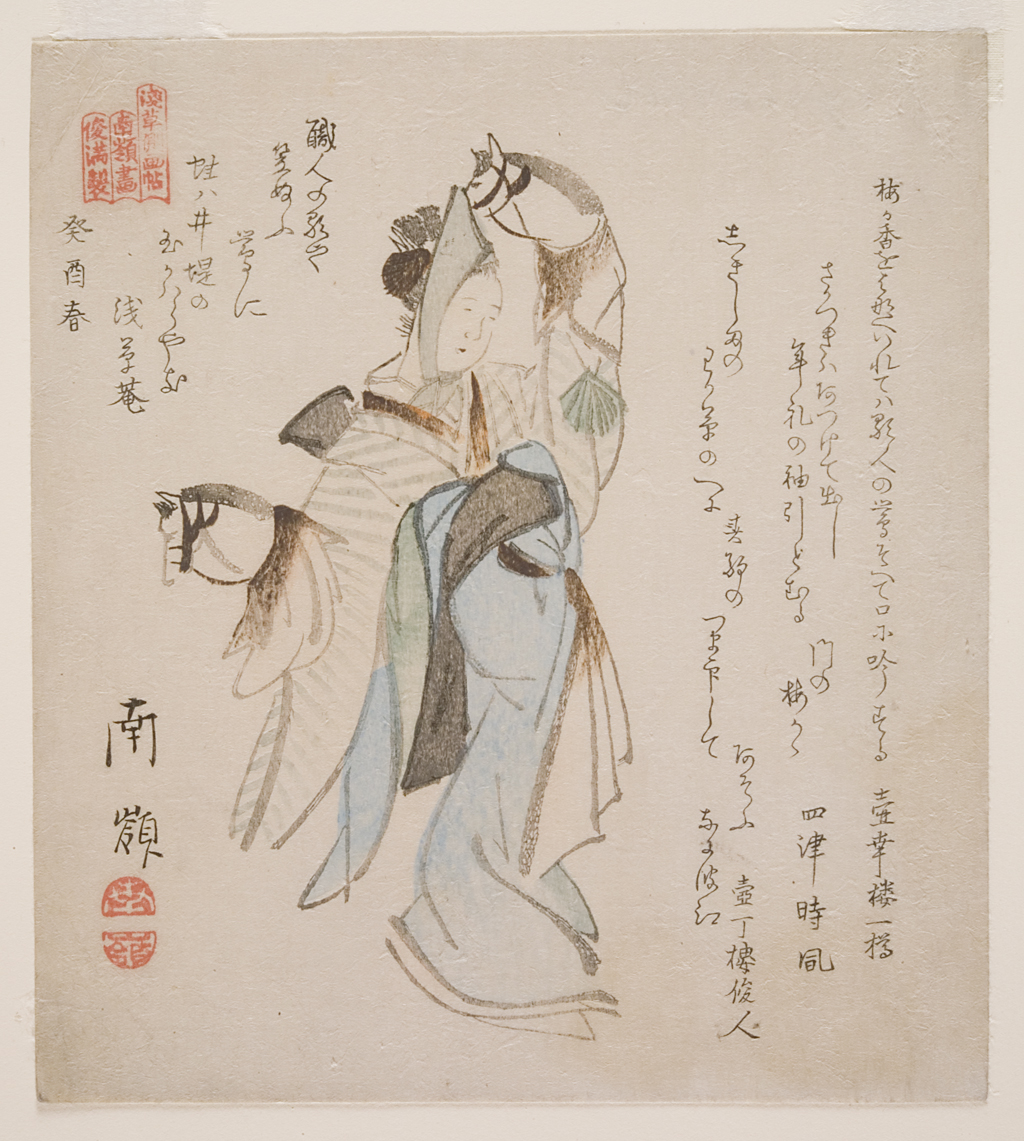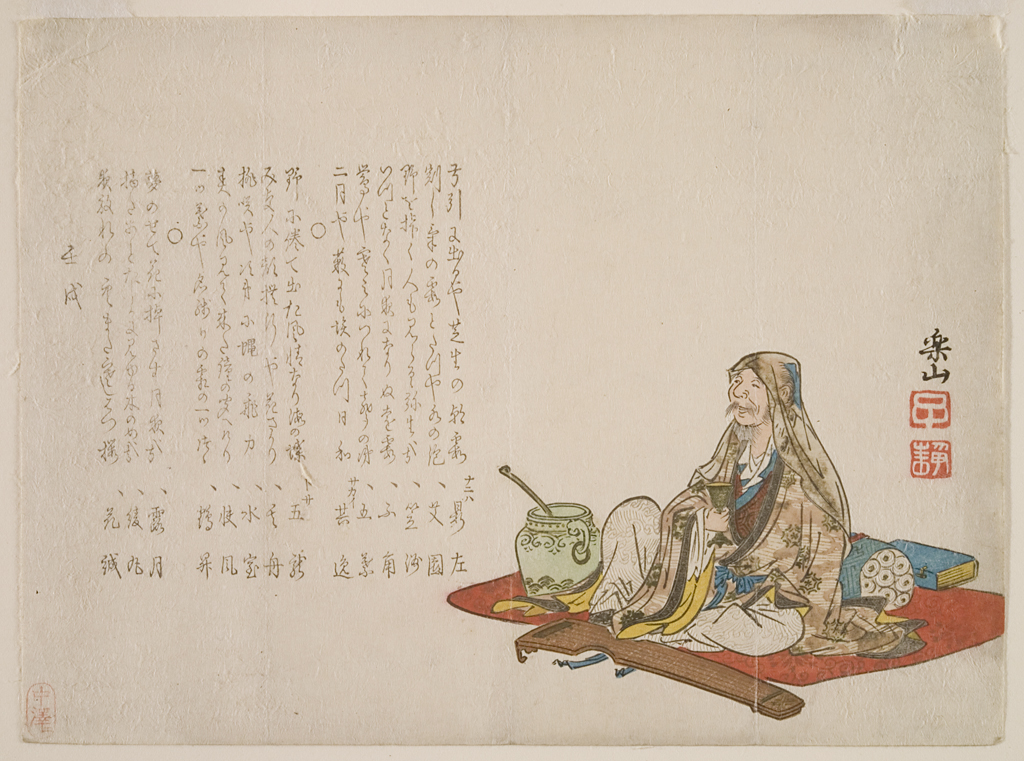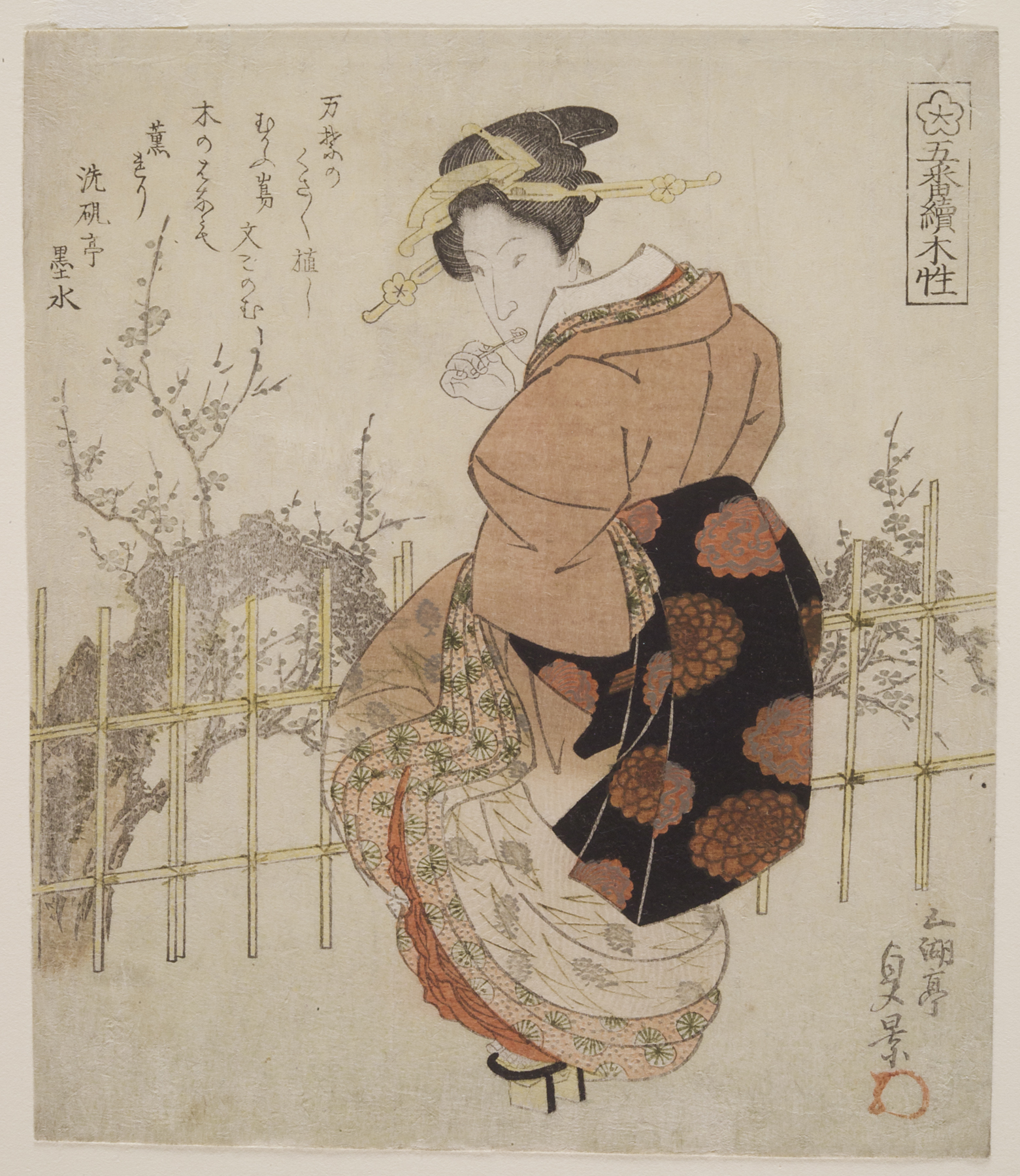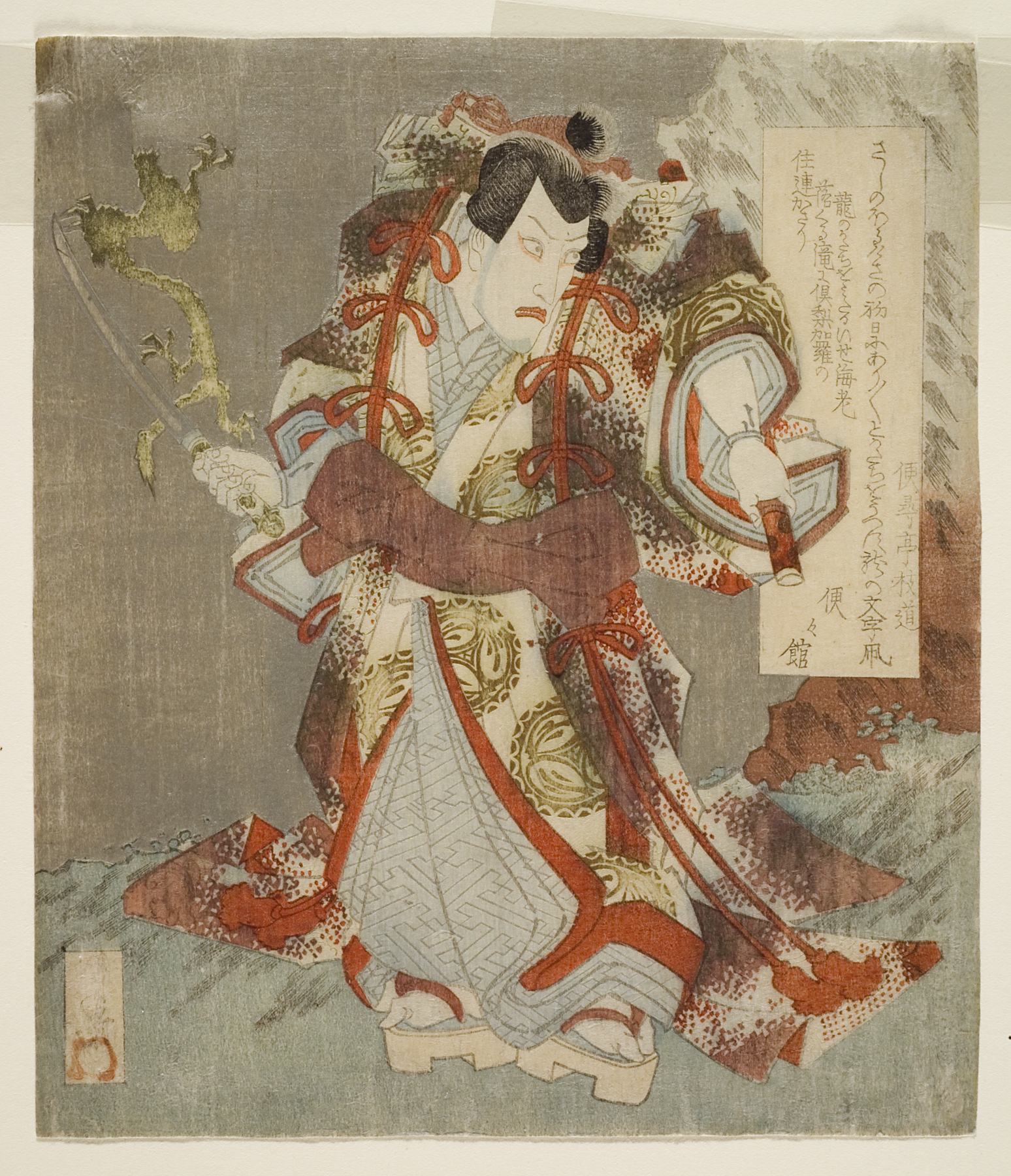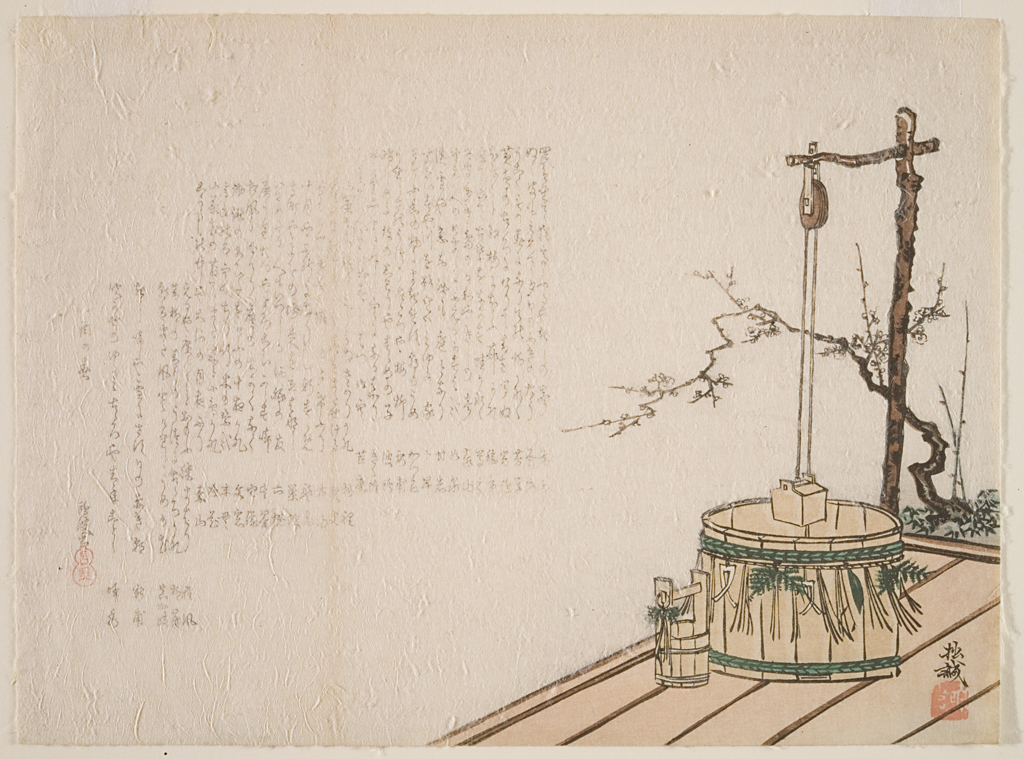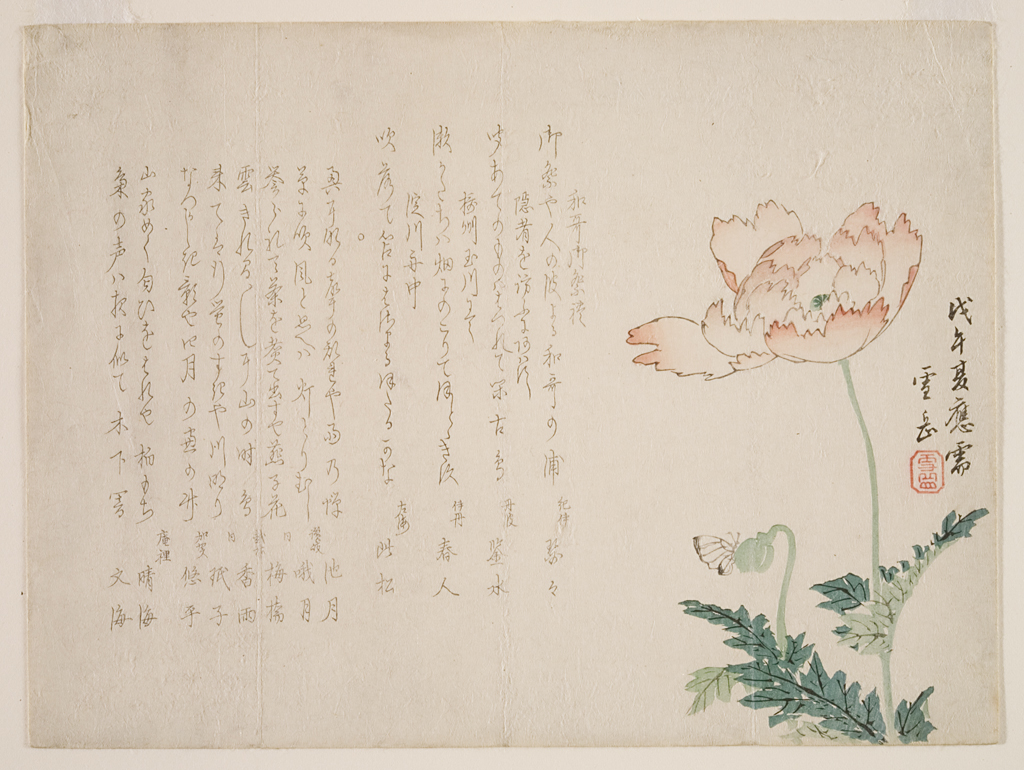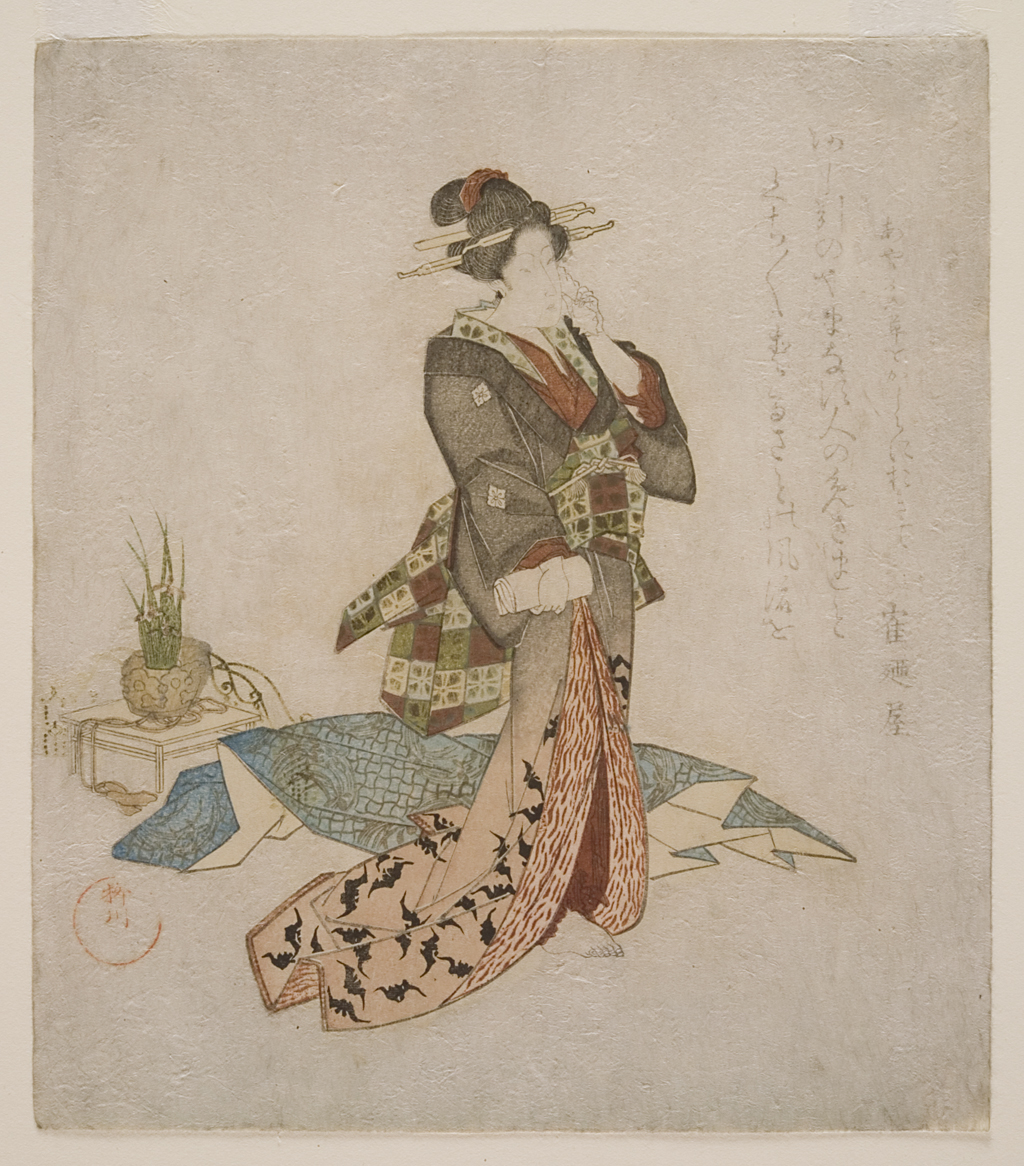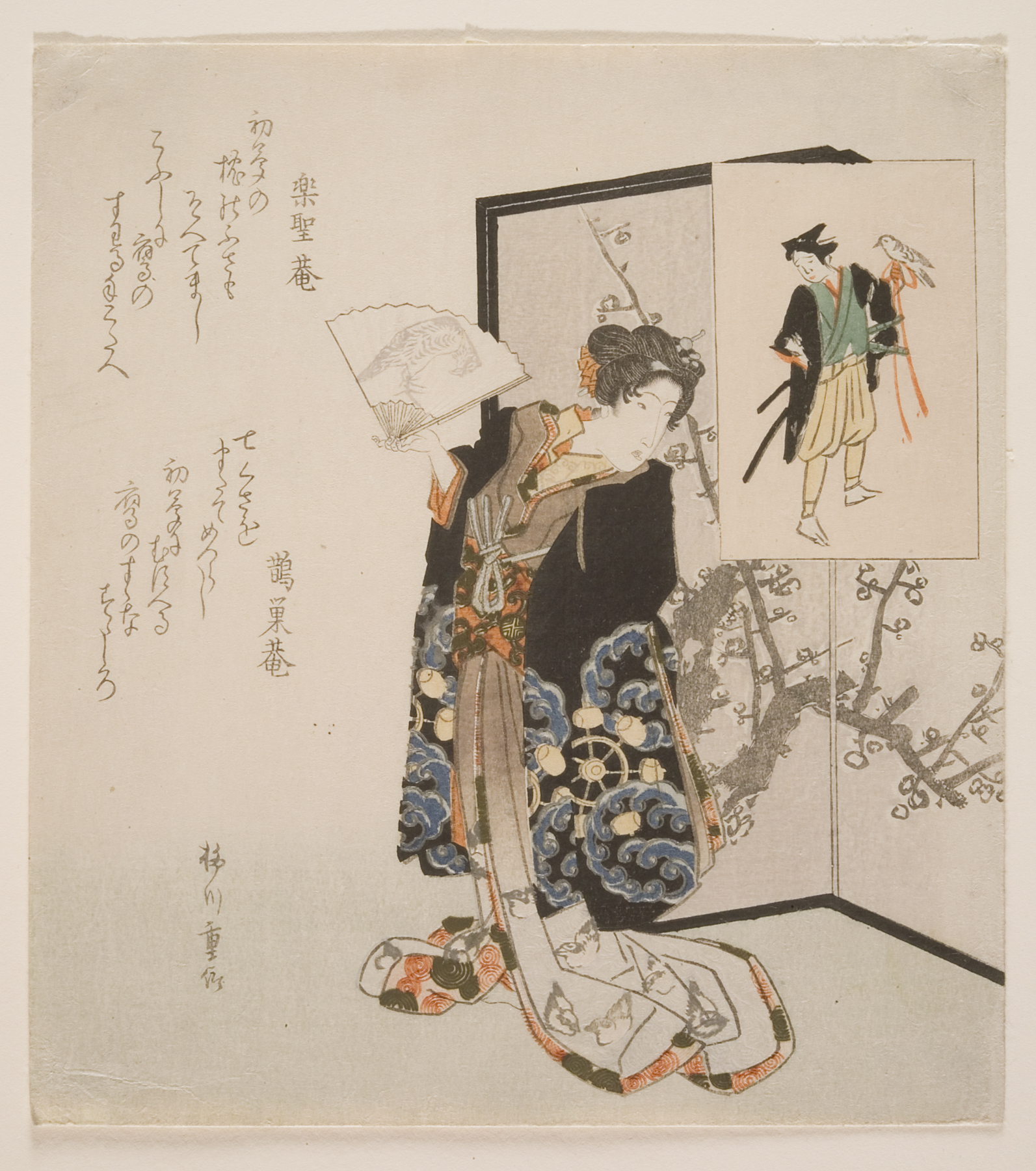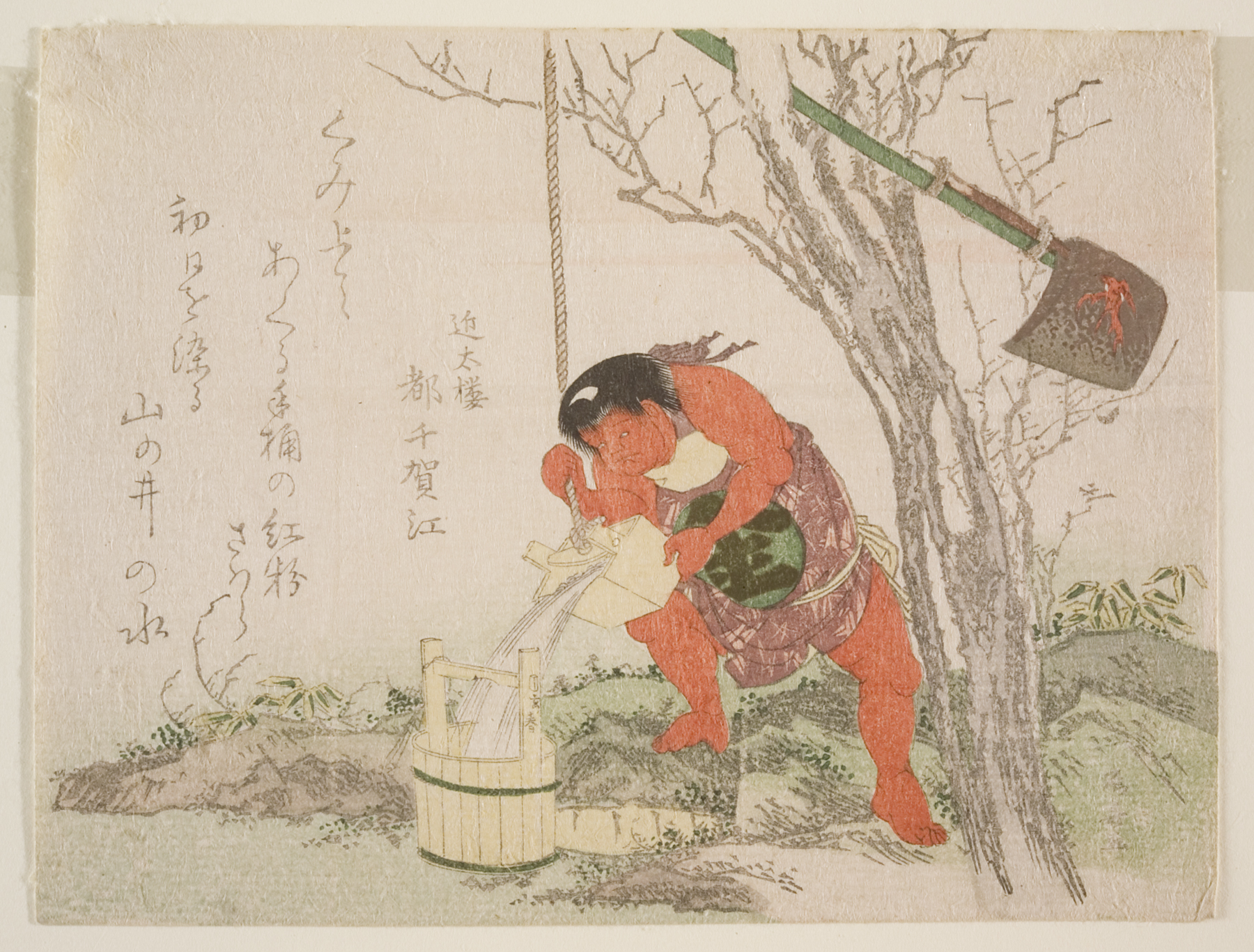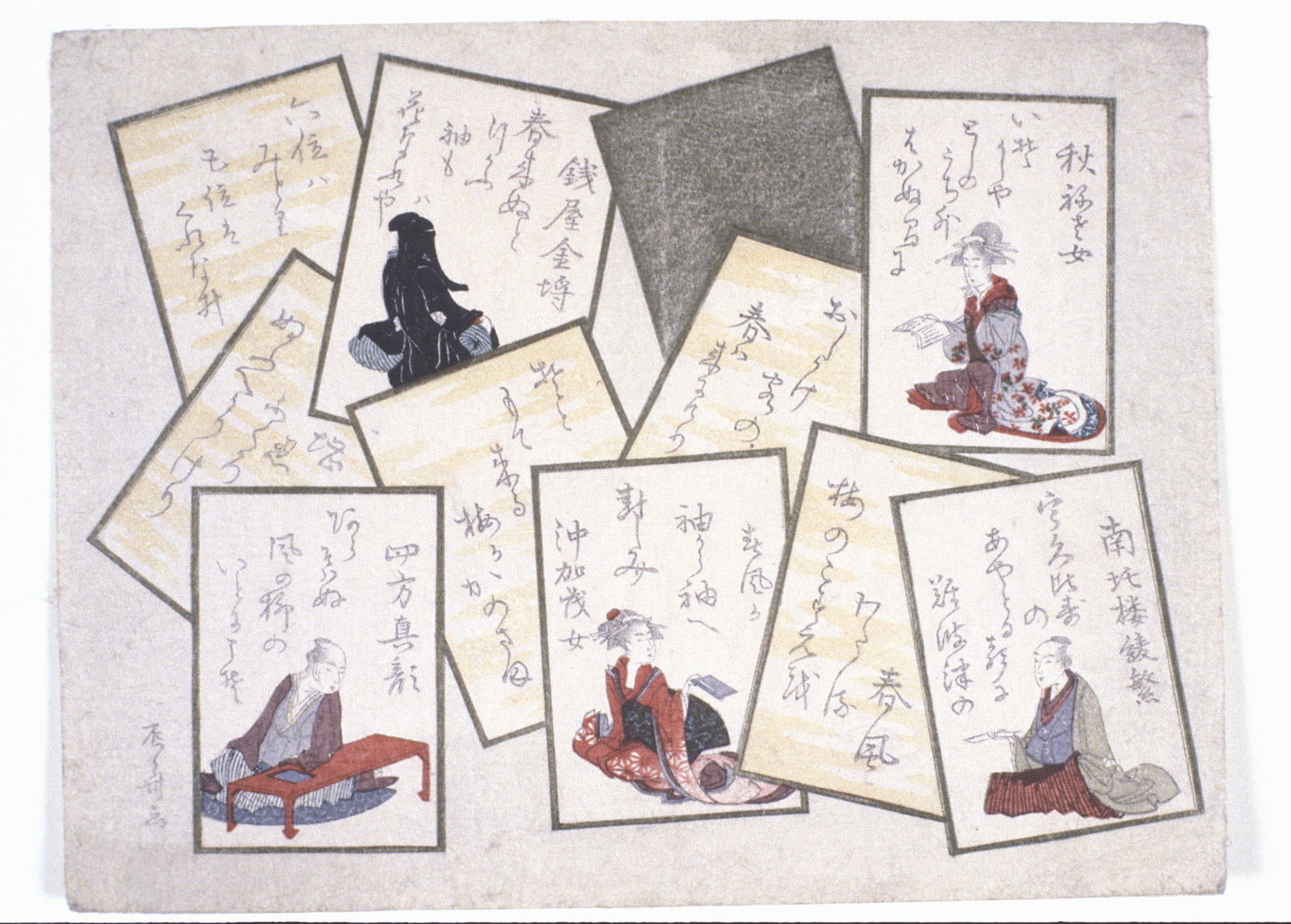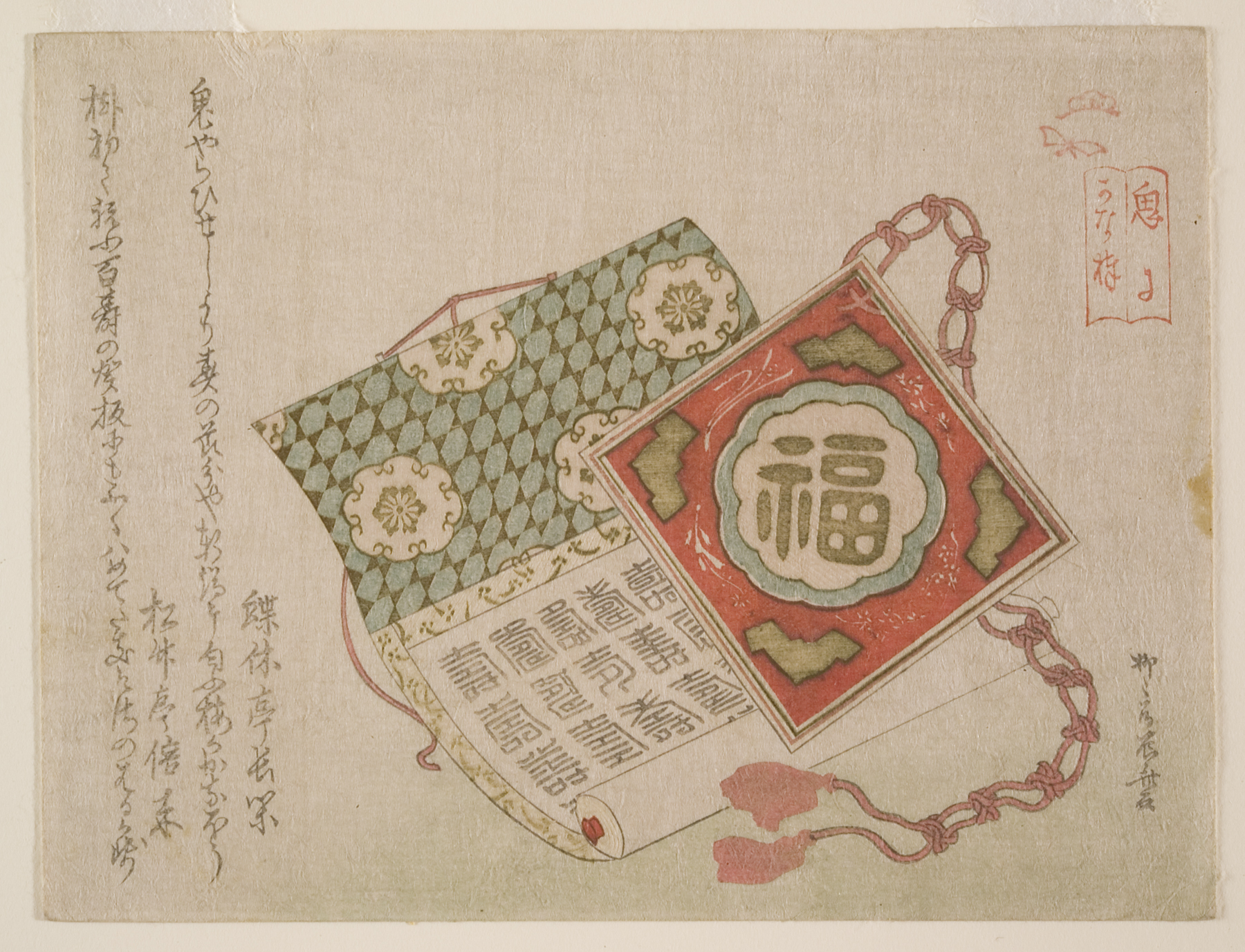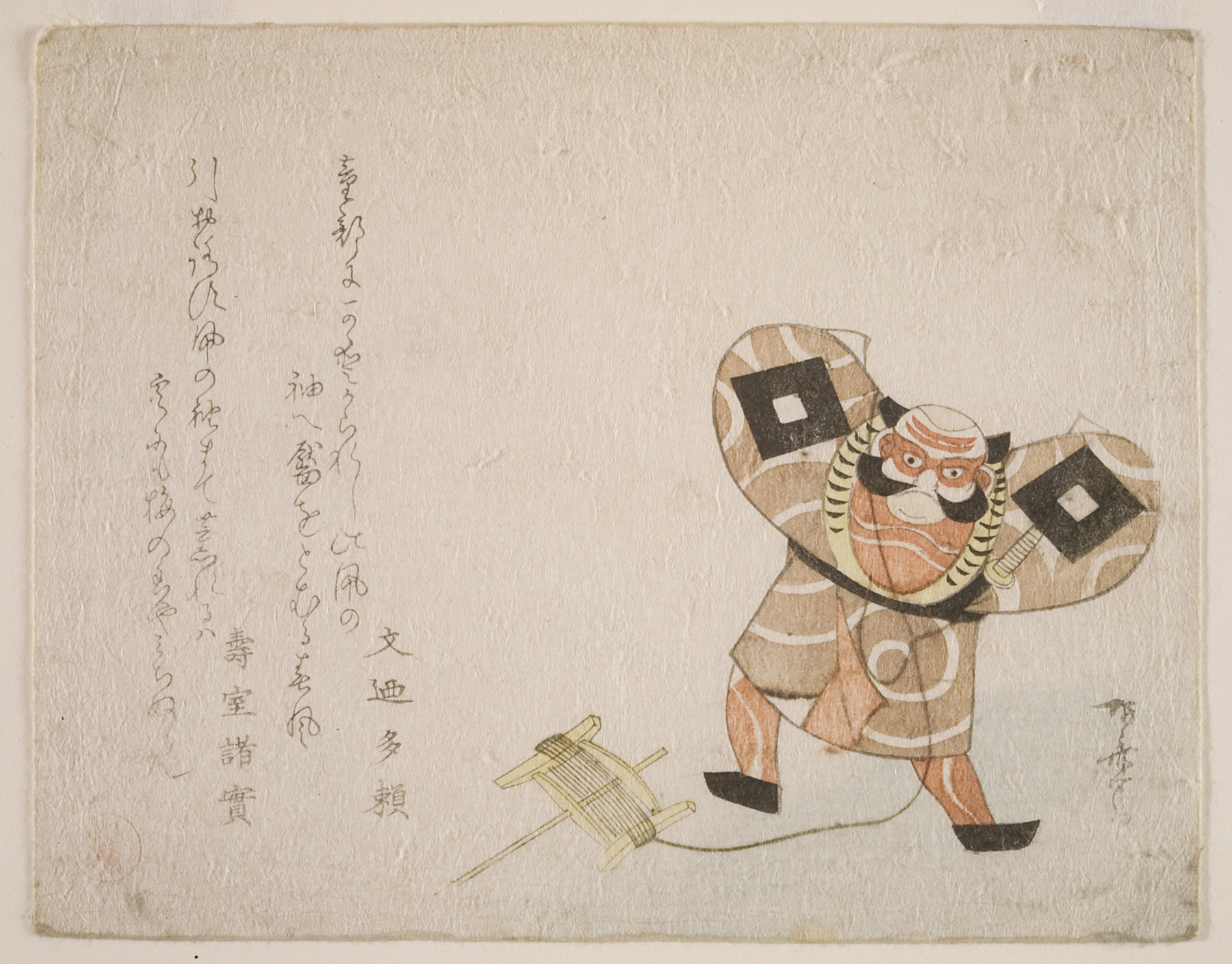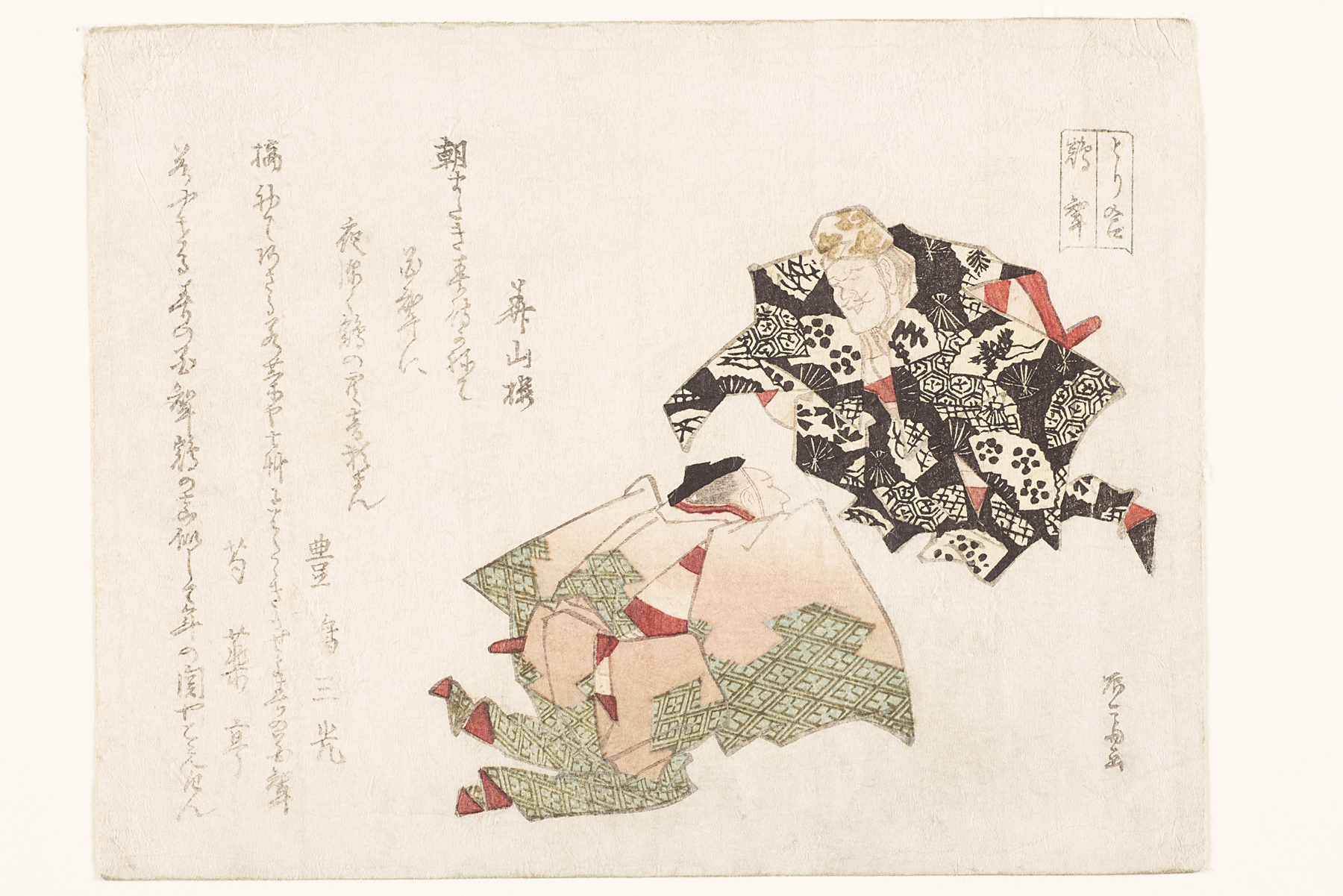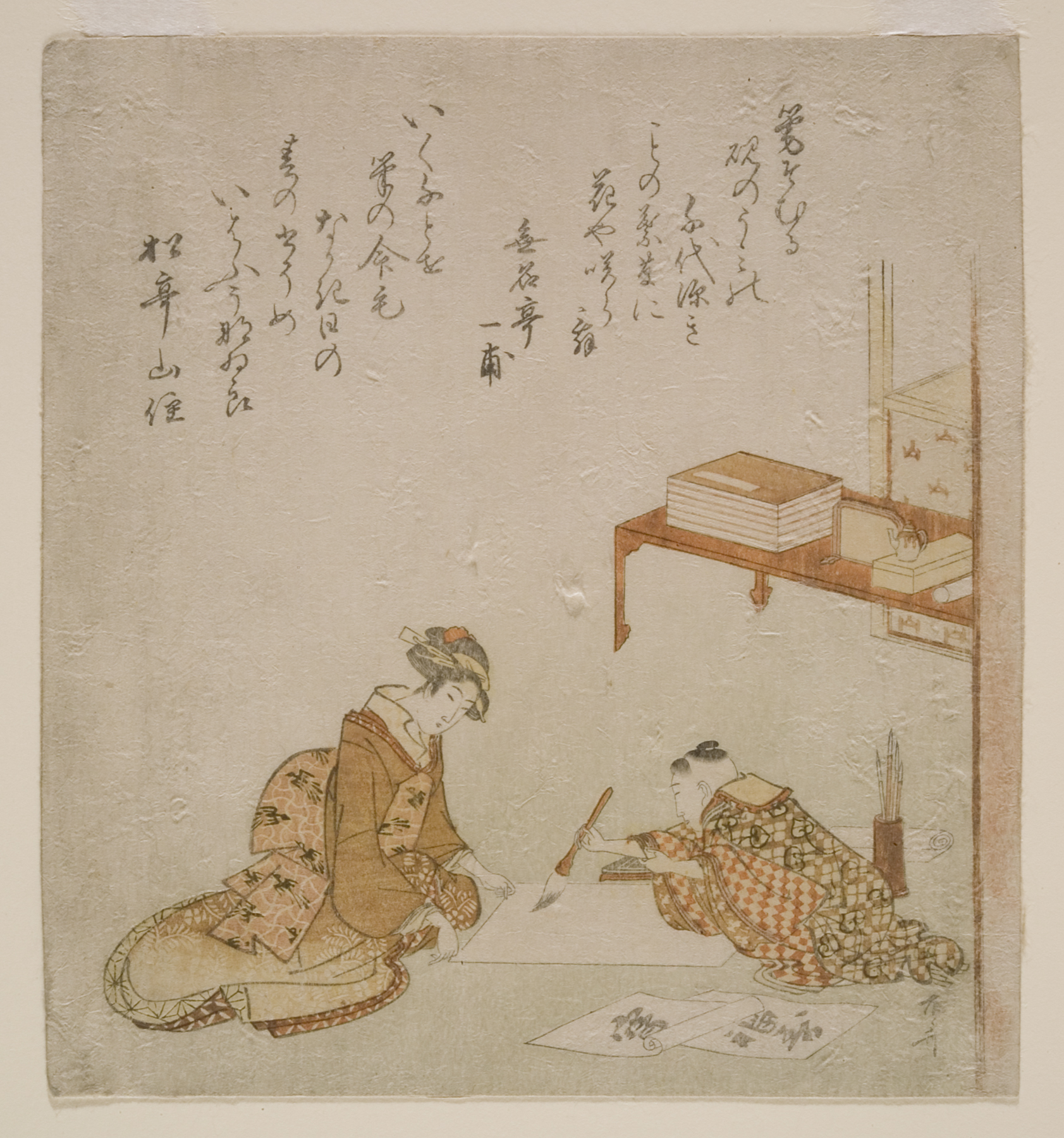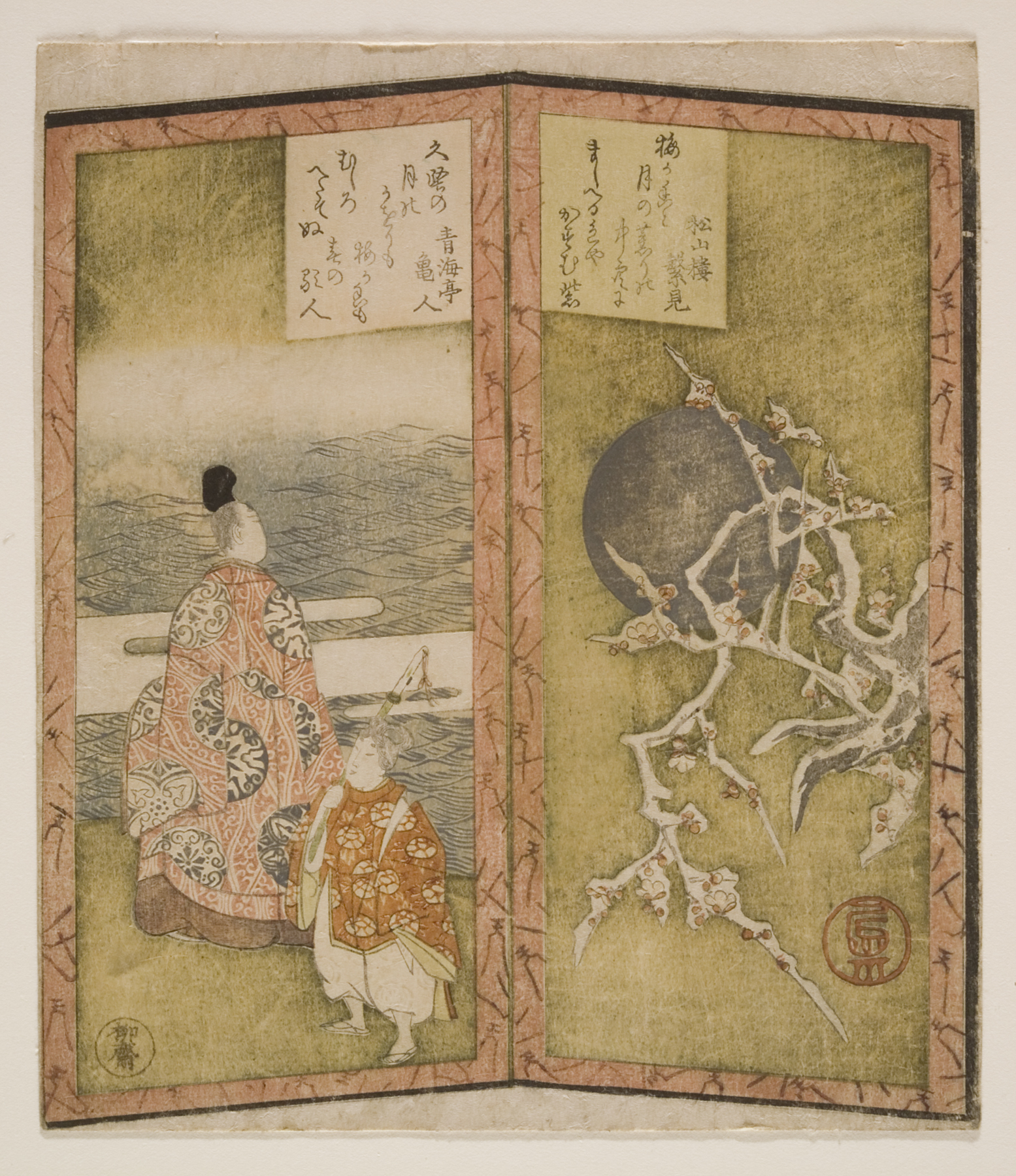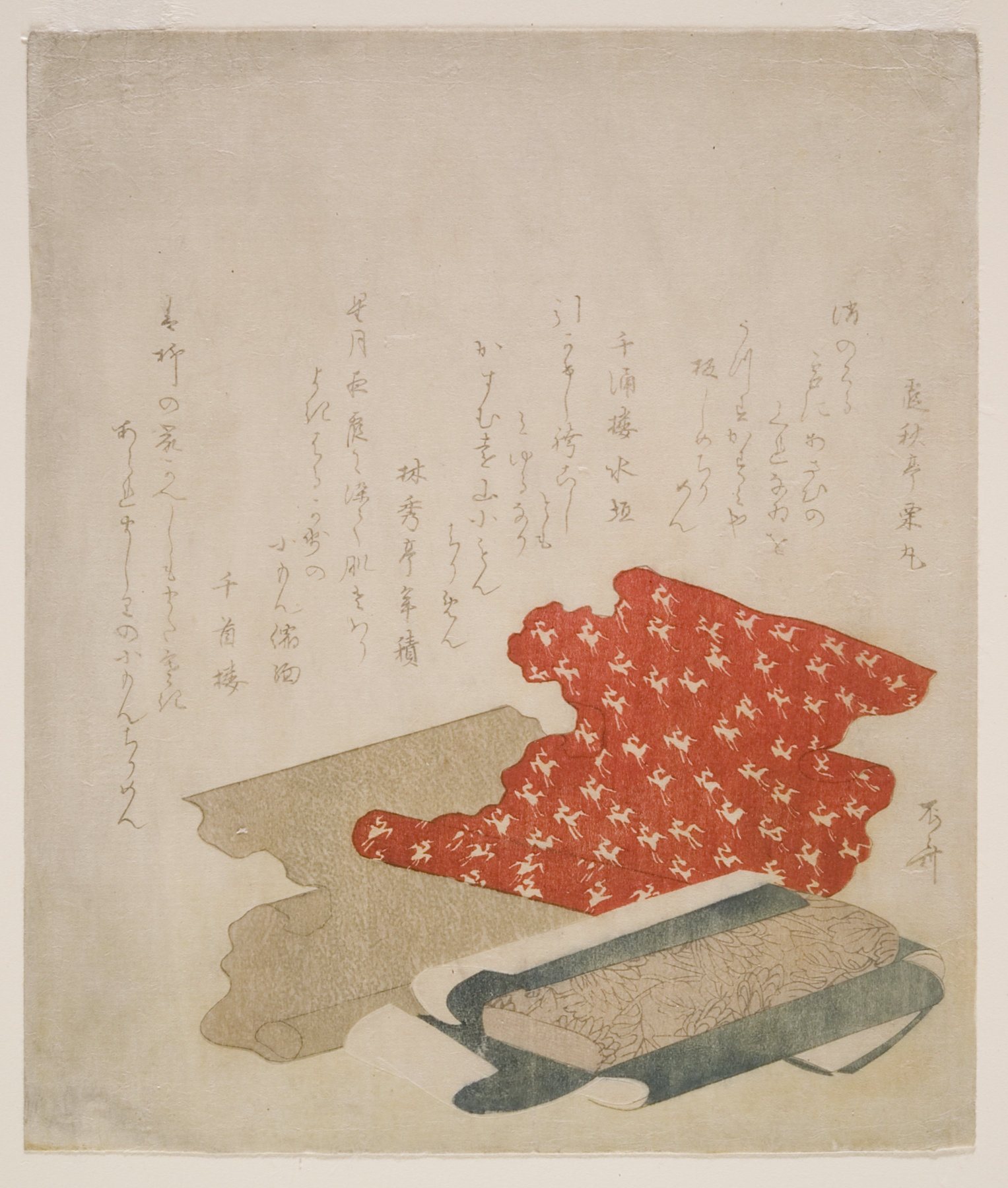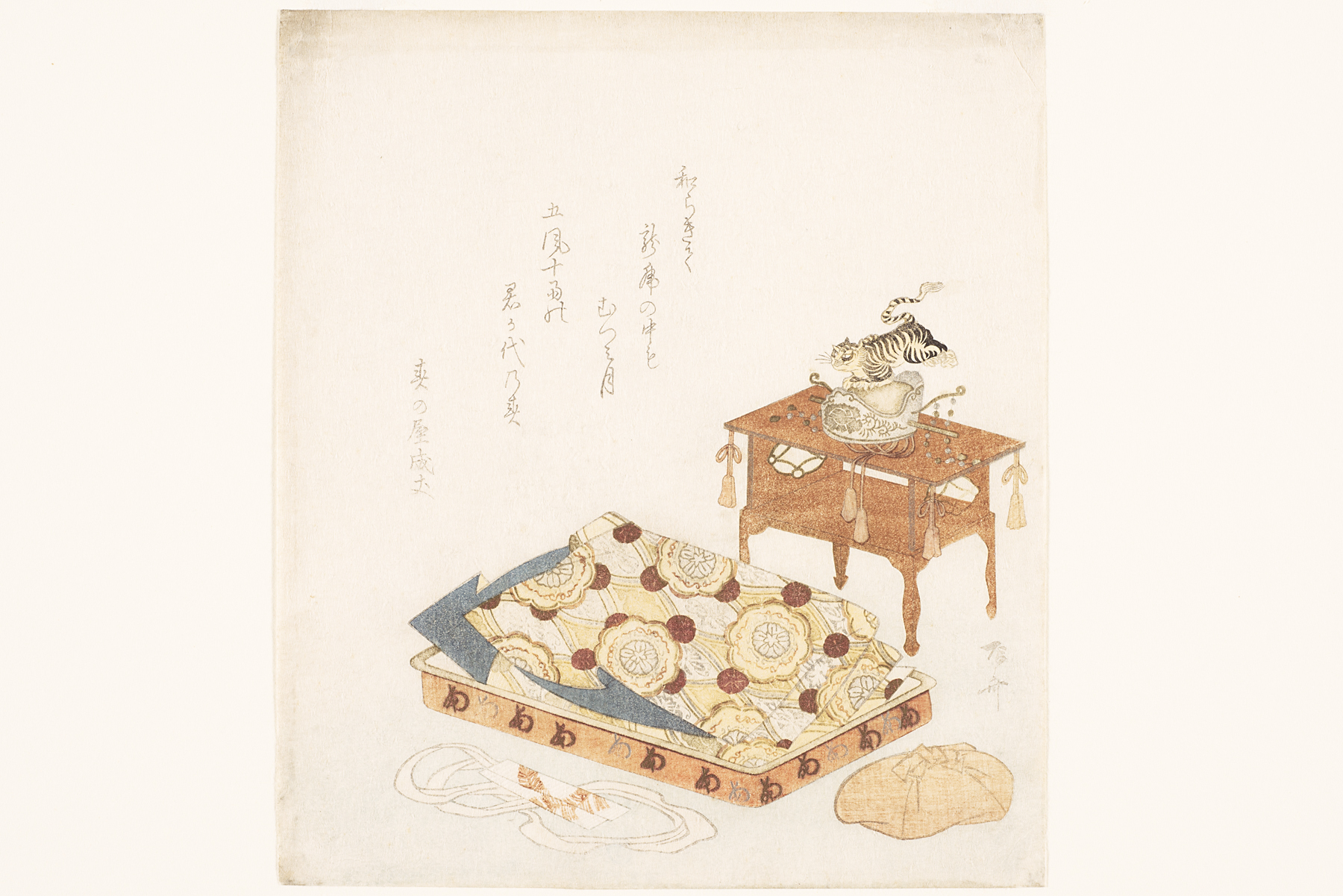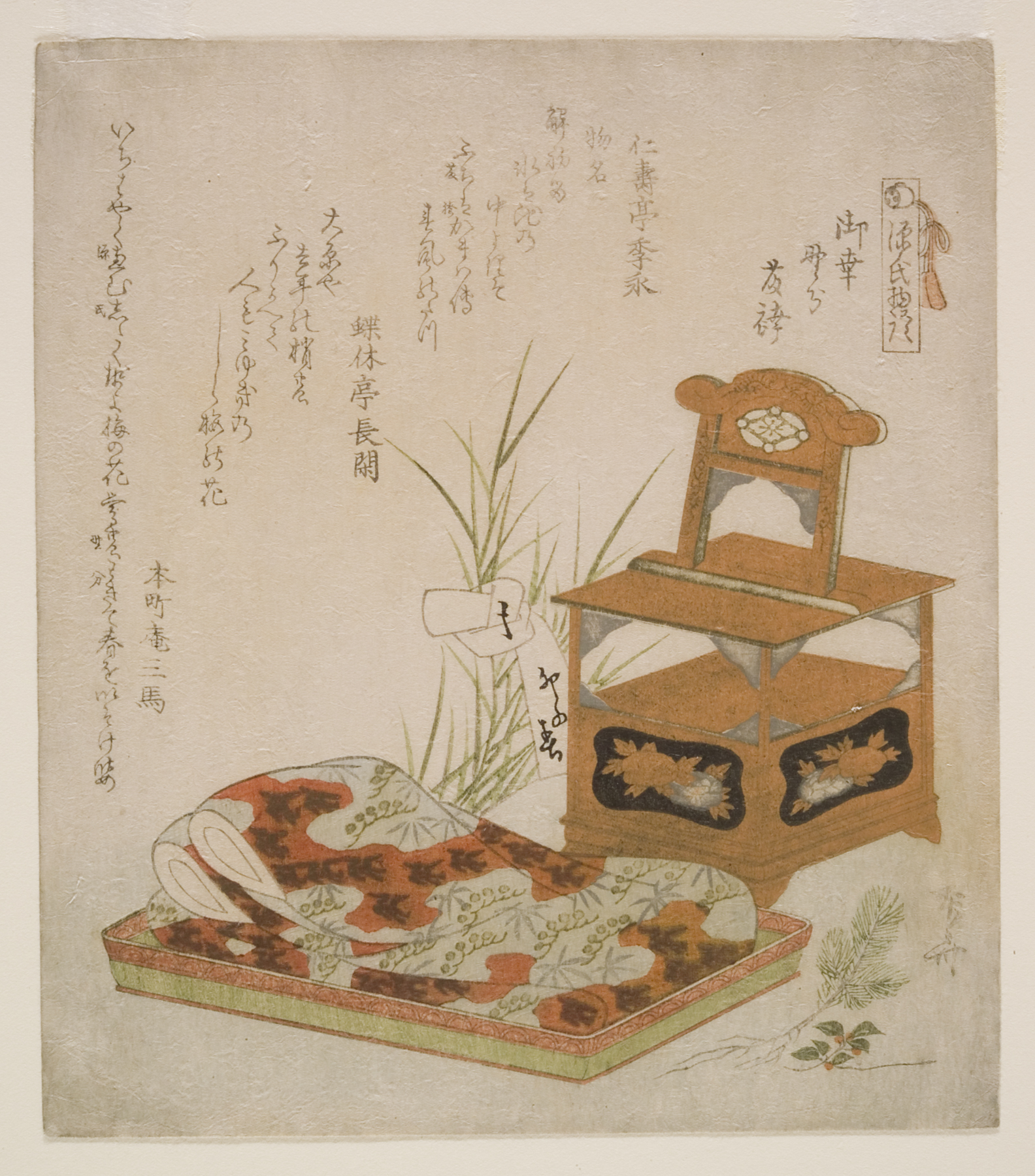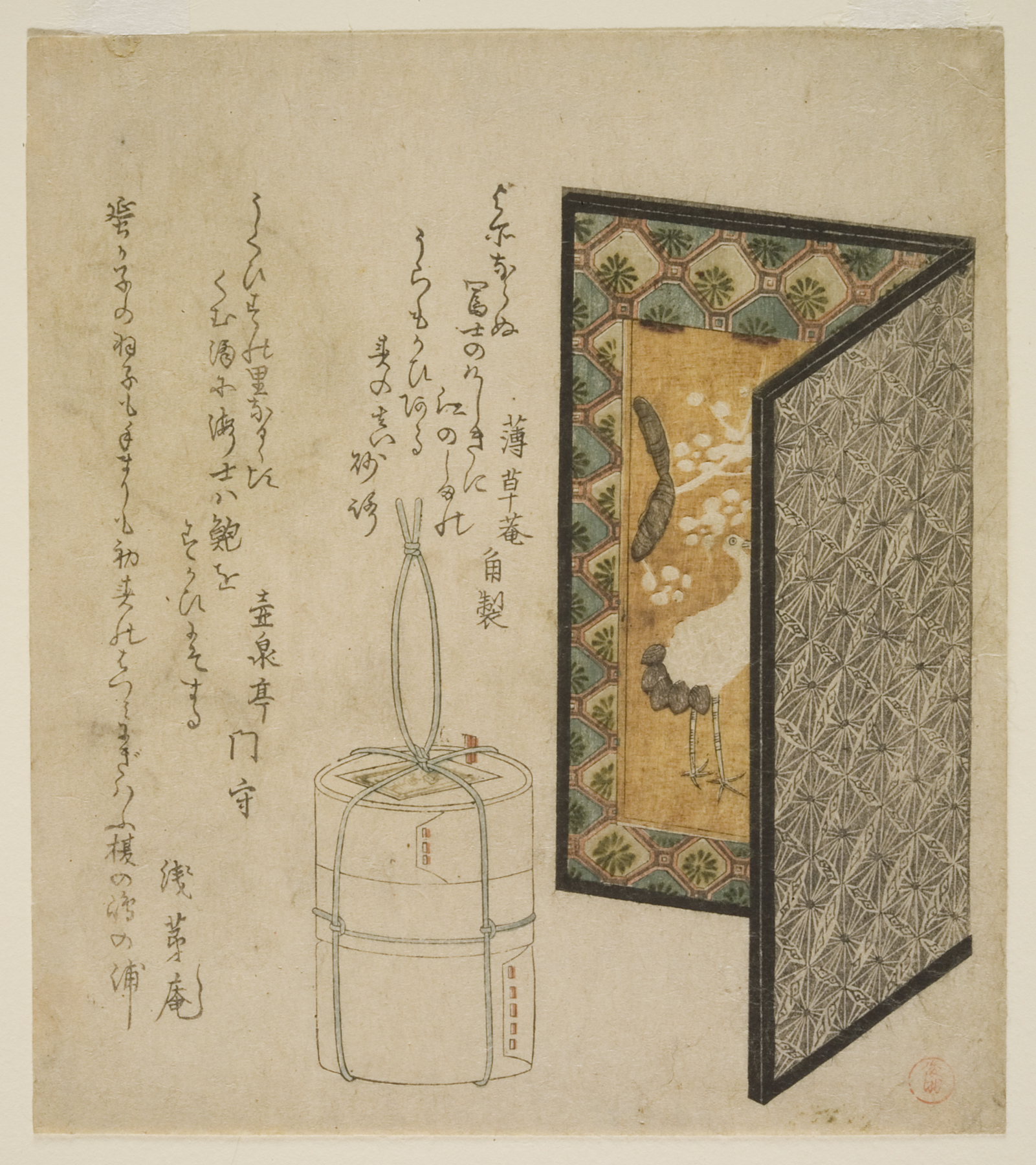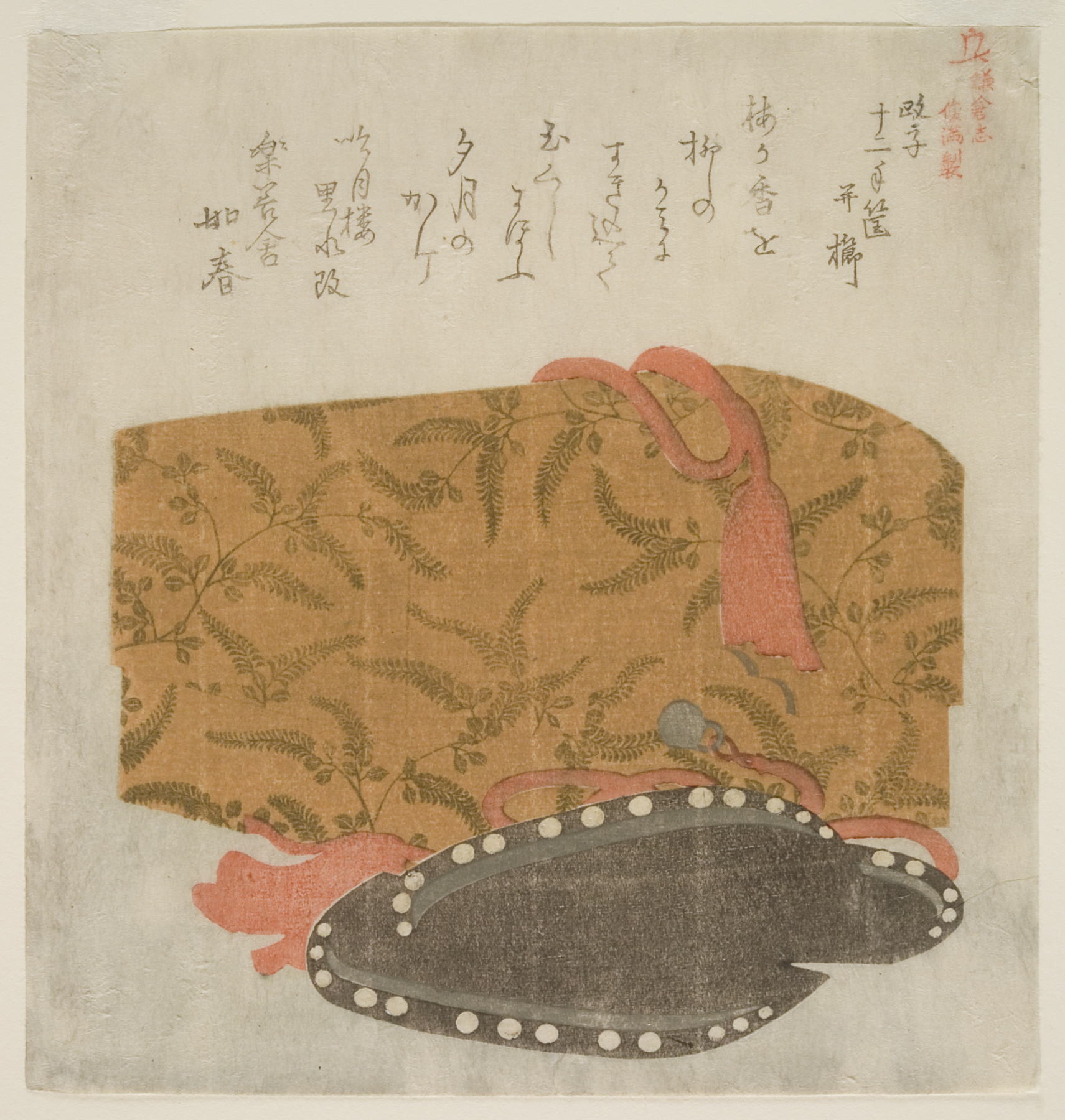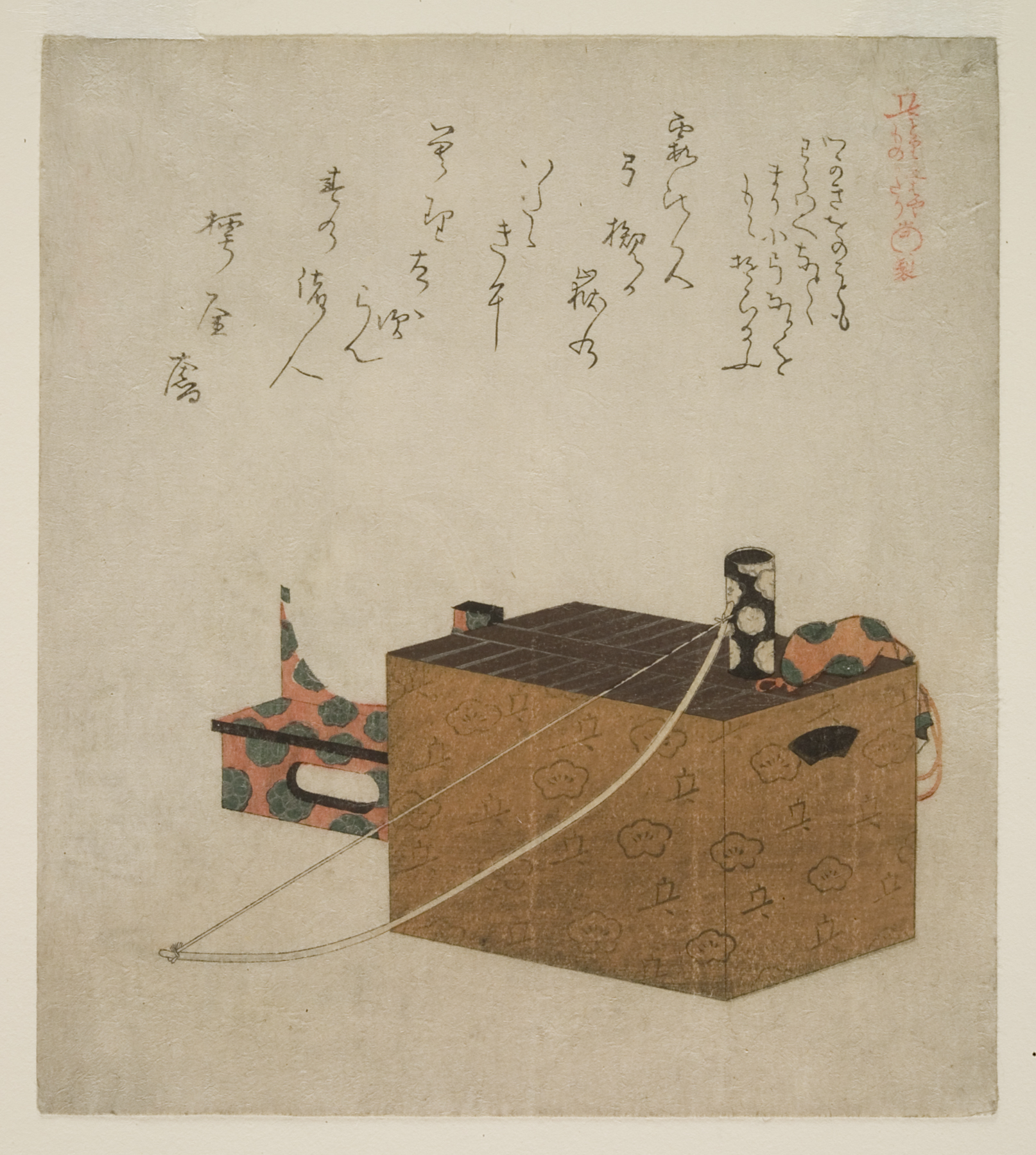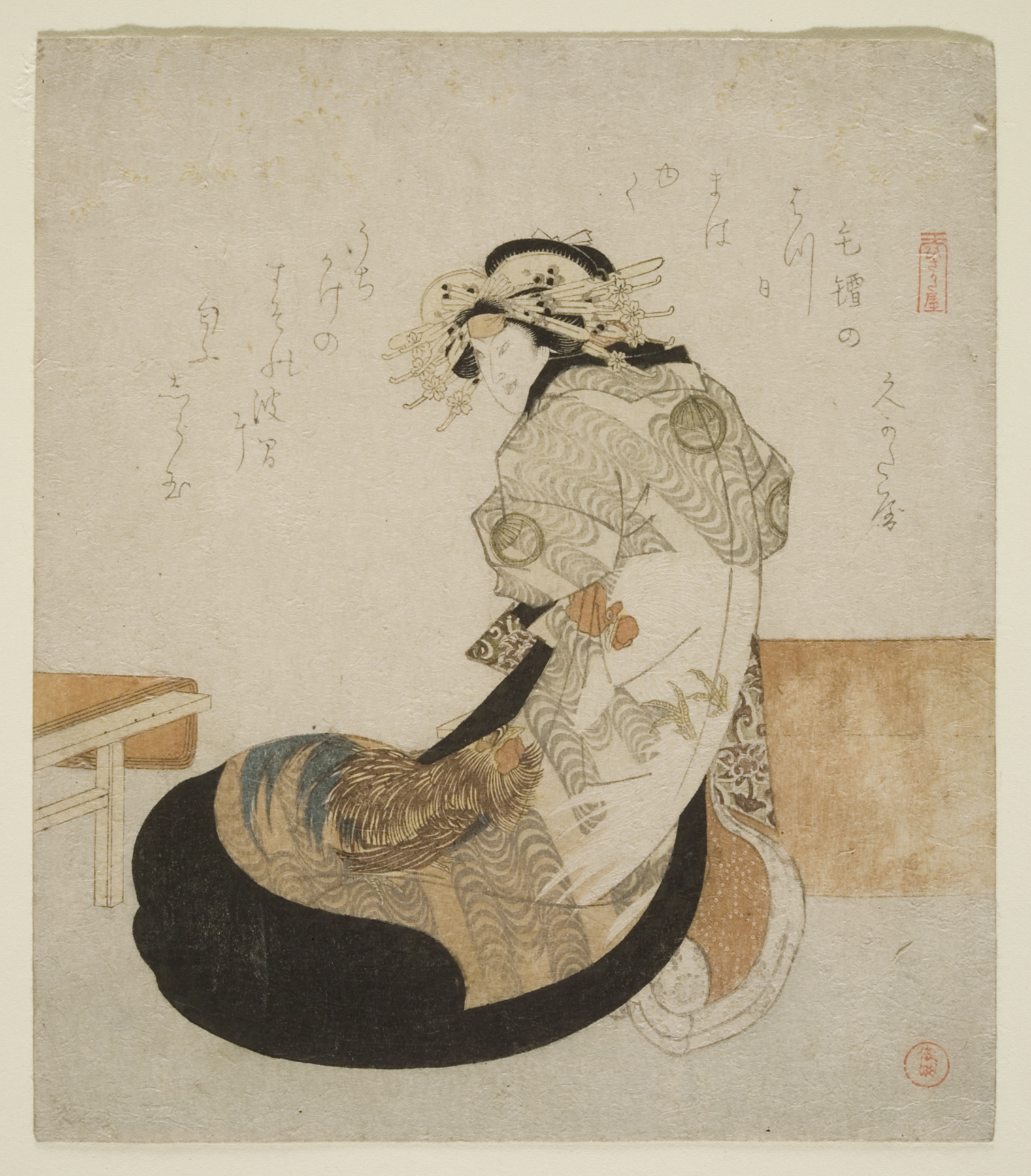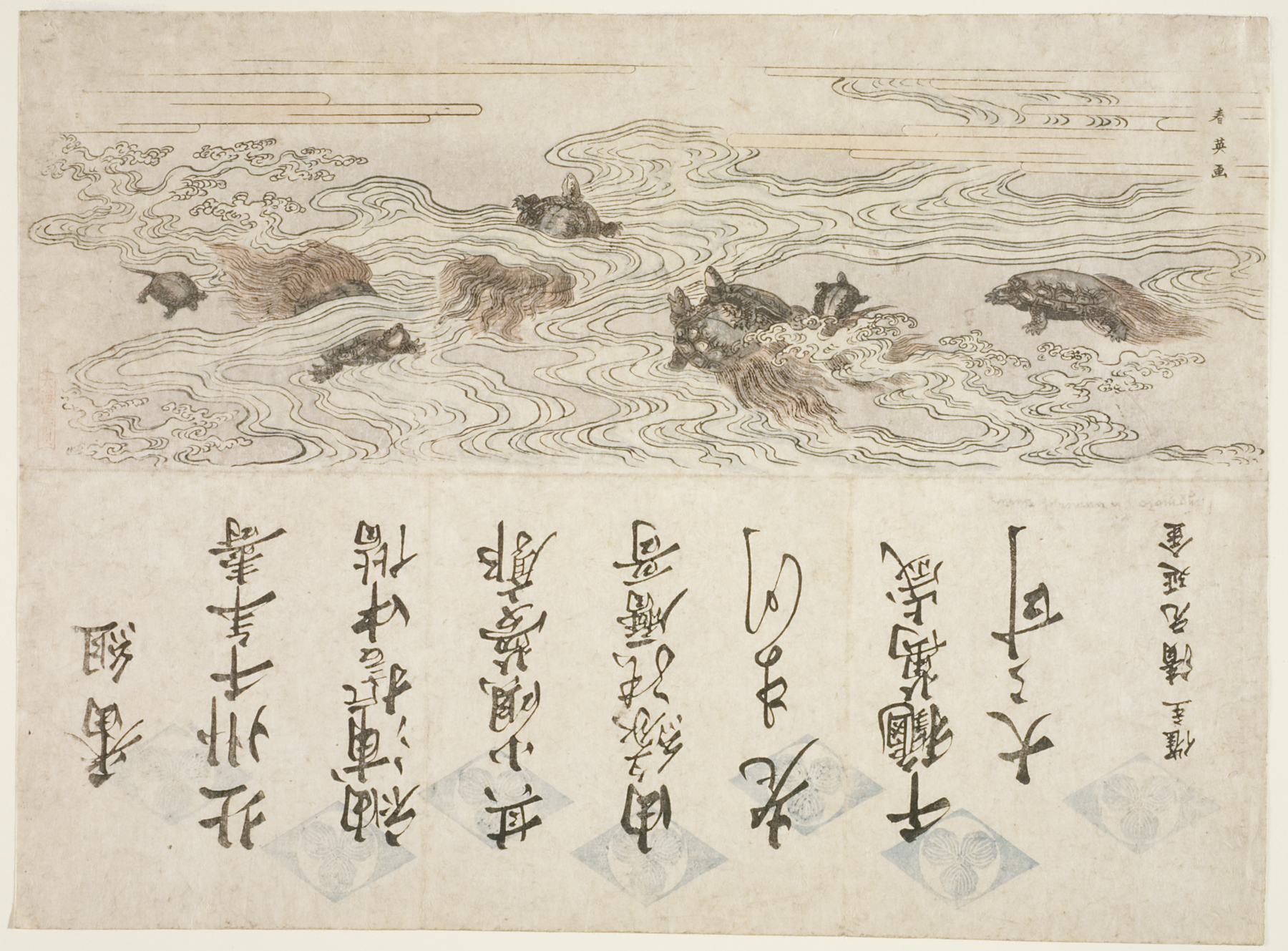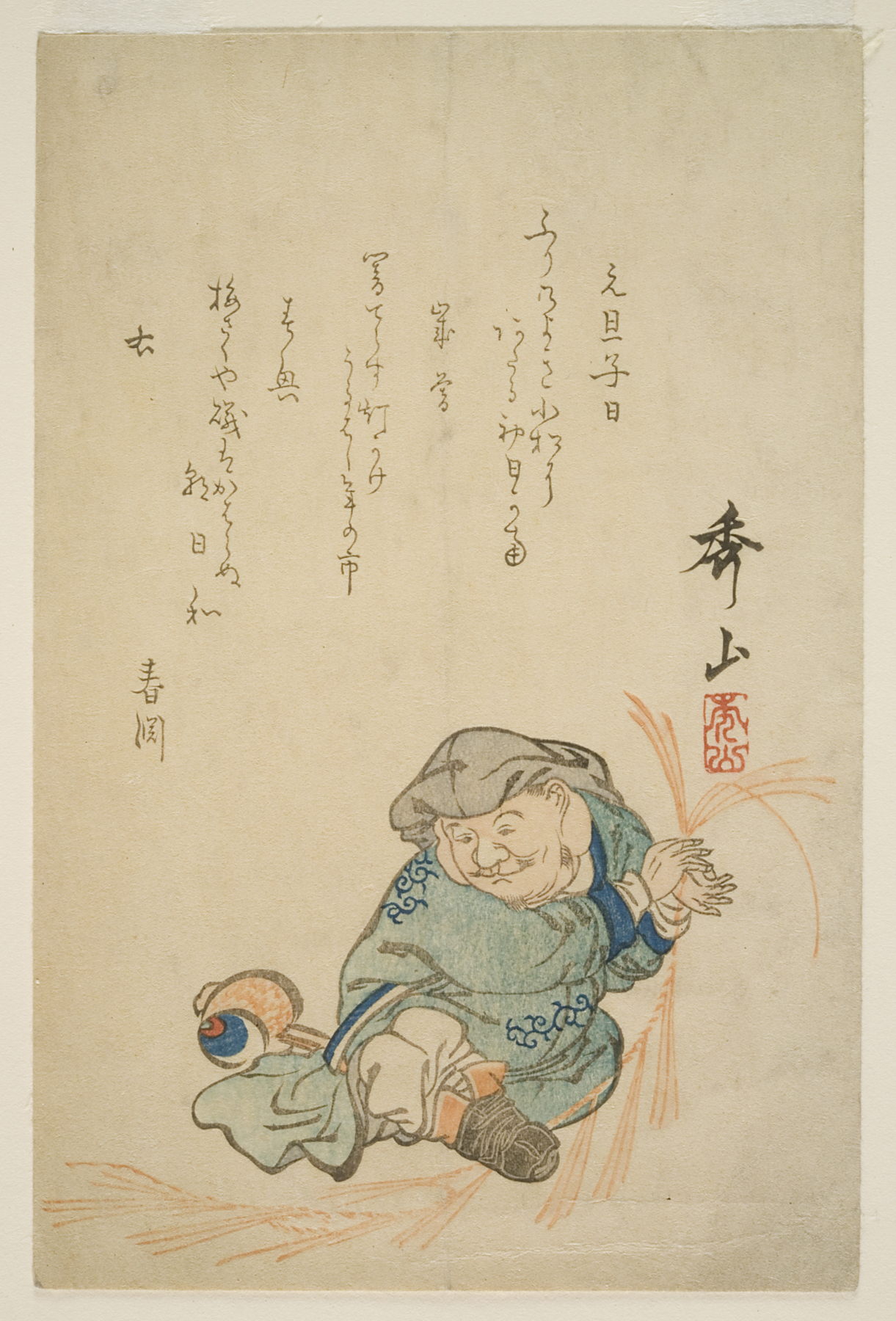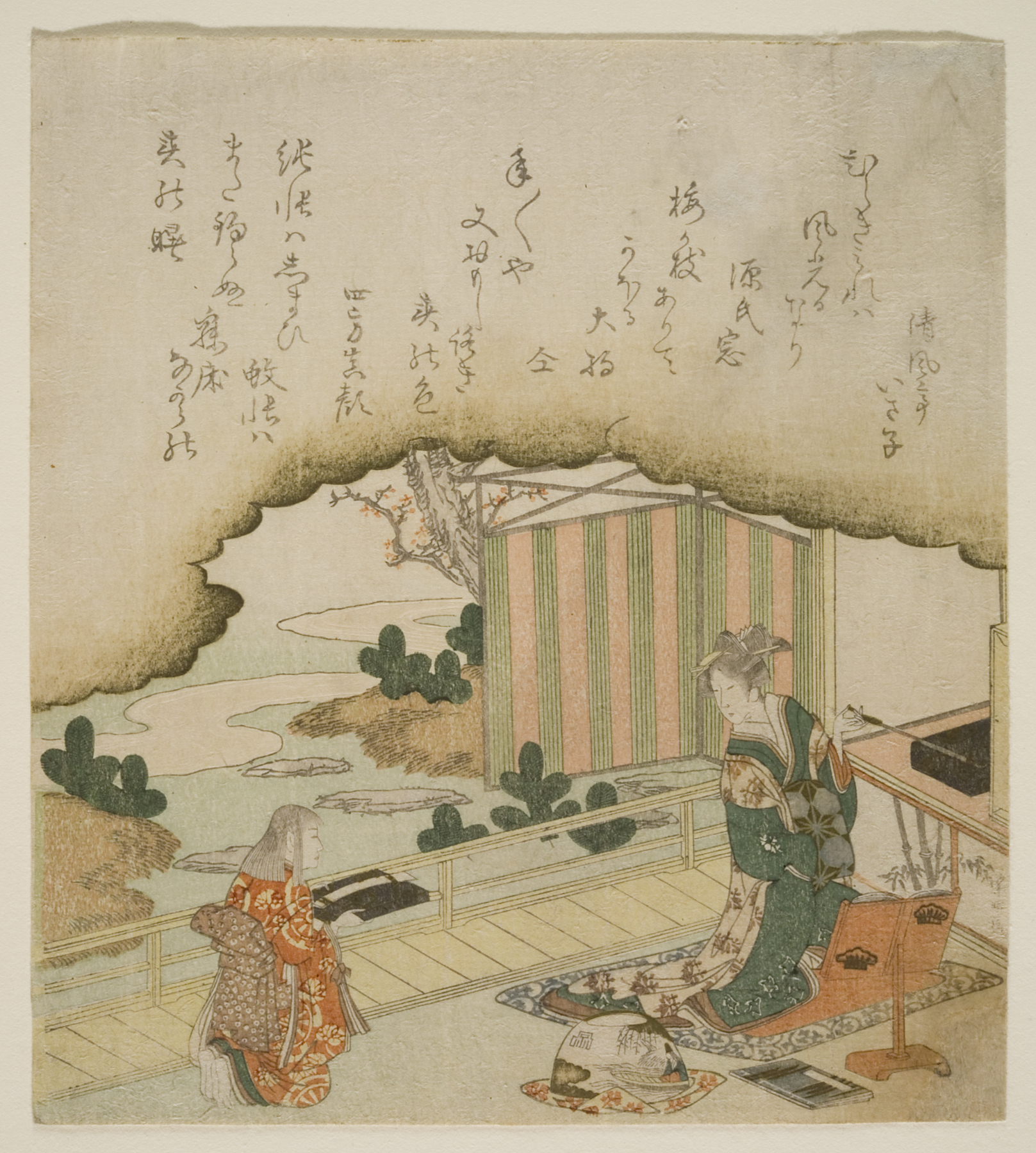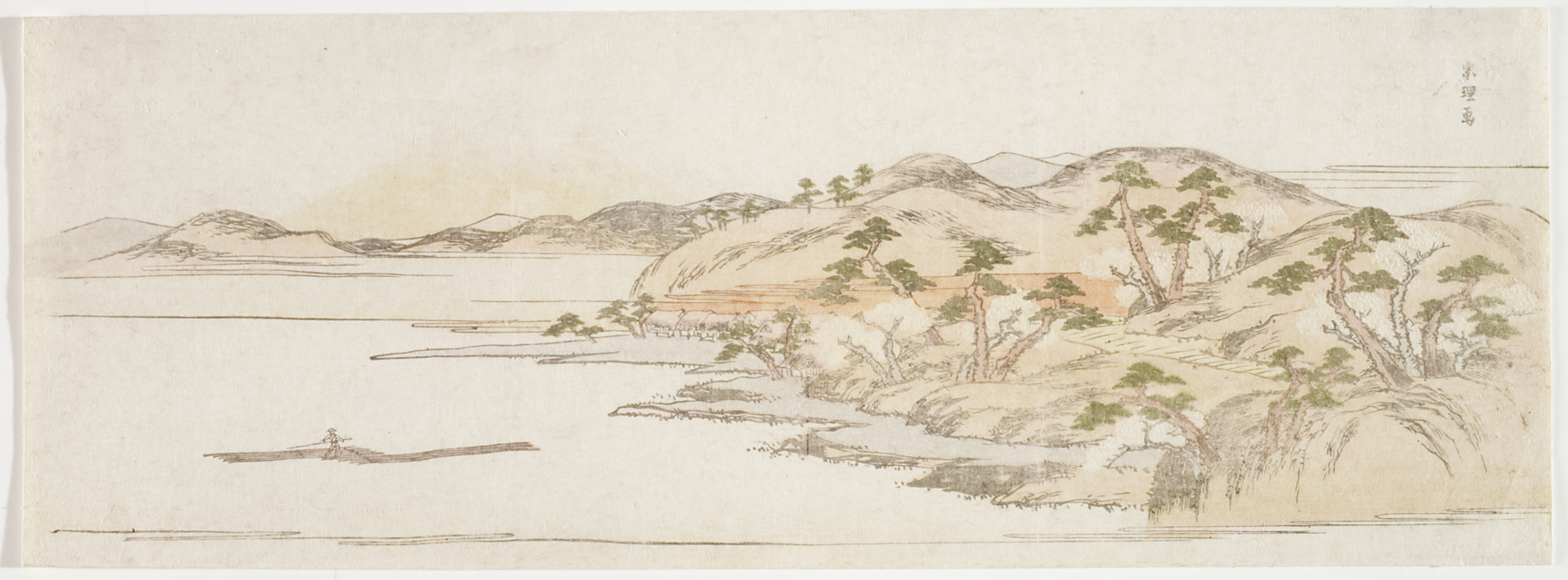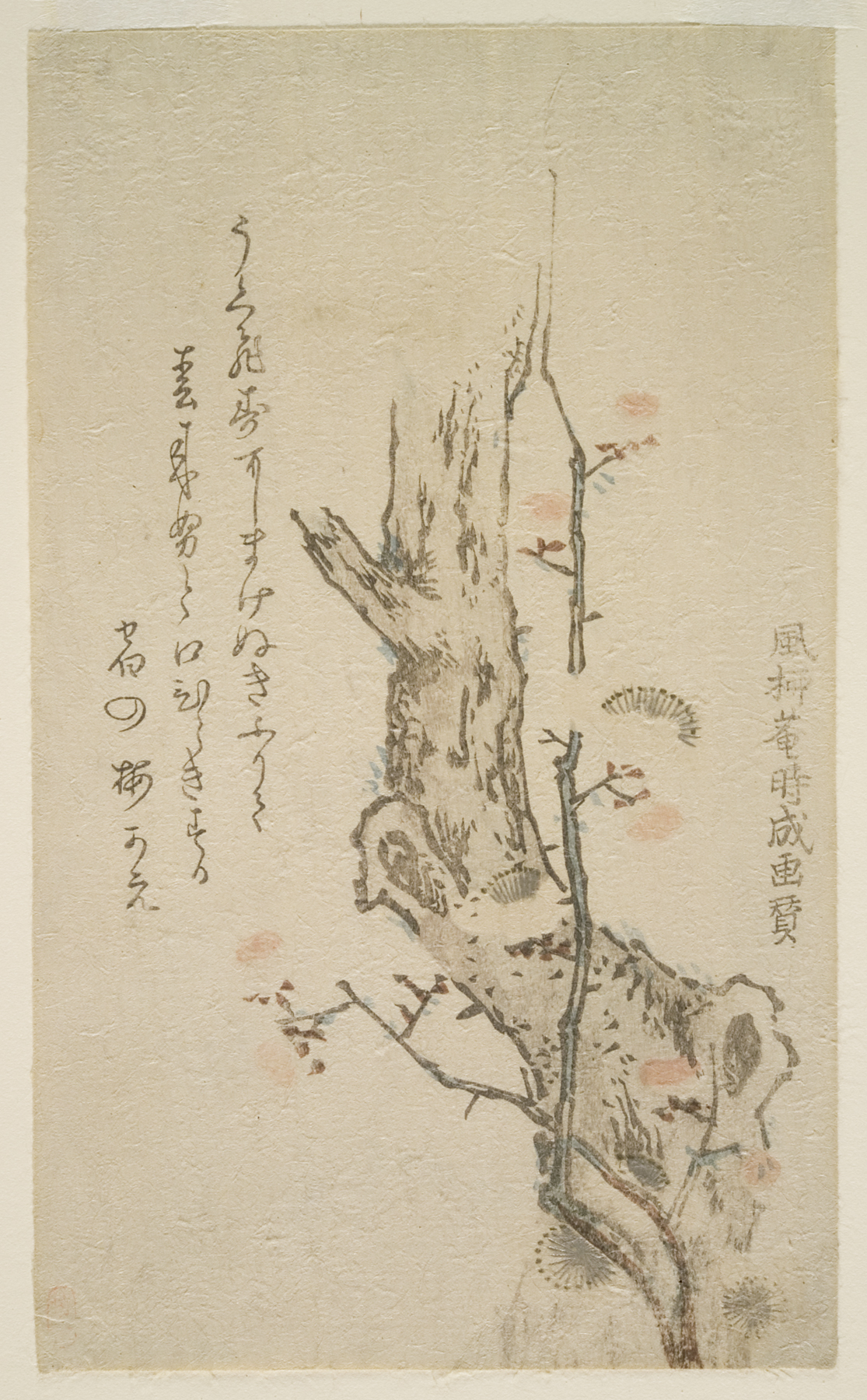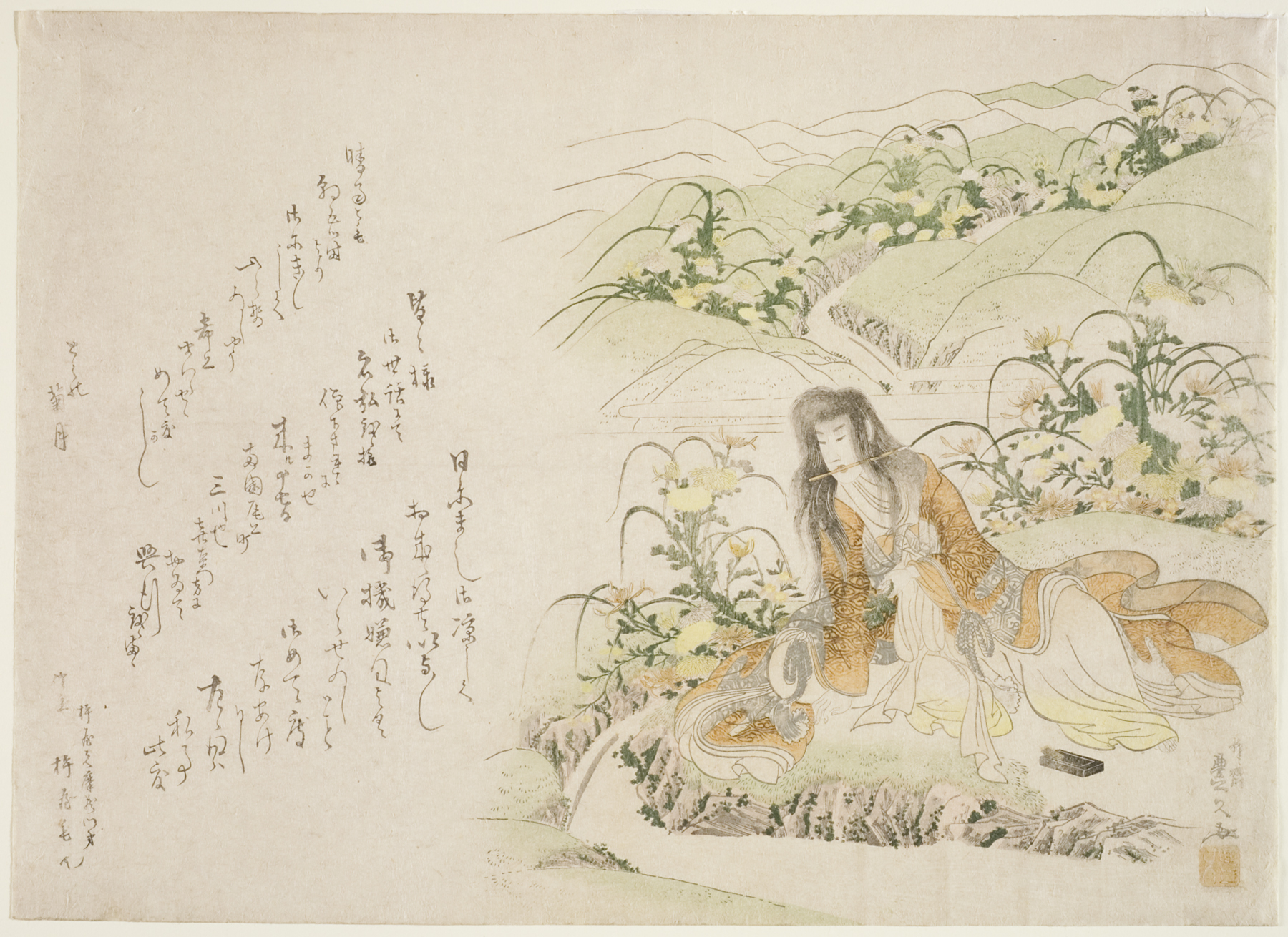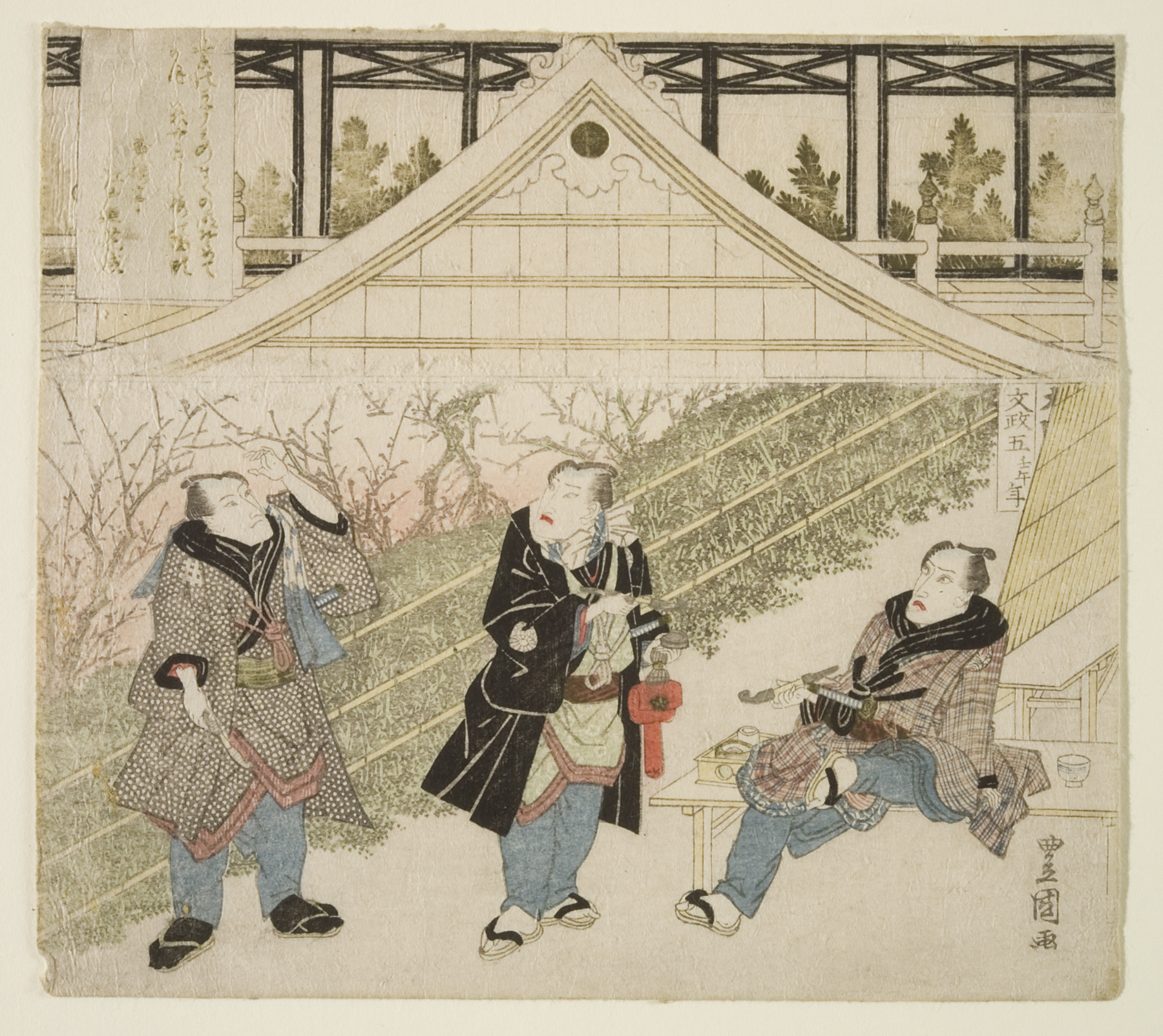Surimono Prints from the Collection of the Spencer Museum of Art
Exhibition
Exhibition Overview

Surimono Prints from the Collection of the Spencer Museum of Art
June 4, 1991–July 21, 1991
Riccar Art Museum, Tokyo, Japan
Works of art
Kōkintei Banzan
Suda no tsutsumi (Cherry Trees on the Embankment of the Sumida River),
circa late 1820s, Edo period (1600–1868)
Kita Busei; Tatekawa Emba II
badger and rabbit,
1831, Edo period (1600–1868)
Issai Chikara
brocade pouch and wrapper,
1806, Edo period (1600–1868)
Yabu Chōsui
standing screen,
1861, Edo period (1600–1868)
Keisai Eisen
tea wisk, tea scoop, and miniature plum tree,
circa early 1820s, Edo period (1600–1868)
Keisai Eisen
fan paintings and camellias,
circa early 1820s, Edo period (1600–1868)
Keisai Eisen
boys chasing a woman with sticks,
1823, Edo period (1600–1868)
Keisai Eisen
women preparing ornaments for New Year,
mid 1820s, Edo period (1600–1868)
Keisai Eisen
two young women writing first calligraphy of New Year,
mid 1820s, Edo period (1600–1868)
Keisai Eisen
Kōsagi and a courtier at Yōrō Waterfall,
mid 1820s, Edo period (1600–1868)
Keisai Eisen
painted screen and New Year's offerings,
mid 1820s, Edo period (1600–1868)
Keisai Eisen
girl and boy with printed game board and Pekinese dog,
1826, Edo period (1600–1868)
Keisai Eisen
an ōtsu painting of a rat,
1828, Edo period (1600–1868)
Keisai Eisen
child leading a woman on an ox,
1829, Edo period (1600–1868)
Keisai Eisen
women sewing and ironing,
circa late 1820s, Edo period (1600–1868)
Keisai Eisen
Ushiwaka and Sōjōbō,
1829, Edo period (1600–1868)
Keisai Eisen
Benkei and Shizuka,
1829, Edo period (1600–1868)
Yashima Gakutei
Hōjō Tokiyori,
circa 1820, Edo period (1600–1868)
Yashima Gakutei
Yōkihi sakura (Yang Kuei-fei),
early 1820s, Edo period (1600–1868)
Yashima Gakutei
woman and boy with votive painting,
early 1820s, Edo period (1600–1868)
Yashima Gakutei
Ushiwaka and Sōjōbō,
1820s, Edo period (1600–1868)
Yashima Gakutei
Muneyuki ga rōtō tora o utsu (Muneyuki's soldier slays a tiger),
circa late 1820s, Edo period (1600–1868)
Genjudo
two painted fans,
circa 1810s, Edo period (1600–1868)
Matsukawa Hanzan
a gilded wooden model of Daikoku's magic mallet,
circa early 1860s, Edo period (1600–1868)
Utagawa Hiroshige
sparrow on rose branch,
late 1830 or early 1840s, Edo period (1600–1868)
Utagawa Hiroshige II
old man presenting jar to court lady,
1856, Edo period (1600–1868)
Totoya Hokkei
courtesan, client, and entertainer,
1811, Edo period (1600–1868)
Totoya Hokkei
street dancers,
1811, Edo period (1600–1868)
Totoya Hokkei
still life,
1813, Edo period (1600–1868)
Totoya Hokkei
Ebisu,
circa mid 1810s, Edo period (1600–1868)
Totoya Hokkei
Hotei,
circa mid 1810s, Edo period (1600–1868)
Totoya Hokkei
Samisen case covered with blue cloth,
circa mid 1810s, Edo period (1600–1868)
Totoya Hokkei
Qingao riding a carp,
circa 1820, Edo period (1600–1868)
Totoya Hokkei
well and plum tree,
early 1820s, Edo period (1600–1868)
Totoya Hokkei
Hikizome yoshi (A Good Day to Start Playing the Samisen),
1820s, Edo period (1600–1868)
Totoya Hokkei
Ibori yoshi (A Good Day to Dig a Well),
early 1820s, Edo period (1600–1868)
Totoya Hokkei
Do (Earth),
1820s, Edo period (1600–1868)
Totoya Hokkei
Gōmō (Wu Meng); woman washing her face,
circa late 1820s, Edo period (1600–1868)
Totoya Hokkei
Yamanba (The Mountain Woman),
mid-late 1820s, Edo period (1600–1868)
Totoya Hokkei
Ryūhō hakuju o kiru (Liu Bang kills the white serpent),
1832, Edo period (1600–1868)
Totoya Hokkei
King Raryō,
circa early 1830s, Edo period (1600–1868)
Totoya Hokkei
woman with kettle and rice crackers,
1830s, Edo period (1600–1868)
Totoya Hokkei
two fans and a bowl of Adonis flowers,
early or mid 1830s, Edo period (1600–1868)
Totoya Hokkei
Adonis flowers and three fans,
1839, Edo period (1600–1868)
Teisai Hokuba
Yoki takimono takite hitori fushitaru (To burn fine incense and sleep alone),
circa late 1810s, Edo period (1600–1868)
Katsushika Hokusai
courtesan at window,
circa late 1790s, Edo period (1600–1868)
Katsushika Hokusai
chrysanthemum display,
1799, Edo period (1600–1868)
Katsushika Hokusai
Microscope,
circa 1800–1805, Edo period (1600–1868)
Katsushika Hokusai
Mariko,
1804, Edo period (1600–1868)
Katsushika Hokusai
Fujieda,
1804, Edo period (1600–1868)
Katsushika Hokusai
Hōraiji shunkei (Spring view of Horai Temple),
1804, Edo period (1600–1868)
Katsushika Hokusai
Okazaki,
1804, Edo period (1600–1868)
Katsushika Hokusai
Miya,
1804, Edo period (1600–1868)
Katsushika Hokusai
cranes in pine tree,
circa 1805, Edo period (1600–1868)
Katsushika Hokusai
woman on Nihon bridge,
1819, Edo period (1600–1868)
Katsushika Hokusai
Tomoe Gozen and Xiang Yu,
1820, Edo period (1600–1868)
Katsushika Hokusai
Benkei and Chinese princess,
1820, Edo period (1600–1868)
Katsushika Hokusai
Ōiko and Fan Kuai,
1820, Edo period (1600–1868)
Katsushika Hokusai
Kinutagai (The Pounding Block Shell),
1821, Edo period (1600–1868)
Katsushika Hokusai
Monoaragai (The Turban Shell),
1821, Edo period (1600–1868)
Katsushika Hokusai
Sōmayaki (Ceramics from Sōma),
1822, Edo period (1600–1868)
Katsushika Hokusai
Kami (Paper),
1823, Edo period (1600–1868)
Katsushika Hokusai
Daikoku lifting a rice bale,
1825, Edo period (1600–1868)
Katsushika Hokusai
Isse ichidai kai (a retirement gathering),
1830, Edo period (1600–1868)
Kakutei
theater announcer addressing audience,
1818, Edo period (1600–1868)
Yokoyama Kazan
couple by willow trees,
circa mid 1820s, Edo period (1600–1868)
Yokoyama Kazan
Minister Hong bows to the Heavenly Teacher,
early 1890s, Edo period (1600–1868)
Ichikawa Kiyū
child practicing calligraphy,
circa 1860s, Edo period (1600–1868)
Keisai Eisen
Susanoo no mikoto preparing to slay an eight-headed dragon,
1832, Edo period (1600–1868)
Utagawa Kunisada
Ichikawa Danjūrō VII and Segawa Kikunojō V,
1821, Edo period (1600–1868)
Utagawa Kunisada
Ichikawa Danjūrō VII as Soga no Gorō,
1821 or 1822, Edo period (1600–1868)
Utagawa Kunisada
Ichikawa Danjūrō VII and Segawa Kikunojō V,
1823, Edo period (1600–1868)
Utagawa Kunisada
actors Ichikawa Danjūrō VII and Bandō Zenji,
1823, Edo period (1600–1868)
Utagawa Kunisada
Ichikawa Danjūrō VII as a travelling pilgrim (see also 0000.1492),
circa 1823, Edo period (1600–1868)
Utagawa Kunisada
Segawa Kikunojō V drawing sword,
circa 1823, Edo period (1600–1868)
Utagawa Kunisada
The actor Onoe Kikugorō III,
circa 1823, Edo period (1600–1868)
Utagawa Kunisada
woman combing a tress of hair,
circa 1820s, Edo period (1600–1868)
Utagawa Kunisada
The actor Ichikawa Danjūrō VII in a Shibaraku role,
circa mid 1820s, Edo period (1600–1868)
Utagawa Kunisada
Ichikawa Danjūrō VII and Bandō Mitsugorō III,
1827, Edo period (1600–1868)
Utagawa Kunisada
actor Ichikawa Danjūrō VII as Fuwa Banzaemon,
1827, Edo period (1600–1868)
Utagawa Kunisada
Ichiikawa Danjūrō VII and Iwai Hanshirō V,
circa 1827, Edo period (1600–1868)
Utagawa Kunisada
courtesans and attendants under a plum tree,
circa 1820s–1830s, Edo period (1600–1868)
Utagawa Kunisada
Lu Chi-shen holding an iron staff,
circa early 1830s, Edo period (1600–1868)
Utagawa Kuniyasu
Kuronushi; a scene from the play Kagamiyama,
late 1810s–early 1820s, Edo period (1600–1868)
Utagawa Kuniyoshi
Iwai Hanshirō V seated by a brazier,
circa 1825–1835, Edo period (1600–1868)
Utagawa Kuniyoshi
Ichikawa Ebizō V (Danjūrō VII),
mid 1830s, Edo period (1600–1868)
Madonoya
landscape with bridges and cherry trees,
circa 1830s, Edo period (1600–1868)
Suzuki Nanrei
pony dancer,
1813, Edo period (1600–1868)
Yoshiki Rakuzan
Chinese scholar with goblet of wine,
1862, Edo period (1600–1868)
Utagawa Sadakage I
Lady Yugao,
early 1820s, Edo period (1600–1868)
Utagawa Sadakage I
Mokusei (wood),
late 1820s, Edo period (1600–1868)
Utagawa Sadakage I
Ichikawa Ebizō V (Danjūrō VII) as Matsunaga Daizen,
1832, Edo period (1600–1868)
Utagawa Sadakage I
Segawa Kikunojō V as Yukihime,
1832, Edo period (1600–1868)
Umezawa Sessei
well and plum tree,
1861, Edo period (1600–1868)
Ueno Setsugaku
poppies,
1862, Edo period (1600–1868)
Yanagawa Shigenobu
geisha with iris crown,
early 1820s, Edo period (1600–1868)
Yanagawa Shigenobu
puppy with kite and ball,
1826, Edo period (1600–1868)
Yanagawa Shigenobu
young woman with painted fan,
circa late 1820s, Edo period (1600–1868)
Ryūryūkyo Shinsai
Kintoki at well,
1803, Edo period (1600–1868)
Ryūryūkyo Shinsai
courtesan and Kamuro beside a petting ox,
1805, Edo period (1600–1868)
Ryūryūkyo Shinsai
poem cards with portraits of modern kyoka poets,
circa 1805, Edo period (1600–1868)
Ryūryūkyo Shinsai
Oni ni kanabō (An Iron Staff Against a Devil),
mid 1800s, Edo period (1600–1868)
Ryūryūkyo Shinsai
kite of the strong man, Asaina,
circa 1810s, Edo period (1600–1868)
Ryūryūkyo Shinsai
Niwatori Muko (The Rooster Bridegroom),
1813, Edo period (1600–1868)
Ryūryūkyo Shinsai
child practicing calligraphy,
1810s, Edo period (1600–1868)
Ryūryūkyo Shinsai
bird's eye view of the Sumida River,
circa late 1810s, Edo period (1600–1868)
Ryūryūkyo Shinsai
poet and plum tree,
circa late 1810s, Edo period (1600–1868)
Ryūryūkyo Shinsai
bolts of fabric,
circa late 1810s, Edo period (1600–1868)
Ryūryūkyo Shinsai
folded robe and crown,
1818, Edo period (1600–1868)
Ryūryūkyo Shinsai
Miyuke, Nowake, Fujibakama (the royal outing, the typhoon, purple trousers),
1819, Edo period (1600–1868)
Kubo Shumman
shell work screen and box of food from Enoshima,
1809, Edo period (1600–1868)
Kubo Shumman
Artame ne juni no tebako narabi ni kushi (casket and combs),
1814, Edo period (1600–1868)
Kubo Shumman
Wakaki onokodomo warawabe nado to mari koyumi nado o mote asobitamau (she played with little boys with balls and small bows),
1810s, Edo period (1600–1868)
Kubo Shumman
actor Sawamura Tanosuke II as the courtesan Shiratama,
circa mid 1810s, Edo period (1600–1868)
Katsukawa Shun'ei
long-tailed turtles,
late 1810s, Edo period (1600–1868)
Yoshimi Shūri
Kara monogatari (Stories of China),
circa late 1810s, Edo period (1600–1868)
Matsuo Shūzan
Daikoku plaiting a rope,
circa 1860s, Edo period (1600–1868)
Hishikawa Sōri
woman and child,
circa 1800–1805, Edo period (1600–1868)
Hishikawa Sōri
spring landscape,
circa 1805, Edo period (1600–1868)
Fūryūan Tokinari
plum tree in blossom,
circa early 1800s, Edo period (1600–1868)
Toyohisa II
Kikujidō seated by a stream,
1830, 9th month, Edo period (1600–1868)
Utagawa Toyokuni I
Ichikawa Danjūrō VII and two other actors (actors viewing plum blossoms),
1822, Edo period (1600–1868)
Uun
telescope,
circa 1805–1810, Edo period (1600–1868)
